

Fourteen Against One? Doesn’t Really Seem Fair.
A system on a chip (SoC), netX integrates all the fieldbus and Ethernet connectivity with security you need in one compact, efficient and cost-effective design.
Our netX network controllers feature a wide range of protocol support built directly into the chip, along with integrated functions for encoders, motion control, I/O, network co-processor and more. The platform is based on a 32-bit, 200-megahertz CPU ARM 926 with 200 MIPs computing power, achieving next-generation control, power and versatility. For enhanced functionality, on-chip peripherals include two EnDat, two BiSS and two SSI interfaces.
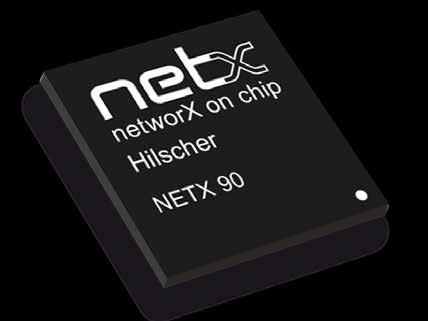
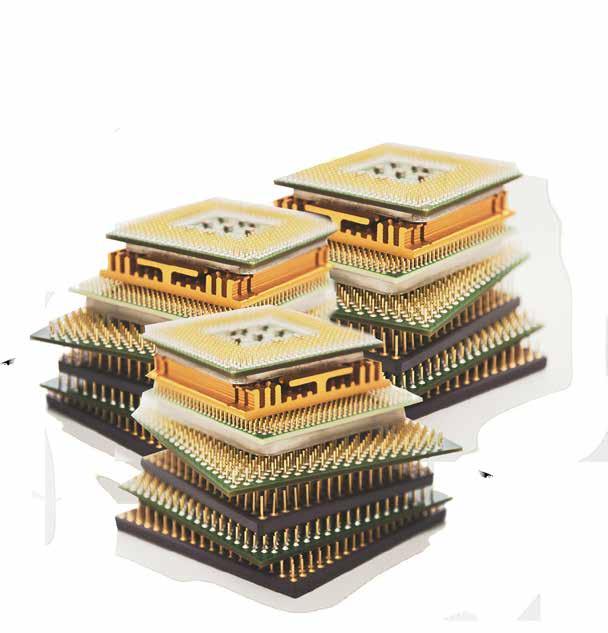
Your benefits include:
• Unsurpassed connectivity
• Faster design times
• Application flexibility
• Lower costs
Real-time Ethernet Systems
• EtherCAT
• EtherNet/IP
• PowerLink
• PROFINET
• Sercos III
• Modbus/Open Modbus TCP
• CC-Link IE Field Basic
• MQTT
• OPC UA
• IEEE-1588
Fieldbus Systems
• CCANopen
• CC-Link (Slave)
• DeviceNet
• PROFIBUS
Other Systems
• IO-Link TCP/IP
Future Proof
• EtherNet/IP CIP Security
• PROFINET Security
• Secure Boot
Learn more from Hilscher call 1.630.505.5301, email: info@hilscher.us or visit www.hilscher.com
©2022 Hilscher North America, Inc. All trademarks are the properties of their respective companies.GET CONNECTED…
50 Years of Ethernet
It’s a big year for Ethernet as it celebrates its 50th anniversary.
According to Wikipedia, "Ethernet was developed at Xerox PARC between 1973 and 1974. It was inspired by ALOHAnet, which Robert Metcalfe had studied as part of his PhD dissertation. The idea was first documented in a memo that Metcalfe wrote on May 22, 1973, where he named it after the luminiferous aether once postulated to exist as an 'omnipresent, completely-passive medium for the propagation of electromagnetic waves.' In 1975, Xerox filed a patent application listing Metcalfe, David Boggs, Chuck Thacker, and Butler Lampson as inventors."
Industrial Ethernet, the use of Ethernet in an industrial environments with protocols that provide determinism and real-time control, has been around for half of those fifty years. Protocols for industrial Ethernet including EtherCAT, EtherNet/IP, PROFINET, POWERLINK, SERCOS III, CC-Link IE, and Modbus TCP have formed the basis of automation and control networking worldwide
In this issue of the Industrial Ethernet Book, founded as a publication in 1999, we celebrate the 50 years of Ethernet by looking at the future of Industrial Ethernet which some will say has never been brighter.
Check out our cover story (page 6) to see what industry experts are saying about the future of Industrial Ethernet technology. Here is just one example of what industry leaders have to say.
“Industrial Ethernet will dominate the automation connectivity market for the foreseeable future given its high speed, robustness, and extensibility,” Dr. Al Beydoun, ODVA President and Executive Director, told IEB.
The Ethernet Alliance, a leading industry voice of Ethernet, is celebrating technology’s 50 years of innovation in 2023 with cutting-edge multivendor demo, new Ethernet roadmap, and OFCnet participation. See the article starting on page 17 to learn more about how Ethernet is continuing to evolve.
And then starting on page 24, we present our Ethernet Solutions Showcase with a series of technical articles on how networking technology is continuing to make an impact in the factory. The combination of SPE, TSN and the growing need for IT/OT convergence are just some of the reasons to be optimistic about the future.
According to Mike Willett, Network Engineer at Red Lion Controls, “Industrial Ethernet is evolving at a fast pace. Not only is there a greater need to conform to the requirements of the IT network environment, but things are always changing and the industrial network has more and more requirements.”
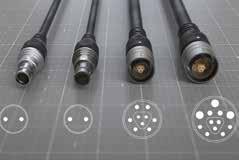
Al Presher
Industrial Ethernet Book
The next issue of Industrial Ethernet Book will be published in July/August 2023. Deadline for editorial: July 12, 2023 Advertising deadline: July 12, 2023
Editor: Al Presher, editor@iebmedia.com
Advertising: info@iebmedia.com
Tel.: +1 585-598-6627
Free Subscription: iebmedia.com/subscribe

EtherCAT: almost 60 million nodes and exponential growth

Excluding modular I/O devices, ETG counts 59.1 million nodes, with recent growth being particularly impressive. Since 2014, growth has been exponential, with 18.4 million nodes added in 2022 alone.
For the first time since EtherCAT was introduced 20 years ago, the EtherCAT Technology Group (ETG) is publishing node figures. Excluding modular I/O devices, ETG counts 59.1 million nodes, with recent growth being particularly impressive. Since 2014, growth has been exponential, with 18.4 million nodes added in 2022 alone.
These figures include EtherCAT chips sold in a respective year, though this does not include the chips for Bus Terminals. Thus, a modular I/O station counts as a single node, even if it consists of many more EtherCAT Bus Terminals.
"The chip numbers are accurate figures, but there is a certain time lag: not every chip becomes an installed EtherCAT device in the same calendar year", said Martin Rostan, Executive Director of the EtherCAT Technology Group, on the counting method.
Rostan is also in charge of all EtherCAT licensing, on the behalf of Beckhoff Automation. EtherCAT, similar to CAN, requires only the chip manufacturer license their hardware, the cost of which is included in the purchase of the EtherCAT chips. Beckhoff Automation finances the EtherCAT Technology Group with the chip license income, and membership in the world’s largest fieldbus association is free of charge.
"Because we don't know the exact unit numbers of FPGA IP core-based implementations, we have held back on publishing node numbers so far," Rostan said. "But the reported unit numbers of the
current 12 EtherCAT chip vendors are now so large that any possible fuzziness in estimating FPGA numbers is no longer a factor: they enter the totals at less than 10%. We have also included multiprotocol chips in proportion to the market share of the protocols. Thus, on the one hand, the figures are based on very reliable sources, and on the other hand, they are determined very conservatively: there are probably significantly more EtherCAT devices."
Except for 2019, where EtherCAT unit numbers were also unable to escape the sideways trend of the automation market, growth has been exponential for several
years. "Three years ago, we still believed in an upward outlier, but now the trend has solidified: the exponential growth continues," said Rostan.
"The Asian market is developing the fastest, especially China. But EtherCAT is also making better and better progress in North America. And in Europe, where EtherCAT has its origins, EtherCAT has been going strong for quite some time," he added.
News report by EtherCAT Technology Group
Visit Website
EtherNet/IP Process Device Profile Support
ODVA has announced that process device profiles have been added to the EtherNet/IP specification.
Process device profiles provide a standard format for process variables and diagnostics across an array of devices for smoother vendor interoperability and easier DCS and PLC data integration from EtherNet/IP-enabled field devices. Device profiles are available for Coriolis flow, electromagnetic flow, vortex flow, standard pressure, and scaled pressure devices. Process end users can now take advantage of EtherNet/IP devices with better communication of critical diagnostics such as NAMUR NE 107 status signals, and improved alignment with the Process Automation Device Information Model (PA-DIM).
EtherNet/IP profiles are made up of process measurement value objects for variables such as current pressure, level, flow, etc., process totalized value objects that track cumulative data totals such as total flow, and process device diagnostics objects that enable plant operators and maintenance personnel easier access to additional device and process status information. Process device profiles help convert sensor signals and actuator positions into valuable information that enables action to be taken to improve product quality and operational efficiency. Process device profiles help evaluate the reliability of the measuring
signal and aid in preventing plant shutdowns by identifying premature device failures. As an example, the process totalized value object can track total device usage and device health can be inferred from the process measurement value and diagnostics objects. This allows users to shift from time-based maintenance to condition-based maintenance, which can reduce unnecessary maintenance costs and potential downtime.
News report by ODVA.
Complete with multi-functional I/Os: the TwinCAT CX7000 small controller
480 MHz ARM processor
Support the most versatile applications:
safety technology
PCB solutions
motion control
explosion protection
EtherCAT
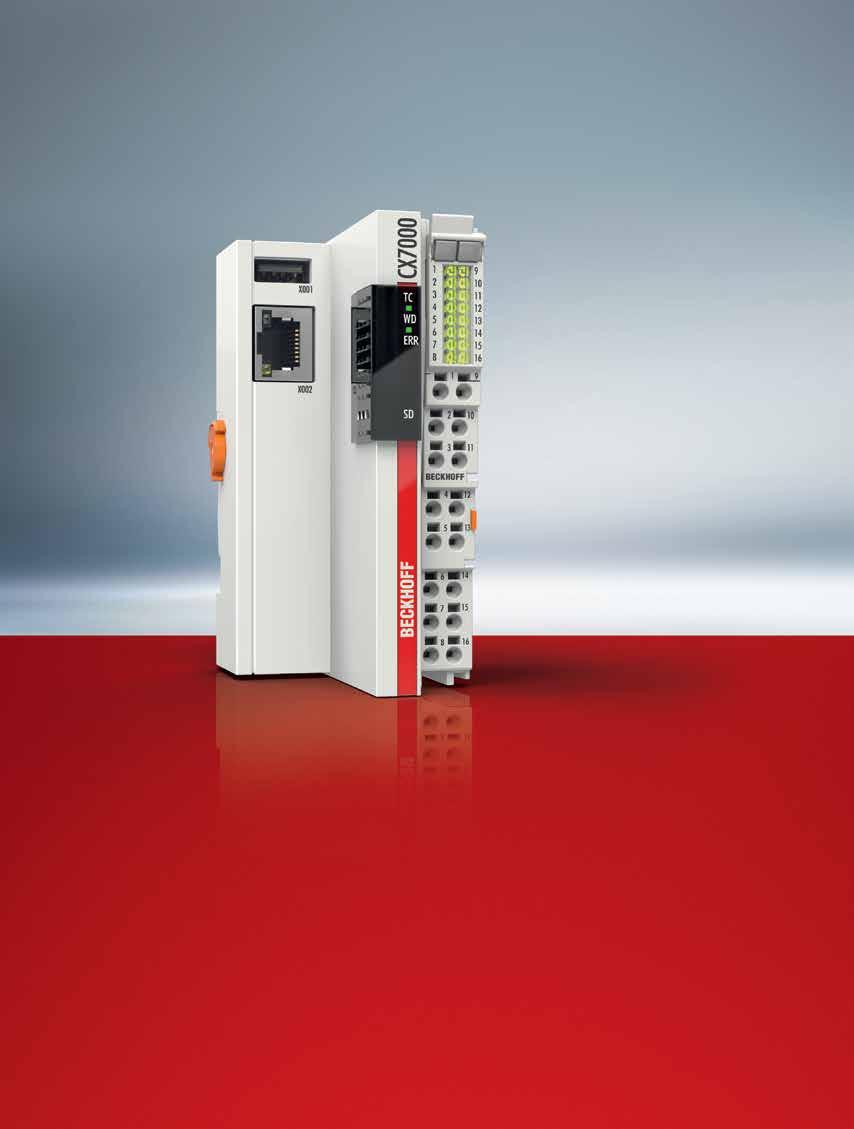
The CX7000 Embedded PC opens up the TwinCAT 3 world of efficiency and high performance to small controllers too, thus further enhancing the scalability of PC-based control technology from Beckhoff –ranging from mini-PLCs to many-core Industrial PCs. Equipped with a 480 MHz processor and 12 configurable multi-functional I/Os, the CX7000 offers an attractive price-performance ratio as well as excellent flexibility: the CX7000 can be expanded as desired using Bus Terminals or EtherCAT Terminals.
ARM Cortex™-M7 processor (32-bit, 480 MHz)
Compact dimensions: just 49 x 100 x 72 mm
Multi-functional I/Os allow variable use:
8 digital inputs, 24 V DC, type 3
4 digital outputs, 24 V DC, 0.5 A, 1-wire technology
fast counter input
encoder input
2 analog 0…10 V inputs
2 PWM outputs
and Industrial Ethernet
Looking at the future of Industrial Ethernet technology
Join us in celebrating 50 years since Bob Metcalfe invented Ethernet technology, but "industrialized" Ethernet is also celebrating its own milestone after passing the quarter century mark. So IEB reached out to industry experts for their perspective on the future of Industrial Ethernet and what to expect moving ahead.
Machine Learning
THE FUTURE OF INDUSTRIAL ETHERNET technology may have never been stronger than it is right now. Fifty years after Ethernet started to make its mark, the industrial version to Ethernet is moving past the quarter century milestone with a solid foundation and perhaps an even brighter future.
In this special report, the Industrial Ethernet Book reached out to industry experts to gain their insights into the megatrends driving Industrial Ethernet technology, new applications and the challenges facing automation engineers.
Industrial Ethernet Dominant
Enabling technology for IT-OT convergence and cloud computing solutions.
“Industrial Ethernet will dominate the automation connectivity market for the foreseeable future given its high speed, robustness, and extensibility,” Dr. Al Beydoun, ODVA President and Executive Director, told IEB. “The trend of increased data flow from field devices to the edge or cloud and back
for production optimization will continue to help manage growing cost, quality, flexibility, and output pressures. Ethernet can also aid in enabling IT/OT convergence through the usage of the TCP/IP Suite, object-oriented programming, and use commercial off the shelf hardware with communication networks like EtherNet/IP.”
Beydoun said that, as Artificial Intelligence (AI) and Machine Learning (ML) find more applications to solve in the industrial space, there will be increased value in having Ethernet all the way down to the lowest level of automation devices. Single Pair Ethernet will be a critical enabler of connecting simple, low-cost devices to the network to enable more effective optimizable feedback loops that will help improve key metrics like OEE. Additional focus on sustainability will also drive the need to make data-driven business decisions better and faster than ever, and these improvements will be easier to accomplish with the increased bandwidth and flexibility of Ethernet. He added that electronics are also poised to migrate from simply being a phone in the pocket of an engineer or maintenance worker
connecting simple, low-cost devices to the
to becoming a wearable that will provide the most value when directly linked into the plant-wide Ethernet network.
Impact on smart manufacturing

“Industrial Ethernet networks that are media independent, such as EtherNet/IP, are able to take advantage of wireless connectivity enabled by 5G and Wi-Fi,” Beydoun said. “Automated Guided Vehicles (AGVs) that rely on wireless control are allowing for flexible production lines that can divert components to customization areas, remove a faulty product off the line, or change the order of completion depending on product demand and supply availability. Additionally, private 5G networks can control not only AGVs and other robotics across large physical areas, but can also help to collect data from sensors across a plant to monitor device health and operation status.”
Future physical layer technologies such as Li-Fi, which uses modulated light for communication, will be able to withstand high electromagnetic interference and offer significantly increased speeds relative to
(ML) find more applications to solve in the industrial space, there will be increased value in having Ethernet all the way down to the lowest level of automation devices. Single Pair Ethernet will be a critical enabler of
network to enable more effective optimizable feedback loops that will help improve key metrics like OEE.” -- Dr. AlBeydoun, President and Executive Director. ODVA.
SOURCE:ISTOCK
INDUSTRY-LEADING SCALABLE ETHERNET. TIMED TO PERFECTION. ANALOG.COM/CHRONOUS





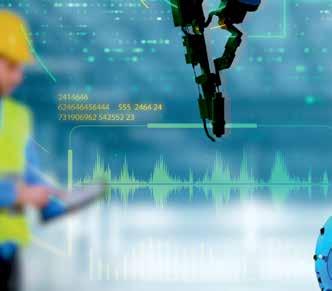



Delivering the Future of Time Sensitive Networking. Analog Devices´ Chronous™ family of Industrial Ethernet connectivity products enable best-in-class industrial automation solutions for the connected factory of tomorrow. ADI Chronous physical layer devices and embedded switches offer industry´s lowest latency and power for the highest level of determinism and synchronization in high-performance factory, process and motion control applications.
Turn your vision of the connected factory into reality. Learn more and visit analog.com/chronous

Wi-Fi. Communication networks that are media independent, rely on IEEE 802.3 standards, and are cooperating across standard development organizations to improve the end user experience will be best prepared to take advantage of new technologies such as Li-Fi.
Beydoun said that ODVA has been collaborating with leading standards development organizations on a number of initiatives - including security through the Industrial Ethernet Security Harmonization Group (IESHG), TSN testing through the “TIACC” TSN Industrial Automation Conformance Collaboration), energy management through the “Power Consumption Management” group, and more - to ensure that EtherNet/IP is best prepared for the future of automation.
Additionally, as AI and ML continue to take up bandwidth on the network, it’s also important to have a lightweight network that doesn’t add an unnecessary burden, which EtherNet/IP offers since it was developed in a time with far less computing and transport resources. It’s also important for a communication network to be able to meet broad group of needs, which EtherNet/ IP accomplishes via networks extensions for safety, security, motion, time synchronization, and energy efficiency, versus being focused on a single solution/benefit.
Industrial Ethernet technology
Beydoun singled out Single Pair Ethernet as a technology to watch in the future in terms of its impact on industrial applications and IIoT initiatives.
“Single Pair Ethernet (SPE) is a groundbreaking enhancement to Ethernet that enables the last mile of connectivity to the smallest and simplest of devices,” Beydoun stated. “The path to digitalization will require
SPE to fully connect automation devices to the network at an acceptable cost and appropriate level of capability. SPE will open the door to reduced wiring, complexity, and increased data for both diagnostics and operational improvement. The Industrial Internet of Things (IIoT) will be realized as a result of SPE connecting both contactors and push buttons in cabinets as well as temperature, level, and flow sensors in the field. EtherNet/IP supports both in-cabinet resource-constrained device connectivity with SPE as well as Ethernet-APL for process applications.”
He added that security is also going to be a critical piece of taking IIoT to its full potential by ensuring that when devices are connected to Ethernet that the benefits of the additional data and remote connectivity are able to be taken advantage of without exposing unprotected assets to bad actors.
“While no security system is ever foolproof, multiple deterrents, known as a defense in depth architecture, will help make a target not worth the time and effort. These deterrents can include firewalls, approved listing, deep packet inspection, zones and conduits, and device level security. CIP Security offers device level security for EtherNet/IP as a last line of defense for critical automation applications where loss of life or limb, environmental disasters, or production shutdowns could occur. CIP Security is also available for resource-constrained devices,” he said.
IIoT and enterprise connectivity
Beydoun said that IIoT wouldn’t be able to offer the same benefits without the high bandwidth and shared IT architectures that Industrial Ethernet offers. Industrial Ethernet solutions such as EtherNet/IP share many of the underpinnings of standard Ethernet
including TCP/IP and can work across HTTP, FTP, SNMP, and DHCP to better connect the work cell to the broader infrastructure. This allows data to be transported more easily from the factory floor to the edge, Historian, MES, CMMS systems, and the cloud for analysis and action.
“The amount of data and the speed that it needs to be transported to be useful to improve processes has become possible at an acceptable cost as a result of Ethernet,” he said. “Industrial Ethernet solutions, such as EtherNet/IP, also offer many security features found in standard Ethernet that are leveraged for banking and other secure consumer transactions such as TLS and DTLS.
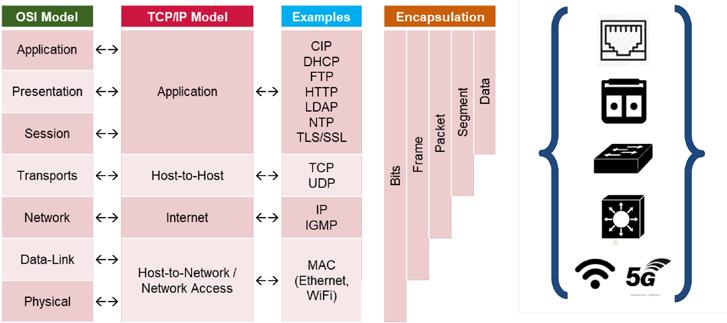
TLS is used for TCP (e.g. diagnostics) and DTLS for UDP (e.g. I/O) messaging. Together, TLS and DTLS allow for confidentiality through message encryption and via message integrity and authentication. Industrial Ethernet security options, like CIP Security for EtherNet/IP, make it safer to move data up from the plant floor and back down again for optimization.”
In fact, given the increasing speed and reliability with which data is being transported today via Industrial Ethernet, industry is currently looking at the viability of using virtual machines for control. This would still benefit from lightweight and reliable communication protocols, but could open up the door to hardware independence that would make updating control applications a much easier process on a large scale.
While this may not be possible for more time sensitive applications, it may prove to be advantageous in situations where update times are more spread out and/or devices can run independently if connection is lost temporarily.
Challenges for automation engineers
Controls engineers are tasked with keeping a very complex system up and running on a very demanding schedule. Downtime is never acceptable, regardless of how expensive lost production is per hour at a given plant. Industrial Ethernet allows for additional diagnostics to help troubleshoot issues in less time, which can be used in conjunction with sensor data to detect aberrations from normal operation in the edge or cloud to detect if premature device failure may be imminent. Additionally, asset management can be made easier with new capabilities like LLDP that can allow for automatic topology and device identification. Further, Ethernet makes
it easier to upgrade networks over time as new capabilities are needed on the plant floor given the higher capacity in terms of both devices and bandwidth. Device commissioning can also be done remotely at a rapid pace with Ethernet, which helps free up time for other value-added tasks.
“EtherNet/IP helps to provide the right data at the right time both by offering the Big 12 network diagnostics that expose data related to network health and device loading as well as process device profiles and an OPC UA companion specification that can provide operational information with the appropriate context,” Beydoun said. “Additionally, LLDP is supported by EtherNet/IP, which will help aid
in asset management as well as to prepare for Time Sensitive Networking (TSN). Furthermore, EtherNet/IP supports FDT, FDI, and xDS device descriptions to improve the experience of both device vendors and end users as well as to prepare for a future driven by Industry 4.0 and IIoT.”
Growth in key markets
Driven by data analytics, production efficiencies and sustainability/net zero initiatives.
According to Mike Berg, Senior Business Development Manager at Panduit Corporation, “we are seeing supply chain recovering and project activity increasing and expect continued demand and growth in structured cabling across manufacturing and warehouse automation.”
Berg said that the strongest growth is in Automotive, EV Battery, Semiconductor and Electronics, Medical Devices and Logistics segments.
“Our project demand is tied to an overall need to connect devices across the factory and is driven by three key factors: (1) companiesseeking better use of data analytics, (2) providing production efficiencies through use of automation, mobile robotics and IoT / IIoT devices across facilities. And (3) increasingly companies prioritizing sustainability and net zero initiatives, driving an adoption of technologies across plant floors that provide energy use efficiencies today and in the future greater use of renewable energy sources powering facilities,” Berg stated.
Impact in the factory
Industrial Ethernet products solutions are continuing to evolve and offer technical benefits that are impacting smart manufacturing operations.
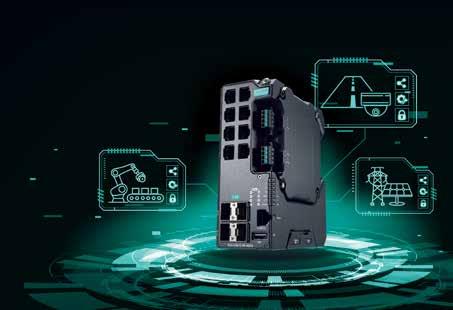
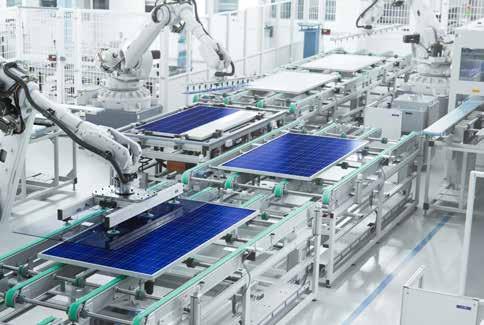
“As we help build that network infrastructure for facilities we find a much greater number of
Realizing Future-proof Networking with Moxa’s EDS-4000/G4000 Series
Industrial Managed Switches
› Industry-leading Network Security: IEC 62443-4-2 certified
› Unprecedented Performance: 90 W PoE and 2.5GbE connectivity
› Advanced Usability: Intuitive web GUI and rotatable power module
moxa-europe.com
IoT devices on plant floors, including Wireless Access Points (AP) that support devices and communications for real time data monitoring, deployed as a mesh across the facility; As well as a proliferation of cameras across facilities, for example a 1 million square foot automated warehouse can have over 3,500 cameras inside and outside the facility, for both security and equipment monitoring,” Berg said. “The impact is that industrial network designers are planning for a greater number of Category 6A cabling runs, which is preferred to support both wireless AP and device Power over Ethernet (PoE) demands of up to 99 watts (4PPoE). Demand for Cat 6A nodes will grow as WiFi 7 is adopted and looking further to the future there is potential increased demand for fiber connectivity to devices as well.”
Berg added that, from the controls perspective, the ability to use Ethernet across the factory floor is ever-increasing. The recent introduction of Single Pair Ethernet (SPE) is enabling greater data throughput (10Mbps) to sensor devices, longer distance reach (1000m) and power capability (using power over device line) enabling the latest process control systems using Ethernet APL and building automation systems using 10BASE T1-L technology.
These emerging applications will provide data from the edge effectively and better enable manufacturers pursuing real time data analytics and troubleshooting tools and brings the concept of digital twin to reality. The capability of the SPE technology also has
strong promise to reduce complexity deploying IIoT devices across plant floors, as more SPE devices become available.
He added that, for a very long time, it has been challenging for manufacturers to implement and use optical fiber across their facilities, limiting performance and distance capabilities in Industrial Ethernet applications. Distributing fiber across the facility required additional planning to ensure proper deployment and protection for reliability and extra cost for terminations in equipment that is only compatible within IT cabinets.
“As the market has evolved industrialized optical fiber solutions are now available, including versatile dielectric armored fiber cable which is strong enough to run across a facility using common j-hooks,” Berg said. “Terminations are now easier to deploy with DIN rail mountable boxes built to accept common fiber adapter panels and even fiber cassettes—enabling fiber to deploy within any controls cabinet while ensuring robust performance and long-term durability.”
“Industrial Ethernet has grown so strongly across plant floors because of its ability to simplify deployments, address real time data needs, and having versatility to enable future growth,” he added. “For automation engineers the core benefit of Industrial Ethernet is providing connectivity (and sometimes power as well) between automation systems with the least number of wires required. Choosing Ethernet simplifies network design and operation, eliminating the support and
translation of legacy networks used in OT networks. And with the ability to provide an enhanced suite of robust security measures found in IP networks.”
Emergence of SPE & TSN
Evolving toward a unification of industrial connectivity around Ethernet.
According to Peter Canty, System Applications Manager, Industrial Connectivity & Control Group at Analog Devices, the current state and outlook for Industrial Ethernet Solutions is that “all the tier 1’s in Process Control and Factory Automation are investigating the benefits of Industrial Ethernet with many now developing their first products to bring to market.”
“Single Pair Ethernet is being seeded into the market with Process Control being a strong first adopter. The long reach (>1km), the ability to support intrinsically safe applications and cost benefits of providing data and power on a single pair of wires are proving very attractive for both brown field and green field installations,” he said.
Canty added that industry organizations such as Profinet International, ODVA, Fieldcomm Group and SPE Alliance are providing strong advocacy for the unification of industrial connectivity around Ethernet. Display stands at tradeshows are now showing real products, not just prototypes.
“With IEEE now working towards a compatible 100BASE-T1L standard, the future for SPE in industrial applications is bright. The outlook is very positive as Time Sensitive Networking (TSN) also begins to gain traction and becomes the enabling connectivity technology to fully realize the Intelligent Edge,” he said.
Next generation technology
Canty said that next generation Industrial Ethernet switches are migrating to TSN to enable the transmission of real-time and non-real time data on the same cable. Barriers are being broken down across the OT network as the adoption of seamless edge to cloud ethernet connectivity removes gateways, data islands and silos. The goal of “Plug and Produce” interconnectivity is being realized as more vendors develop and test products at interoperability events.
“With 10BASE-T1L, Ethernet connectivity is realized over a single pair of wires. This provides several key benefits: substantial reduction in cost of cabling since only a single pair of wires is required instead of four. Connectors are simplified and easier to wire up, reducing material and installation costs. Compared to traditional Fieldbus technologies, Ethernet over 1km of cable enables the acquisition of orders of magnitude more data from remote instruments, thus providing more
in-depth knowledge about the edge of the network (pressure sensors, flow meters, depth gauges etc), enabling more actionable insights and intelligent management of the OT. And SPoE (Single Pair Power over Ethernet), as the name suggests, provides power to edge nodes over the same pair of wires as the data, providing further cost benefits, making Industrial Ethernet a more sustainable connectivity solution,” Canty stated.
He said that while 10BASE-T1L is an exciting new physical layer, the other major innovation is happening right now at layer2; new TSN functionalities are available for industrial
networks.
“TSN allows for better and more efficient network engineering and promises low latencies even in a loaded, converged network. All this without the need for proprietary hardand software solutions. And, yes, 10BASE-T1L is TSN compatible!”
IIoT and enterprise connectivity
“There are many applications that benefit from Industrial Ethernet – from motion control to flow metering. Yet, the basic principle that enables all these applications is the ability
to communicate in real-time with bounded latencies. In distributed automation systems the control loops are closed across the communication system. If communication fails by losing packets, by delaying packets or by introducing too much jitter, there is a negative effect on the quality of the control loop. This can be as catastrophic as utter failures of the entire system. Industrial Ethernet ensures bounded latencies even under heavy loads,” Canty said.
Moreover, it offers additional capabilities to achieve high availability systems by adding redundancies. Examples of these in the Profinet world include media redundancy using Ring topologies such as MRP and System redundancy such as S2 where two or more controllers can operate on the same data.
Canty also said regarding engineering challenges that customers face, Industrial Ethernet addresses the four major challenges in an automation system:
1. Fast, reliable communication with bounded latencies in a decentralized automation world
2. Moving from fragmented, diverse and siloed communication systems to a unified, ubiquitous, packet based system built on different (flexible) physical layers. This needs to support a vast variety of applications ranging from traditional 10/100/GigB Ethernet
Robust Ethernet Networks

• Unmanaged 10/100/1000 Mbps Ethernet switches



• Single mode and multimode fiber optic switches and media converters
• Diagnostic switches for network troubleshooting


• PoE switches, mid-span splitters and injectors
• Wired and wireless IP routers for secure remote access

• Custom configurations and outdoorrated options available
“TSN offers the potential for all of these protocols to share the same converged network architecture along with other Ethernet traffic, while ensuring deterministic performance and greater process transparency due to easier OT/IT convergence. This is leading to major vendors incorporating TSN in their products in order to offer concrete solutions. In turn, these have been adopted globally by major end users," John Browett, General Manager, CC-Link Partner Association Europe.
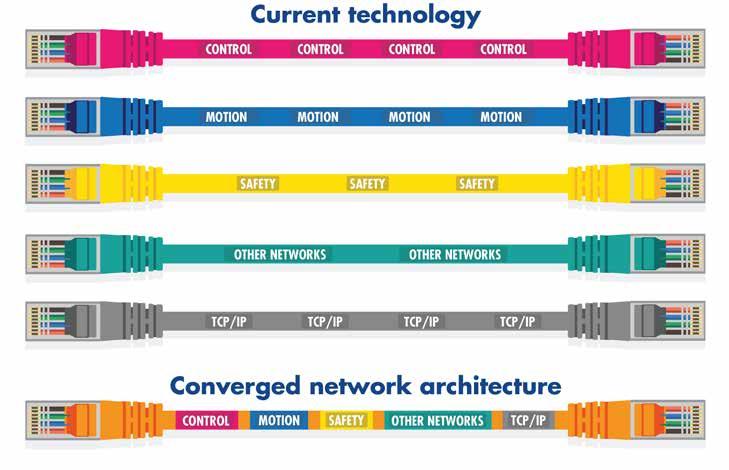
to emerging Single Pair Ethernet or Fiberoptics solutions.
3. Seamless connectivity to the internet without complicated to configure gateways. This enables remote service access, telemetry and the use of all the tools available on almost any modern platform – from phone to laptop to cloud services on tablets, to phones etc.
4. Achieving this migration in a cost effective and sustainable way. SPE provides a path to retrofit and upgrade to Ethernet using already installed wiring. SPoE provides a power delivery path over the same pair of wires.
Industrial Ethernet & TSN
Sharing the same converged network architecture along with other Ethernet traffic.
John Browett, General Manager at CC-Link Partner Association Europe, told the Industrial Ethernet Book that “until recently, industrial Ethernet was divided up into separate protocols that were generally not interoperable and could not share the same network infrastructure. Moreover, in some cases, they were also not deterministic."
"This led to significant costs for end users and machine builders as often separate networks were needed for different functions.
Furthermore, this lack of transparency often made it harder to understand processes and operate them in the best way. Systems were also often harder to maintain, impacting uptime.”
Browett said that these issues are now being addressed by Time-Sensitive Networking. TSN offers the potential for all these protocols to share the same converged network architecture along with other Ethernet traffic, while ensuring deterministic performance and greater process transparency due to easier OT/IT convergence. This is leading to major vendors incorporating TSN in their products in order to offer concrete solutions. In turn, these have been adopted globally by major end users.
TSN also provides a way for gigabit bandwidth to be adopted in end user solutions. This increased bandwidth over current 100Mbit solutions means that the “explosion” of data being seen in applications planning to use Industry 4.0 principles will be handled in the most effective way.
Evolution of Industrial Ethernet
Browett added that they are seeing a trend towards the adoption of TSN in a wide variety of industrial Ethernet products. These include most of the key parts required by machine
builders to construct their systems. Products already available include PLCs, HMIs, servo drives, inverters, I/O systems, and so on. TSN allows these to all share a common converged network with a variety of other devices that may just be using standard TCP/ IP communications, such as printers, barcode readers, vision systems and so on. Hence building systems is becoming easier and less expensive as the need for multiple networks to handle all these different types of traffic is removed.
“A specific example of how TSN is delivering technical benefits is related to systems that use high speed motion control, such as high-speed packaging machines or printing presses,” Browett said. “Until now, multiple networks were required to handle various machine functions such as motion, general control, safety and so on. TSN allows control of motion loops at the microsecond level, while also integrating other machine functions onto a single converged network architecture. The result is a transparent process built at lower cost, maintained more easily and with no loss of performance.”
IEEE 802.1 TSN
Browett said that TSN is defined by the suite of IEEE 802.1 standards. Since these
originated from the professional broadcast and AV industries, some of the standards do not necessarily have industrial use cases. However, two of these standards have been adopted in these industrial use cases to provide solutions that deliver a converged, deterministic network architecture.
The first is IEEE 802.1AS. This provides a common time base across a network, providing synchronization across all devices. This means that the amount of time required for traffic to flow across the network is precisely defined and understood, providing the basis for determinism. The second is IEEE 802.1Qbv. This works with AS to define queuing mechanisms that determine the priorities of different traffic types and hence their access to the network. This ensures that different traffic types cannot conflict and further enhances determinism.



“Some observers have commented that TSN is not a mature technology because its standards are still evolving. All technology evolves and applications need to be built today. The IEEE has a history of providing backwards compatibility as standards develop over time. Moreover, industry activities such as IEEE/IEC 60802 and TIACC will ensure TSN will continue to provide standardized solutions in the future,” Browett said.
IIoT and enterprise connectivity
Browett said that, as TSN allows different traffic types to be converged onto a single network, this also offers the possibility to improve the connectivity between OT and IT domains of an enterprise. In the past, process data was often trapped in “silos” that made understanding different parts of the process difficult. This was typically caused by equipment and installations taking place at different times with different technologies. TSN offer the potential to increase transparency by providing a way for this data to be collected and shared over a single network architecture. This in turn makes it easier for it to be provided to enterprise IT systems, possibly after being filtered first by edge servers to collect the most salient process information.
The result is that processes can be better managed and operated, as companies will have a greater understanding of what is going on in them. They can more easily take the data produced, process it into actionable information and then feed it back in order maximize optimization.
“One of the key issues faced in the past was a variety of incompatible ways to get information out of systems and share it within them,” Browett said. “The adoption of Ethernet on the shop floor has meant that a standard physical layer is available for nearly all application types, providing the foundation for single, converged network architectures as offered by TSN.”
He said that this common physical layer has also allowed a vast array of products and solutions to be provided by an equally large number of vendors. This has maximized the flexibility of options for addressing application challenges. These also come in ruggedized formats for reliable use in demanding shop floor conditions.
“It’s widely accepted today that industrial Ethernet is the way forward for virtually all application types and has been embraced across virtually all industries and the applications within them,” Browett said. “This trend will continue in the future, being further driven by additional capabilities such as those provided by TSN.”
Ethernet has won
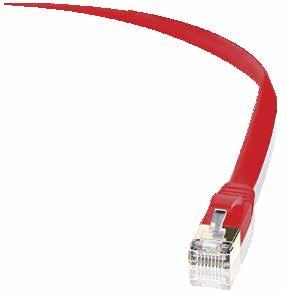
Wireless and cybersecurity represent the two most important evolutions of Ethernet technology today.
Paul Brooks, technology business development manager at Rockwell Automation provided a succinct conclusion on the impact of Industrial Ethernet: “Ethernet has won. Today, it is foolish to look outside Ethernet technology for industrial automation information infrastructure. But we need to consider why Ethernet has won to understand its outlook.”
Accelerate Your HART Data at the Speed of Ethernet
Get the process detail you need from your Smart HART devices to MODBUS/TCP and HART-IP based monitoring and control systems at the speed of Ethernet with the HES HART to Ethernet Gateway System


Connect up to 64 Smart HART devices and collect the Dynamic and Device Variables, along with diagnostics, from each device that delivers critical information needed to address process and device problems before they turn into unplanned downtime. Plus, the built-in web server lets you easily monitor all HART device data via any web browser.
To learn more about the Moore Industries HES HART to Ethernet Gateway System Call 800-999-2900 or visit www.miinet.com/HES

unmanaged switches that just plug and work, and network segmentation through routers that allow clear demarcation of responsibilities between IT and OT (what that demarcation is, is for them to locally agree. Second, there are skills easily available in the market, from small scale segments using the same technologies and tools in most of our houses to plantwide architectures using IP technologies taught in most universities and certified by most major IT suppliers (none of which removes the need for experience in how plants work). And third, it is one element of a system architecture that enables solution deployment unifying Ethernet, IP networks, WiFi and 5G (and other cellular technologies). Together, these break the rigid implementations of the Purdue model that left information stranded far from the point of use,” Brooks said.
Brooks said that wireless and cybersecurity represent the two most important evolutions of Ethernet technology today. Both are central to enabling the cloud-native smart manufacturing architectures that we know we are accelerating toward. (1) A wireless example is the machine builder running a digital twin of equipment in their own cloud, using wireless enabled AR headsets to allow on-site maintenance technicians to compare real world machine operation to design ideals. Is it Ethernet, is it WiFi, is it 5G, is it on-prem, is it cloud? Or is it all the above? (2) A security example is the pharmaceutical manufacturer with a validated process that wishes to ensure and enforce use of known firmware images in controllers and devices, only interacting in known communications patterns and only being modified by known and authorized personnel with audited change control.
“It is worth noting that no Ethernet or communication protocol layer security can deliver all this user’s needs, but without network and communication protocol layer security, other security mitigations have huge
holes,” he added.
Gregory Wilcox, principal application engineer at Rockwell Automation said that, with the rise of autonomous mobile robots, there is an increasing need for not just real-time communication, but also functional safety communications between static and moving equipment.

“Functional safety can be solved with 5G, as follows: The common industrial protocol (CIP) natively uses internet protocol (IP) protocol data units (PDUs),” Wilcox said. “As such, CIP services like CIP Safety are physical/data link layer independent. CIP Safety (functional safety) can utilize low latency wired and wireless networks since CIP Safety follows the black channel principle as laid out by IEC 61508. Time stamps are used with time expectation to detect if packets are lost, delayed, repeated, or transmitted out of order. Ethernet, Wi-Fi and private 5G provide the reliability and low latency required to support CIP Safety traffic.”
Industrial Ethernet solutions
Brooks said that another important emerging technology is the data diode, which allows external experts to gather information from on-prem systems (dependent on local IP routing from a local gateway to an end-point) and then transmit it, using paths and technologies completely under their own control (e.g., machine builder deployed 5G connectivity), to their own cloud infrastructure and applications.
This can be done with little risk* to the end user of either unpermitted data going from the end-user’s plant to the supplier’s cloud, or any plant operations being directly affected in an unplanned/unmanaged manner by the external expert. Again, networks and communications are only part of the solution, but without their contribution, there can be no solution. *No risk is not achievable; we can mitigate all
known risks, use current best practice to protect against unknown risks, and deploy crossindustry class leading technologies with broad adoption to reduce time from breach to fix.
Challenges for automation engineers
According to Brooks, automation engineers represent one stakeholder group in an ecosystem that includes data scientists, network architects and cybersecurity practitioners. The challenge that is unique to the automation engineer in this ecosystem is stranded data.
Data can get stranded in two ways: (1) There is no connectivity from the point that data is generated to the point that it is used. This is where automation engineers need to focus on Ethernet and IP connectivity to the lowest level in the system, which is the device that interacts with the physical world. Rockwell Automation would advise buying EtherNet/ IP capable drives and flowmeters (and any other end device) to enable the connectivity from cloud to device, allowing the network architects and cybersecurity practitioners to convert potential connectivity to implemented connectivity. (2) The data is presented as variables with no context.
For example, there is little point in knowing that a flowmeter has a variable set to 12.374 if you don’t know if that is temperature or flowrate (and normalized or raw flowrate) and if that flowrate is liters per second or gallons per minute. And at a higher level that the flow represents the output flow of homogenizer #6 on line 6 which is currently making orange juice to recipe #17.
“Automation engineers can focus on how they organize and present data,” Brooks said, “so it is easy for a data scientist to integrate data from many different sources with a unified concept of context.”
Al Presher, Editor, Industrial BookWhat to expect from Industrial Ethernet
The role of industrial Ethernet in factory networking is expanding, but how will it help to shape the industrial landscape? Here are ways the technology can help organizations and their operations.

AS ORGANIZATIONS CONTINUE TO TRANSFORM traditional operations gearing up to benefit from technologies such as Industrial Internet of Things (IIoT), robotics, AI/ML powered data analytics and cloud computing, the use of industrial Ethernet is soaring. In contrast to traditional Ethernet, Industrial Ethernet is designed to be more reliable, robust, and be able to handle elevated levels of traffic that are more common in industrial environments.
Industrial Ethernet speaks the language, that is, it is optimized to carry and act on industrial communications protocols such as, PROFINET, EtherNet/IP, Modbus, Common Industrial Protocol (CIP), etc. Industrial Ethernet needs to be more resilient and must be able to maintain communications even in case of equipment failure with minimal disruption.
The role of industrial Ethernet does not end there. Since machines, sensors, and controllers are directly connected to industrial Ethernet equipment, this equipment can and must do a lot more. But what more can they do and how will they shape the industrial landscape in the future? Here are a few ways in which they can help organizations and their operations.
Help operations grow and evolve
With operations increasingly relying on industrial Ethernet equipment for their functioning, the network becomes the key to organizational growth and evolution. And as operations, connected assets, and network equipment continue to grow, network management becomes increasingly important. Fast deployments of new networking equipment , reconfigurations of existing equipment, and comprehensive monitoring of their performance, without extensive manual error-prone and time-consuming work is key to growing and evolving your operations.
Secure operations
The days of “air-gapping" operations and relying solely on perimeter security are long gone. It is now well understood that the same principles developed to secure the modern enterprise can be equally effective in securing operations. Industrial Ethernet, because of its proximity to machines and control systems, is well-situated to enforce these principles that are grounded in granular visibility, policy based dynamic micro-segmentation, and continuous monitoring.
Visibility of connected assets and traffic is traditionally achieved by using deep packet inspection (DPI) techniques to network traffic spanned from switches to a central server. This method incurs extra traffic and additional costs. Industrial Ethernet, if equipped with computing resources, can perform this DPI within itself reducing costs and increasing reach and scale. Similarly, industrial Ethernet can also be used to segment traffic from assets to prevent unnecessary flows that can help contain malware spread. Finally, industrial Ethernet with the traffic visibility it enables can help in monitoring and spotting any abnormal behavior that might indicate a security breach.
Improve productivity
Industrial Ethernet is also well positioned to gather process data right at the source. Such data can provide insights that can be especially useful to detect issues before they become major problems, keep up with maintenance, and ensure product quality. With an understanding of the industrial protocols and payload formats, these devices can extract useful data, transform it to a usable format, apply governance rules, and transmit to analytical applications in the data center or the cloud.
Make industrial hybrid work possible
Truck rolls to fix issues in my industrial equipment is what I want, said no one ever. It takes time, costs money, and might well be impossible for remote assets. Traditionally, remote access has been accomplished in
several different and sometimes insecure ways. Different vendors set up their own access over which the organization has little control. In the wrong hands, these mechanisms can be exploited and used to gain unauthorized entry. There must be a better and more secure way. Organizations can leverage compute capabilities in industrial Ethernet to allow remote access to industrial assets in a secure, controlled, and standardized manner. Software loaded in the industrial Ethernet equipment can be set up to allow connections only from authorized entities at the proper time with limited access based on their role and needs.
Increase sustainability
Recent emphasis on industrial sustainability has led organizations to evaluate all aspects of their operations and supply chain. Industrial Ethernet can help in this mandate. How they avoid the use of hazardous chemicals when they are made, how they are packaged for delivery, how they can save energy with Power over Ethernet (PoE) control on connected devices, and how they are recycled at the end of their life, can all contribute to a circular economy.
How could an industrial Ethernet device deliver these while also staying true to its reliable connectivity functions? The answer lies in the devices and the computing they can do within themselves, and in the management, security, and application ecosystem surrounding them.
Technology article by Cisco Systems. Learn
Industrial Ethernet & wireless growing
There is continued growth for Industrial Ethernet and wireless networks, according to HMS Networks as it released its industrial network market shares for 2023.
EVERY YEAR, HMS NETWORKS ANALYZES THE industrial network market to estimate the distribution of new connected nodes in factory automation. This year’s study shows that the industrial network market is expected to grow by 7% in 2023.
Industrial Ethernet still shows the highest growth and now accounts for 68% of all new installed nodes (66% last year). Fieldbuses decline to 24% (27) while wireless grows to 7% market share (8% last year). PROFINET and EtherNet/IP share first place in the network rankings with 18% market share followed by the strong contender EtherCAT now at 12%.
HMS Networks presents their analysis of the industrial network market each year, focusing on new installed nodes within factory automation globally. As an independent supplier of solutions within Industrial ICT (Information and Communication Technology), HMS has a substantial insight into the industrial network market. The 2023 study includes estimated market shares and growth rates for fieldbuses, Industrial Ethernet and wireless technologies.
In the 2023 study, HMS concludes that the industrial network market continues to grow and that total market growth in 2023 is expected to be +7%, confirming the continued importance of network connectivity in factories.
Industrial Ethernet growing steadily
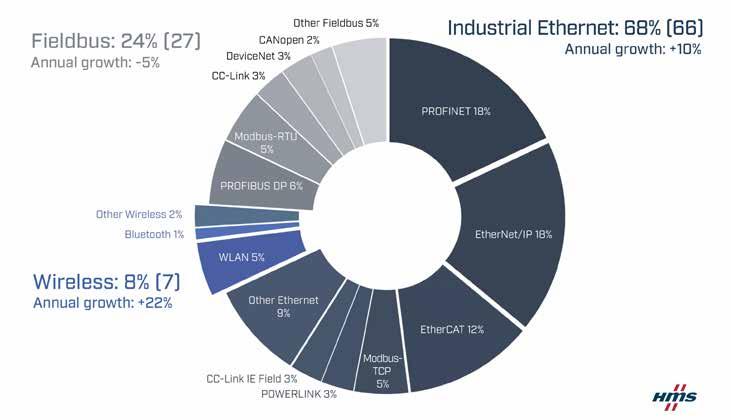
Growing by 10%, Industrial Ethernet continues to take market share. Industrial Ethernet now makes up for 68% of the global market of new installed nodes in factory automation (compared to 66% last year). The head-tohead battle between PROFINET and EtherNet/ IP continues as they lead the 2023 network rankings with 18% market share each, but EtherCAT also continues to grow strongly and is now in an unthreatened third place at 12% market share.
Fieldbuses are decreasing again
Last year’s growth for Fieldbuses was temporary as new fieldbus installations decline with -5% in 2023. PROFIBUS leads the fieldbus rankings with 6% market share, but not with much as Modbus-RTU is close behind at 5%.
Together, fieldbuses account for 24% (27) of the market in 2023. Although the number of new fieldbus nodes are declining, a lot of devices, machines and factories will still be relying on the well-functioning and proven fieldbuses for many years to come.
Wireless grows fastest
The Wireless growth accelerates to +22% in 2023, as more wireless industrial networking solutions are introduced in factory automation. Typical use cases include cable replacement
applications, wireless machine access and connectivity to mobile industrial equipment.
Industrial networking is key for productivity and sustainability in manufacturing
“Solid industrial network connectivity is key to achieve the manufacturing uptime which is needed to reach productivity and sustainability objectives in factory automation,” says Magnus Jansson, Product Marketing Director at HMS Networks, Business Unit Anybus. “Quality, security, safety, and gaining insights through device and machine data, are key drivers we see for the continued expansion of industrial networking.”
Regional network variations
EtherNet/IP, PROFINET and EtherCAT are leading in Europe and the Middle East with PROFIBUS and Modbus-TCP as runners up. The U.S. market is dominated by EtherNet/IP with EtherCAT developing strongly and gaining market share. PROFINET leads a fragmented Asian market, followed by EtherNet/IP and strong contenders CC-Link/CC-Link IE Field, EtherCAT, PROFIBUS, and Modbus (RTU/TCP). HMS
Ethernet celebrates 50 years with 2023 roadmap and demo
It’s a big year for Ethernet as it celebrates its 50th anniversary. And the Ethernet Alliance has released its new 2023 Ethernet Roadmap showcasing Ethernet’s bright future as it continues to expand into new speeds and applications. We’re now at the half-century mark, but Ethernet’s star continues to rise.
ETHERNET'S PAST, PRESENT, AND FUTURE is converging with the Ethernet Alliance’s release of a new 2023 technology roadmap and development of a new demo showcasing cohesive 400GbE technology.
It’s a big year for Ethernet as it celebrates its 50th anniversary. The Ethernet Alliance (www.ethernetalliance.org) has released a new 2023 Ethernet Roadmap showcasing Ethernet’s bright future as it continues to expand into new speeds and applications.
The Ethernet Alliance also announced more details on the multivendor interoperability demo presented at OFC 2023. The demo, featuring 18 member companies with live traffic transiting over Ethernet speeds of 10Gigabit Ethernet through 800GbE and connecting to multiple booths via the OFCnet, showcased cohesive 400GbE technology that is highly representative of real-world deployments.
Celebrating a half century
“We’re now at the half-century mark, and Ethernet’s star continues to rise. As a
profoundly resilient technology that’s getting progressively faster, it is an innovation engine that drives market diversification and fuels business growth,” said Peter Jones, chairman, Ethernet Alliance. “As the volume and variety of applications expands, bridging between legacy systems and emerging technologies is increasingly critical. The Ethernet Alliance OFC 2023 demo underscores the importance of interoperability and perfectly frames Ethernet’s ability to operate seamlessly across disparate industries and environments.”
According to Ethernet Alliance OFC 2023 technical leads Jean-Marie Vilain of EXFO, Bob Wagner of Panduit, and David Estes of Spirent, “Our 2023 interoperability demo is formidable, given the manifold technologies, interconnects, and speeds on display, and mirrors the challenges facing the industry. Highly representative of real-world deployments, it interweaves the newest generation of switches, servers and test equipment at speeds of up to 800G, proving the Ethernet ecosystem is ready for 800G’s broad adoption.”
50th anniversary
Industry leaders respond to questions around the 50th anniversary of Ethernet technology.
Ethernet has made it 50 years, is it the perfect technology? Why do you think it is so resilient?
“Ethernet has succeeded by building a comprehensive, open community that provides the technology that underpins the Internet. It doesn’t attempt to be perfect. It specifies just enough to satisfy the customer need, maintains an intense focus on interoperability, and adapts to changing needs and technologies as they arise.” -
Peter Jones, Chair,Ethernet Alliance
“Ethernet is so resilient because it has the flexibility to operate over multiple speeds and media supporting a wide range of industries and network types, while maintaining a strict standards creation process to ensure that technologies will interoperate, perform as expected in the real-world, and deliver highquality user experiences.” - Dave
Estes, Board Member,Ethernet Alliance
“The key to Ethernet’s success has been its commitment to openness and interoperability, as well as its adaptability. Ethernet constantly evolves to address new use cases - moving data from the cloud to the edge to serve an increasingly smart and connected world.”
- Sam Johnson, HSN Subcommittee Co-Chair, Ethernet Alliance“Ethernet is updatable to support higher bandwidth needs. Specifications for higher rates leverage the architectural understanding gained from the previously defined Ethernet rates. Commonality over Ethernet rates provide for it to be resilient. Expectations are met generation to generation. Innovation is employed when needed such as for providing feasible physical interconnects at the higher rates.” -
Jeffery Maki, Treasurer, Ethernet Alliance“Ethernet’s resilience is a testament to its adaptability across multiple interconnect and options and applications. Ethernet is not constrained by cable nor connection, hence its use over a myriad of copper or fibre cables, in homes and offices, across factory floors, in automobiles, and as the backbone of cellular phone networks. This adaptability is not by accident, rather it’s a product of the combined efforts of engineers across the world who come together to maintain and innovate the underlying standards. Due to its adaptability and engineering community oversight, Ethernet is and continues to be the backbone of our connected world.” -
David J. Rodgers, Events & Conferences Chair, Ethernet Alliance“Ethernet has never been perfect, but it has been good-enough, and perfection is always a narrow point, not broad-based enough to really succeed. What’s kept Ethernet alive is
interoperability at the packet, frame, and behavioral levels while changing radicallyfrom half-duplex to full-duplex, across varied media and speeds.” -
George Zimmerman, Technical Chair, Ethernet AllianceWhy is the 50th anniversary of Ethernet worth celebrating?
“With this being the 50th year of Ethernet we have much to celebrate. Many technologies have come and gone over the past 50 years while others have “peaked” and are now on the downward slope. Ethernet keeps rising to greater heights. With Ethernet, the best is yet to come!” - Chris Lyon, President, Ethernet Alliance
“The world runs on Ethernet. It’s an innovation engine for growth and market diversification, with the ability to seamlessly operate between disparate environments to benefit a growing variety of applications and users. Ethernet has established itself as the foundation of networking globally and is likely to remain so for the foreseeable future. This year as we mark Ethernet’s 50th Anniversary, it is the perfect opportunity to celebrate all those who contributed to Ethernet’s success and to appreciate the immense value this resilient technology brings to the world.”
global level. The transformative nature of networking technology now impacts us and our communities for the better in countless ways.”
- John Calvin, Board Member, Ethernet Alliance
“As we mark Ethernet’s 50-year anniversary, it has become the foundational technology used ubiquitously across the whole networking industry. Ethernet’s efficiency and resiliency lends itself to a broad set of applications and while non-Ethernet optimizations might exist, the universality of Ethernet across and between these applications results in its everbroadening adoption.”
- Mark Nowell, Advisory Board Chair, Ethernet Alliance“It is truly remarkable to see how Ethernet, born 50 years ago, is still going strong. With its ability to scale and evolve with new standards, Ethernet continues to keep up with every changing need of the marketplace and meet the challenges of today’s applications, such as enterprise, datacenter, service provider, industrial and automotive. As the data being generated in our digital life continues to grow, Ethernet technology will be the networking technology of choice for a seamless digital experience powered by AI/ML.” -
Kishore Racherla, Board Member, Ethernet Alliance“The versatility of Ethernet and growth of applications is continuously on the rise. I’m amazed that Ethernet deployments have evolved from office environments to common day use in the home, automobiles, and portable handheld devices providing seamless data connectivity anywhere. I look forward to seeing Ethernet’s evolution over the next 50 years!” - David
Tremblay, POE Certification Chair, Ethernet AllianceWhat are the greatest innovations that Ethernet has enabled?
“The Ethernet innovation that I am most excited about is Time Sensitive Networking. It is my opinion that this emerging use case will fundamentally change transportation and industrial manufacturing by enabling unprecedented component synchronization and coordination. This could not be possible without the recent enhancements built upon Ethernet over the last few years.” - Carl
Secretary, Ethernet Alliance
Wilson,-
Orshi Abraham, Marketing Chair, Ethernet Alliance“Ethernet and IEEE 802.3 in general constitutes some of the world’s best engineers and international organizational principals in work collaboration and development. Its contributions in bringing the world together a little bit tighter than it was 50 years back with efficient and scalable networking technology has brought about change at a
“Today, we can solve large problems and get answers to questions through the virtue of being connected one to anotheryou to me, both of us to others, and all of us to computers and storage. Ethernet is a key part to our interconnectedness. We are much more powerful and capable due to our interconnectedness, as well as more inclusive than ever before. Thank you, Ethernet, for being the fabric of the connectedness between humans. Let us use the power of this fabric for good; for better and more prosperous lives, creating larger knowledge for all by connecting all.”
- Pavel Zivny, HSN Subcommittee Co-Chair, Ethernet AllianceLATEST I NTE R F A C E S AND NOMEN C L A T U R E
What do you think the next decade holds for Ethernet?
“The next 10 years with Ethernet hold great promise as we are poised to fully utilize its capabilities. Ethernet will not only monitor/ communicate/control connected assets but also will provide power delivery, augmenting applications like Smart Buildings and Smart Factories. As we approach a complete Ethernet footprint from cloud to edge, enabled by technologies like Single Pair Ethernet, we’ll further leverage the transparency and availability of information from all facets of the enterprise.” -
Bob Voss, SPE Subcommittee Chair, Ethernet AllianceFuture of Industrial Ethernet
Industrial Ethernet technology is celebrating its own milestone and looking forward to a bright future.
Along with celebrating Ethernet’s fiftieth year, Industrial Ethernet is surpassing its own 25-year milestone (IEB started as a publication in 1999). So we asked Ethernet Alliance members Peter Jones, Chair, Ethernet Alliance (Cisco); Bob Voss, SPE Subcommittee Chair, Ethernet Alliance (Panduit) and Razvan Petre, Principal Member, Ethernet Alliance (Spirent) to provide their insights into the current state
and future prospects for Industrial Ethernet technology.
What is the current state and outlook of Industrial Ethernet Solutions for factory automation?
Industrial Ethernet solutions for factory automation have seen significant growth and adoption in recent years. This trend is expected to continue in the future, with an increasing number of factories embracing digitalization and Industry 4.0 concepts. Adoption is accelerated by technologies like Single Pair Ethernet (SPE) that bring power and data to the network edge, both simplifying and augmenting edge device functionality.
Ethernet communications protocols like EtherNet/IP and Profinet have become popular choices for industrial automation applications due to their high-speed communication, real-time control capabilities, and ability to handle large volumes of data. These protocols are widely adopted by leading automation vendors and are supported by a vast ecosystem of products.
The use of Industrial Ethernet enables seamless integration between machines, systems, and devices, allowing for enhanced data availability, improved diagnostic, and as a result, increased production efficiency. With

the advancements in Ethernet technology, more advanced applications are being developed, including machine learning and AI applications that can improve machine performance, reduce downtime, and enhance product quality.
Ethernet solutions also offer increased security features to protect industrial networks from cyber threats. The adoption of security measures like segmentation, access controls, and encryption, is becoming increasingly important.
How are Industrial Ethernet products solutions evolving and offering new technical benefits that are impacting smart manufacturing operations?
Industrial Ethernet products and solutions are evolving rapidly, offering new technical benefits that are impacting smart manufacturing operations in several ways:
Increased Bandwidth and Speed: The latest Ethernet solutions offer higher bandwidth and speed, enabling faster and more efficient data exchange between machines, devices, and systems. This allows for real-time monitoring and control of production processes, leading to enhanced productivity and reduced downtime. Improved Reliability and Resilience: Ethernet
OPTICAL E V OL U TIO N
Co-Packaged Optics
products are becoming more reliable and resilient, with advanced features such as redundancy and self-healing capabilities that ensure uninterrupted communication even in the event of network failures. This is critical for smart manufacturing operations that require high levels of uptime and availability.
Enhanced Security: Security is a major concern in industrial environments, and Industrial Ethernet products are incorporating advanced security features such as access control, encryption, and intrusion detection/ prevention to protect against cyber threats. This helps to safeguard sensitive data and ensure the integrity of production processes.
Integration with IoT and Cloud Technologies: The integration of Industrial Ethernet solutions with IoT and cloud technologies is enabling new levels of automation and data analytics. This allows for real-time monitoring and predictive maintenance of machines, leading to increased efficiency, reduced costs, and improved product quality.
Compatibility with Legacy Systems: Many factories and industrial facilities still use legacy systems, and Industrial Ethernet products are evolving to ensure compatibility with these systems. This allows for seamless integration between new and existing equipment, reducing the need for costly upgrades and downtime.
Overall, the evolving Industrial Ethernet products and solutions are enabling smart manufacturing operations to become more efficient, reliable, and secure. With the continued advancement of Industrial Ethernet technology, smart manufacturing is expected to become even more advanced, leading to increased productivity, reduced costs, and improved product quality.
What makes new enhancements to Industrial Ethernet technology unique, and how it is being applied to industrial applications?
Industrial Ethernet technology has evolved significantly over the years, and recent enhancements have made it more versatile and efficient than ever before.
One of the most significant enhancements to Industrial Ethernet technology is the
incorporation of TSN (Time-Sensitive Networking). TSN is a set of standards that ensure deterministic data transmission with low and bounded latency, making it ideal for real-time control applications. TSN also provides a mechanism for scheduling network traffic, allowing for greater flexibility and improved resource utilization. It enables multiple critical applications to share the same network infrastructure without affecting each other's performance.
TSN is being applied in industrial applications such as factory automation, robotics, and process control, where real-time control and synchronization are critical.
Through a collaboration between IEC and IEEE an TSN profile for Industrial Automation is currently being standardized (IEC/IEEE 60802). The profiles select features, options, configurations, defaults, protocols, and procedures of bridges, end stations, and LANs to build industrial automation networks.
Another enhancement to Industrial Ethernet technology is the integration of PoE. PoE allows power to be transmitted over Ethernet cables, eliminating the need for separate power cables for devices such as cameras, sensors, and access points. This simplifies installation, reduces costs, and improves reliability.
Single Pair Ethernet (SPE) is another recent enhancement to Industrial Ethernet technology that provides reliable and efficient communication over a single pair of wires. SPE reduces cabling requirements, simplifies installation, and enables communication over
The ever-increasing demand for power efficienc y in the data center is driving the transition to co-packaged optics.
longer distances. For example the new IEEE 802.3cg 2019 standard introduces two new variants of 10 megabit per second Ethernet over a single twisted pair, known as 10BASE-T1S and 10BASE-T1L. Industrial networking experts contributed to the IEEE 802.3cg standard, making it ideal for applications like process control, building and industrial automation, including those requiring intrinsic safety. 10BASE-T1L supports full-duplex communication over a single pair of twisted-pair cable up to 1 km. 10BASE-T1S is intended for short-distance applications and can work in multidrop mode, removing the need for switches and providing a very cost efficient option in terms of installation and operation.
What specific ways are Industrial Ethernet solutions contributing to IIoT and enterprise connectivity?
Industrial Ethernet solutions are playing a critical role in enabling the Industrial Internet of Things (IIoT) and enterprise connectivity by providing the following specific benefits:
Interoperability: Industrial Ethernet solutions enable different machines and devices to communicate with each other using a standardized communication protocol. This allows for seamless interoperability between different systems and devices, leading to enhanced data exchange and improved decision-making.
Real-time communication: Industrial Ethernet solutions offer real-time communication capabilities, allowing for rapid and accurate data exchange between different devices and systems. This is critical for IIoT applications, where real-time monitoring and control of production processes are required.
Enhanced data analytics: Industrial Ethernet solutions provide high-speed data exchange, which is essential for collecting and analyzing large volumes of data generated by IIoT devices. This allows for better insight into production processes, leading to improved efficiency and reduced costs.
Increased automation: Industrial Ethernet solutions enable greater automation of production processes, leading to increased
productivity and reduced labor costs. IIoT devices can be connected to Industrial Ethernet networks, allowing for real-time monitoring and control of production processes, leading to improved efficiency and reduced downtime.
Cloud connectivity: Industrial Ethernet solutions can be connected to cloud-based platforms, enabling remote monitoring and management of production processes. This allows for better insight into production processes and enables remote troubleshooting and maintenance, leading to reduced downtime and increased efficiency.
Overall, Industrial Ethernet solutions are critical for enabling IIoT and enterprise connectivity, providing the necessary communication and connectivity infrastructure to support the connected devices and systems that make up the modern industrial landscape.
What challenges that automation engineers face does Industrial Ethernet address?
Industrial Ethernet enables automation engineers to use “current” protocols and tools
SIGNALING METHOD S
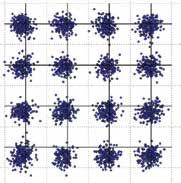

to operate their facilities. Adopting Industrial Ethernet opens the door to transformation of the automation landscape. Probably the best discussion of this can be seen in material on Industry 4.0.
Industrial Ethernet technology addresses several challenges that automation engineers face, including but not limited to:
Interoperability: In many industrial applications, different devices and systems from various manufacturers need to work together seamlessly. This can be a challenge when using different communication protocols and technologies. Industrial Ethernet provides a standard communication protocol that is interoperable with a wide range of devices and systems, making it easier to integrate different components into a cohesive system.
Scalability: As industrial systems grow and expand, traditional communication technologies such as serial communication become inadequate due to limited bandwidth
Signaling for higher lane rates has transitioned from non-return-to-zero (NRZ) used for 25Gb/s per lane to four level
Pulse-Amplitude Modulation (PAM4) for 50 Gb/s per lane and above. Coherent signaling uses inphase and quadrature modulation for 100Gb/s per lane and above.
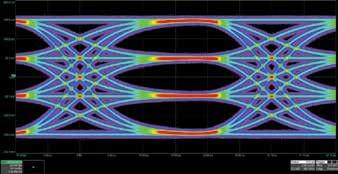
and slower data transmission speeds. Industrial Ethernet solutions can easily scale to accommodate changing requirements and growth, making them ideal for automation systems that require flexible and scalable networking solutions.
Deterministic communication: In many industrial applications, real-time control is critical. Traditional communication technologies can suffer from latency and delays, making real-time control difficult. Industrial Ethernet incorporates features such as TSN (Time-Sensitive Networking), which provides deterministic data transmission with low and bounded latency, making it ideal for real-time control applications.
Reliability: Automation systems are expected to operate continuously and without interruption. Any failure or downtime can have significant consequences for production and the bottom line. Industrial Ethernet solutions provide fast and reliable data transmission,
ensuring that automation systems operate continuously and without interruption.
Security: As automation systems become more connected, they become more vulnerable to cyber-attacks. Ensuring that these systems are secure and protected against unauthorized access is critical. Industrial Ethernet solutions incorporate advanced security features such as encryption, authentication, and access control.
This ensures that data transmitted over the network is secure and protected from unauthorized access.
Compiled by Al Presher, Editor, Industrial Ethernet Book.
For more information on the Ethernet Alliance and the 50th Anniversary of Ethernet technology, visit their website.
Visit Website
Transforming your industrial network infrastructure
Futureproof networking solutions are designed to help businesses seamlessly merge their IT and OT systems, and prepare them for transitioning to a digitalized future. Businesses can worry less about their industrial networks and focus on fully embracing digital transformation, so they can leverage digital innovations.
RECENT GLOBAL EVENTS HAVE MADE digitalization an urgent and compelling goal. Most companies, regardless of industry, are beginning to realize that digital transformation is imperative to avoid falling behind and becoming uncompetitive. More and more industries speeding up innovation. Yet, many businesses are unable to successfully transform and futureproof their operations.
One of the most common reasons is the misconception that digital transformation is just a matter of deploying new technologies or buying newer equipment.
Digital transformation
When only focusing on adding new technologies, companies will likely be unable to tap into their full potential despite the huge amounts of resources invested into the project. Achieving digital transformation for industrial applications not only involves introducing new technologies, but also seamlessly integrating all the systems on the network. A smooth-running and fully integrated infrastructure is the foundation that enables newly added technologies to work in harmony with existing systems to enhance industrial operations.
Among industry leaders, IT/OT convergence has gained a lot of ground as the best-practice method to integrate new systems and create value. According to IDC’s IT/OT convergence survey, more than 30% of organizations are planning to integrate operational data from systems such as data historian software, industrial control systems, and asset management into their enterprise data governance model for the first time.
When OT data is accessible to IT, it can be converted into a valuable asset and increase organizational agility. Seamless transmission of OT data between application endpoints, control centers and corporate headquarters is essential for merging IT and OT systems and making sure newly added technologies work flawlessly. This explains why enhanced, robust industrial networks are an indispensable part of any successful digital transformation.
Industrial networks leap forward
The rapid growth of IT/OT converged applications has led to more diverse and real-time data as well as larger volumes of
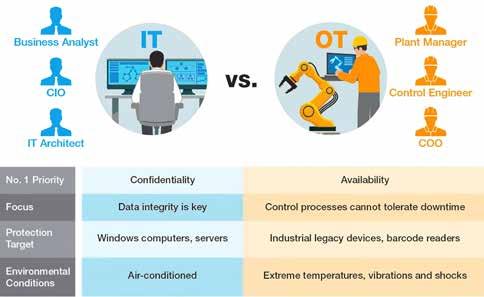
OT data. The complexity of industrial network infrastructure has also grown significantly. As a result, it becomes increasingly more difficult to maintain the network’s reliability, which determines the stability of machineto-machine and machine-to-control center communications which, in turn, ensure continuous operations.
For a long time, maintenance engineers were only concerned with whether the indicators on the network equipment were flashing green. But as data is becoming the catalyst for innovation, ensuring that data is delivered to the right place at the right time is critical. Therefore, businesses should instead direct their attention to functional reliability. That is, to meet future needs, businesses should not only focus on stable network connectivity, but also design their network to support seamless OT data connectivity.
Transitioning industrial networks is not easy and is unfamiliar territory for most OT engineers. Shifting towards a future industrial networking model comes with its own set of challenges and hurdles, including:
The integration of OT and IT systems exposes traditionally isolated OT networks to outside threats. Cybersecurity attacks in the OT field have also soared in recent years.
Expanding network connections have greatly increased the complexity of management. It’s impossible to rely on old tried-and-tested methods to manage hundreds and thousands
of network devices efficiently.
Transformation relies on an ability to ensure uninterrupted operations. Maintaining system reliability while implementing digitalization can be challenging. Industrial networks typically undergo minimal change from year to year. Considering long-term future usability when designing the network is important.
To help businesses overcome these hurdles and ensure a smooth transformation of their industrial networks, we recommend choosing reliable hardware and software that can support the seamless data transmission and integration needs to sustain continuous operations. Additionally, dedicated OT network security is an essential building block that shouldn’t be overlooked in order to protect OT networks from cyberthreats and maximize system availability.
Businesses should prioritize intuitive software to simplify management and allow for complex systems across the network to be more easily monitored and maintained. By combining the capabilities of network and data connectivity, businesses can incorporate intelligent functionality such as remote control commands and incident response mechanisms into their operations, and prepare for the needs of future OT applications.
Ethan Chen, Product Manager, Moxa.2023 Industrial Ethernet Solutions Showcase
IEB's Industrial Ethernet Solutions Showcase presents the viewpoints of industry experts on networking in the factory. With Single Pair Ethernet, TSN, wireless technologies including Industrial 5G, higher performance and a heightened importance of cybersecurity, many say the future has never been brighter.
INDUSTRIAL ETHERNET SOLUTIONS ARE AT the heart of how modern manufacturing plants are managing their networks, and provide mission-critical technology in the quest to achieve digital transformation.

In this special showcase, the Industrial Ethernet Book has reached out to industry experts to gain their insights into how Industrial Ethernet solutions are evolving to meet the needs of both engineering and information technology professionals.
Meeting the needs of control engineers and IT personnel
The evolution of technology is providing solutions at many levels
According to Mike Willett, Network Engineer at Red Lion, Industrial Ethernet technology is evolving to provide greater levels of connectivity.
“Industrial Ethernet is evolving at a fast pace. Not only is there a greater need to conform to the requirements of the IT network environment, but things are always changing and the industrial network has more and more
requirements,” Willett told the Industrial Ethernet Book recently. “First of all, how we connect is evolving. We have more advanced firewalls, routers and switches now to securely connect to devices and cloud servers.”
Willett said that Red Lion’s FlexEdge can aggregate data from all over the network, perform protocol conversion for over 300 protocols so all of the devices can communicate and also push that data to a cloud server all securely over a VPN and within a firewall architecture. One device can support so many levels of connectivity within itself from networking to automation.
“We have more advanced security at the switch level to allow more devices to be connected securely and again conform to the requirements of an IT network,” Willett said. “Then, aside from the type of connectivity, the way we physically connect is evolving. The speed at which we connect is evolving. We have switches supporting gigabit and even 10 gigabit speeds now to support everything including high definition video streams and surveillance video.”
He also added that, all the way down to
the power requirements is evolving. “We have advanced managed PoE switches now and devices supporting various ranges of input powers. So, Industrial Ethernet technology is evolving at a very fast rate, and it is very exciting to see this level of connectivity to support all the necessary applications.”
Industrial Ethernet megatrends Willett said that Red Lion is seeing more advanced security features in managed switches.
“Again, as the industrial network needs to conform more and more to the requirements of the IT network, they are seeing these trends emerge,” he said. “Also, the ‘ease of use’ aspect of devices is a huge trend. Very often it will be controls engineers that need to have access to these devices and configure them. So it is very important that these devices have that ease of use factor to them. It will very often not be the IT network engineer supporting these devices.”
The N-Tron series NT5000 switches have a very granular set of security features to provide a lot of flexibility. It also has a
“We see a lot of different technologies running within factory automation solutions – everything from legacy fieldbus systems with minimal transmission rates to decentralized solutions running machine to machine communication, machine learning/AI, or digital twins in connection with technology innovations such as wireless, 5G, high performance Ethernet, hybrid connectivity, or Single Pair Ethernet (SPE),” Manuel Rüter, Principal Engineer TE Connectivity.
very user-friendly web interface, so that the controls engineers that need to administer the switches can be comfortable navigating them. The switches also have a very modern look to them inside the web interface but they also have the features that IT is looking for. The devices have a very intuitive command line interface so that the more IT centric user can be comfortable navigating the switches as well.
Another trend in the Industrial Ethernet world that Willett cited is to be able to purchase a piece of hardware today, but also upgrade it as necessary to the features required via software and not have to replace hardware in the future.
For example, the FlexEdge from Red Lion has different levels of feature sets that can be upgraded in the field as necessary. This way users have that ongoing flexibility. Also, having a device that can be more of an “all in one” type of device is a big plus. The FlexEdge can also be the edge device, firewall, router; it can support a variety of automation features, protocol conversion, bringing in tag data, and support connections to various cloud servers. The trends we are seeing fit this type of criteria. It is important to have the intuitive ease of use features for controls engineers to navigate the devices comfortably, but also incorporate the IT feature sets that are required for the overall network architecture.
Key technical benefits
Key technical benefits that new Industrial Ethernet solutions are providing focus on the needs of both OT and IT personnel.
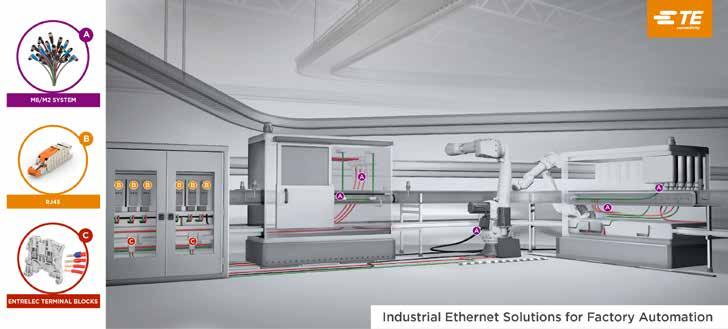
“It is all about including those network
devices that fit the requirements of the IT network architecture and are comfortable for an IT centric user to support, but also have the ease-of-use aspect and be user friendly for a controls engineer to be able to support it,” Willett said. “New Industrial Ethernet solutions need to provide this. The new Industrial Ethernet needs to have a high level of security features since these networks are now connecting across the world and connecting to cloud servers and management platforms.”
New Industrial Ethernet solutions are providing that “pay as you go” structure as well. Red Lion’s FlexEdge provides different levels of feature sets that can be upgraded via software in the field. The idea of connecting anything to anything at anytime, anywhere, over fast, reliable and secure connections is a huge technical benefit of the new Industrial Ethernet solutions.
Willett said that one big challenge is being able to use all of your devices together and securely. Very often there are devices in the network that are older that have been in place for years. Also, sometimes they are communicating over different protocols. So, being able to convert legacy protocols so that all of these devices can communicate together and also be able to connect back to a modern and secure device that can handle all the outbound connections, VPN connections, and secure cloud connections is critical.
“More and more data needs to be aggregated and sent externally to your local network,” Willett said, “so being able to undertake the vast requirements is crucial to address the design of a modern industrial network.”
Fragmentation drives need for better interoperability
Moving toward a decentralized system that operates in clusters or subsystems.
“We see a lot of different technologies running within factory automation solutions – everything from legacy fieldbus systems with minimal transmission rates to decentralized solutions running machine to machine communication, machine learning/ artificial intelligence, or digital twins in connection with technology innovations such as wireless, 5G, high performance Ethernet, hybrid connectivity, or Single Pair Ethernet (SPE),” Manuel Rüter, Principal Engineer at TE Connectivity told the Industrial Ethernet Book.
“This fragmentation in Ethernet-based systems has increased the demand for stronger interoperability between and among automation solutions. To help readers understand the challenges and opportunities of this fragmented approach, it might be helpful to compare the current state to the human nervous system,” he added.
Rüter stated that today, older and current systems communicate via a centralized I/O system in the control cabinet or automation control unit – this is essentially the brain. Acquaintance technologies like terminal blocks are one of the most common solutions.
In the future, real-time communication and greater volumes of data at the field level will require a decentralized communication system that operates in clusters or sub-systems –similar to nerve endings and neurons. Most of the transactions occur directly inside these sub-systems, which requires high transmission
and communication capabilities inside the device as well as significant shielding and transmission rates, which affects the innovations in board connections (example of high-performance board connection).
“Interactions and dependencies between these sub-systems are becoming more important, which has placed a higher demand on performance and bandwidth, as well as greater interest in merging the capabilities of informative technology (IT) and operative technology (OT),” he added.
Technology Trends
Rüter said that there are four trends that are having an impact on smart manufacturing operations and demonstrate the need for improved communications and interactions between IT and OT systems in the factory:
• The influence of the decentralization trend has advanced the movement toward greater modularization, which further enhances flexibility in manufacturing processes.
• Regarding topics such as material feed, predictive maintenance productivity, and better-quality information, there have been many optimizations in the material flow process, allowing manufacturers to use the parts where they need them at the right time.
• The merger of IT and OT capabilities allows manufacturers with automated guided vehicles (AGVs) to select parts directly from the office over the shop floor.
• Sensors allow manufacturers to detect even the smallest deviations in parts or process, which reduces tooling wear and material resources, and helps optimize process runtime as well as maintenance cycles and commodity flow. Modular
machine elements or production areas make this concept complete and also include the possibility of shared production.
Applications focus
He added that enhancements to Industrial Ethernet technology are providing unique capabilities that can are being applied to industrial applications.
Rüter said that collaborative robots (cobots) are a good example of the enhancements made available through Industrial Ethernet technology advancements. The greatest value of cobots is that they can help free a skilled employee from the menial aspects of their job in order to concentrate exclusively on the high-value aspects.
For example, in complex device assembly requiring a deft human touch, a cobot can perform simple handling or manufacturing tasks that allow workers to focus on the parts of the job that make full use of their skills or knowledge. The goal of the industrial internet of things (IIoT) is to make processes easier and help optimize workflows.
“Camera and sensor systems are also great examples of advances in Industrial Ethernet technology. In the past, manufacturers were limited to information provided by the quality gates or the quality control behind the complete process. Now, with IIoT components, manufacturers have access to just-in-time information on each piece, including reaction time, optimizations, intervention-related quality, and efficiency – all to help reduce costs and minimize bad parts,” he said.
He added that there are three ways Industrial Ethernet solutions contributing to IIoT and enterprise connectivity.
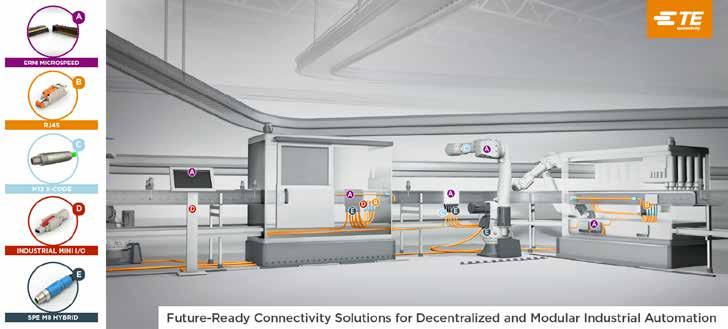
1) In the fast-paced world of production, machine-to-machine communication
that allows information to be exchanged directly between the involved production areas and elements (such as robots and conveyor technology) makes it possible for manufacturers to keep up with highly complex supply and production chains.
2) Sensors of any kind require processing intelligence and interpretation to provide data and information that is useful to manufacturers. Whether you are talking about temperature sensors, distance sensors, pressure sensors, or cameras, all of these industrial elements require real-time connectivity to meet the promise of the IIoT.
3) The interconnection between the IT and OT provides manufacturers with better efficiency and reliability in their operations. This access is not locale limited, data is available all over the world to anyone with access.
For example, internally at a manufacturer’s facility, it could be helpful for a production planner in Europe to access production data from different factories in real-time to optimize their workflow. Or an external partner with access, such as the maintenance or service partner for robots, could access all relevant data on the robot to enable smooth operation and service.
“Broad acceptance of this technology is important for optimal integration. The RJ45 connector is the most common used connection for data communication today (see below), and is considered the standard communication interface for industrial applications. Yet even greater capabilities can be unlocked when manufacturing customers expand their system to include new technologies like TE’s Mini I/O or SPE connectors to transform and optimize their production environment,” Rüter said.
"In response to increasing operations digitization and the move towards adoption of Industry 4.0 principles in various industry verticals, Industrial Ethernet technology has made great advances in recent years. Industrial Ethernet solutions are evolving to support remote access, obviating the need for more complex and potentially unsecure methods allowing machine vendors to connect to machines to monitor, troubleshoot, or configure them,” Vivek
Challenges for automation engineers
One major challenge for automation engineers managing Industrial Ethernet networks is the “possibility of rethinking processes”. For example, does it make sense to split certain steps in the production process? Which information points in the whole process could be used as indicators for better quality, fewer scraps, and/or speed recovery?
“With IIoT systems, we have access to those data points (and more) so we can share it with virtually all involved areas to identify opportunities to gain efficiency. Consider the digital twin for example. The digital twin of your machine includes information like maintenance data, runtime, error quotes, and energy consumption. But the digital twin is not only a solution for a product. Manufacturers can review the digital twin data for information about sustainability and to identify places to conserve resources. Sustainability and resource conservation are not only mega trends and significant challenges for our daily business, but they are also an opportunity to drive greater production efficiency,” Rüter said.
Another challenge is the integration of many periphery devices. Next to the data connection, power is also needed. Fortunately, hybrid SPE technologies not only provide high-speed Ethernet to the sensor, they deliver
power directly as well. This not only enables a more forward-thinking, future-ready approach, it also reduces the amount of cabling required, saving valuable company resources.
Greater levels of connectivity
Industrial Ethernet solutions are evolving to address a wide range of performance criteria.
“In response to increasing operations digitization and the move towards adoption of Industry 4.0 principles in various industry verticals, Industrial Ethernet technology has made great advances in recent years,” Vivek Bhargava, Product Marketing for IoT Networks at Cisco, told IEB.
Bhargava summarized how Industrial Ethernet technology is evolving to provide greater levels of connectivity by concentrating on key performance requirements.
Harsher environments: Ruggedized Industrial Ethernet equipment has long provided connectivity in non-temperature-controlled environments and resistance against dust, shock and vibration, humidity, and water. For extra protection against corrosion from moisture, fine dust, salt, and chemicals, some Industrial Ethernet equipment also comes with conformal coatings on its PCBs.
Higher speeds: To support the everincreasing needs for higher throughput,
gigabit Ethernet port speeds are now quickly becoming the norm. Industrial Ethernet products also feature multi-gigabit (mGig) ports for connecting even higher bandwidth equipment such as Wi-Fi 6/6E access points, and 10 gigabit ports for uplink connections to distribution and core switching layers.
Industrial protocols, resiliency, and compliance: Compliance with industrial protocols ensures that industrial ethernet equipment can communicate with devices on the network using a common language. This, in turn, ensures that devices can exchange data and control signals reliably and efficiently, without errors or delays. It also helps to simplify the integration of new devices into existing networks. Compliance with protocols such as Ethernet/IP, PROFINET, MODBUS, GOOSE etc., are basic requirements.
Other protocols include those for timing (Precision Timing Protocol (PTP)), for resiliency (High-Availability Seamless Redundancy (HSR), Parallel Redundancy Protocol (PRP), Media Redundancy Protocol (MRP), and Device Level Rings (DLR)), as well as those for specific use cases such as IEC61850 (Electric Substations Communications).
Advanced security: Industrial Ethernet is evolving to meet more complex standards such as IEC62443 (Security for industrial automation and control systems). This standard defines

the requirements for security for industrial automation and control systems, and lays out a framework for hardware integrity, asset visibility, segmentation of operations into zones and conduits, and control.

Being directly connected to industrial assets, Industrial Ethernet equipment can offer deep visibility into the identity and interactions of those assets, without the need to span the traffic to a separate server, and thus obviating the need for extra network traffic and costs of the server. This visibility can be leveraged to formulate access and segmentation policies and enhance security. Industrial Ethernet can also enforce these policies.
"Industrial Ethernet solutions are evolving to support remote access, obviating the need for more complex and potentially unsecure methods allowing machine vendors to connect to machines to monitor, troubleshoot, or configure them. This is particularly useful for organizations with multiple sites or distributed operations, reducing costs and time," Bhargava stated.
Fostering collaboration with IT: Industrial Ethernet is evolving to enable more integration of IT solutions and practices helping operations bring the same levels of networking automation, performance assurance, and centralized policy, proven in the largest of enterprise networks. Adopting IT practices also helps in better collaboration between IT
and OT by sharing knowledge and expertise, creating a shared vision, using common tools and platforms, establishing a governance structure, and focusing on common concerns such as cybersecurity.
Technology trends driving innovation
Bhargava said that “to keep up with the demand and usability that industries expect from these devices, Industrial Ethernet hardware and software is advancing at a rapid rate.”
The key technical trends can be summarized as follows:
Higher performance: Organizations are bringing an ever-increasing number of industrial assets online. Some endpoints such as high-resolution cameras, Wi-Fi 6/6E access points, and those needed for real-time communication required on the plant floor are driving the need for higher switching and routing capacities requiring Industrial Ethernet to adopt technologies and architectures from their enterprise counterparts.
Superior Power-over-Ethernet: With higherwattage 4-pair PoE (IEEE 802.3bt) coupled with higher bandwidth multi-gigabit ports and large total PoE capacities, Industrial Ethernet can supply the required power to industrial devices requiring a larger amount of power than could be supplied with earlier PoE technologies.
Devices that consume more power and simultaneously need more bandwidth such as high-definition PTZ cameras, digital signage, and Wi-Fi 6/6E access points can benefit from the mGig ports that also supply 4-pair PoE up to 90W.
Smaller form factors: Increasing number of devices and controllers constrain cabinet spaces and add engineering efforts in custombuilt machinery. These environments often have limited space for networking equipment, especially in applications such as machine control or automation. Smaller equipment can help ease these constraints. However small form factor equipment must not compromise on features and speeds.
Modularity : Being able to add modules to an existing base unit helps extend the organization’s investment, allowing them to match their network investment in sync with their needs. Industrial Ethernet switches and routers equipped with field pluggable modules that add ports or allow you to switch between connectivity methods such as public or private 4G or 5G, or FirstNet, provide the needed flexibility.
Edge-computing : Edge-computing enables data processing close to where it is generated, not only reducing latency and response times but also decreasing the amount of data, and the network load, that needs to be transmitted to a central server. Computing performed in
Industrial Ethernet devices themselves can even eliminate the server. Edge-computing is extremely beneficial for running applications such as deep packet inspection (DPI) for visibility on assets and their interactions, secure remote access to allow remote monitoring of assets, and for extracting real-time process data for analysis.
The result is that new Industrial Ethernet solutions are providing key technical benefits.
Interoperability : By using standard communications interfaces, Industrial Ethernet solutions replace proprietary communications technology, providing interoperability, enabling seamless communication and integration of devices and subsystems from different vendors and technologies. This promotes flexibility and innovation, as organizations can select the best products for their specific needs.
Virtualization : Industrial control systems vendors are starting to introduce softwarebased PLCs (Programmable Logic Controllers) that industrial organizations can install as virtual machines on the plant floor to simplify deployment, maintenance, and updates to their automation systems and dramatically reduce operational expenses. Industrial Ethernet provides the highly available, secure, and high-performance deterministic networks that such virtualization needs.
Machine to cloud connectivity: Industrial
Ethernet, funneling through the enterprise network, connect operations to the cloud, enabling communications with cloud-based applications and services. This allows for real-time data collection, AI/ML aided analysis, and processing, as well as remote monitoring, control, and maintenance of industrial systems.
Applications and challenges
When looking specific applications and the types of engineering challenges that these new innovations are designed to address for customers, Bhargava outlined how greater levels of connectivity has specific impacts depending on company goals and objectives.
Process optimization: Industrial engineers are tasked with optimizing manufacturing and business processes to improve efficiency, reduce waste, and increase productivity. Visibility and real-time data that Industrial Ethernet can help obtain, can provide insights into potential inefficiencies and better control.
Product quality control: Industrial engineers are responsible for ensuring that products and services meet customer requirements and standards. This requires developing quality control systems, implementing statistical process control, and conducting root cause analysis to identify and resolve quality issues.
Supply chain management: Industrial engineers are responsible for designing
and managing supply chains to ensure timely and cost-effective delivery of goods and services. This requires coordination of multiple stakeholders, including suppliers, manufacturers, distributors, and customers, and dealing with challenges such as variability in demand, disruptions in supply, and changing market conditions.
Sustainability: Industrial engineers are increasingly focused on designing sustainable systems and processes that minimize environmental impact and maximize resource efficiency. This requires incorporating green design principles, reducing waste and emissions, and implementing renewable energy and recycling programs.
Health & safety: Industrial engineers must also ensure that the industrial equipment, processes, practices, and procedures protect the health, safety, and wellbeing of workers. Industrial Ethernet can help them with tools such as remote monitoring, obtaining real-time data, and performing predictive maintenance.
Secure remote operations: Operations are challenged to provide secure access to remote workers, especially to distributed, hard to reach locations. Industrial Ethernet can enable not only connectivity over fiber or cellular but also run remote access application for a standard, consistent method that obviates the need for many and potentially unsecure techniques.

Greater levels of connectivity
Industrial Ethernet solutions are evolving to address a wide range of performance criteria.
Industrial Ethernet technology is evolving to provide greater levels of connectivity. According to Igor Bozovic, Product Marketing Engineer at Moxa Europe, “Industrial Ethernet technology is rapidly evolving to meet the demands of Industry 4.0 and the Industrial Internet of Things (IIoT). This evolution is driven by the need for robust, reliable, redundant, and secure communication protocols that can handle large data volumes with minimal latency and downtime.”
“Advanced standards like TSN (TimeSensitive Networking) provide deterministic communication and synchronization, while OPC UA (Open Platform Communications Unified Architecture) enables seamless data exchange. The adoption of cloud and edge computing enhances data processing and analysis capabilities. Cloud computing centralizes storage and analysis, while edge computing enables real-time processing at the network edge. These advancements enable more connected, efficient, and intelligent industrial environments, empowering organizations to achieve higher productivity, profitability, and sustainability,” Bozovic said.
Technology trends
Bozovic said there are key trends shaping the development of Industrial Ethernet products including Moxa's switches, gateways, routers, and software solutions like MxView:
Higher Bandwidth and Speeds: Industrial applications generate increasing data volumes, driving the need for higher-speed Ethernet standards like 10GbE and 40GbE.
Enhanced Cybersecurity: Robust cybersecurity features are crucial for protecting industrial networks against cyber threats. Advanced protocols such as network segmentation, intrusion detection, and access control are being incorporated into Industrial Ethernet products.
Improved Network Management: With complex industrial networks, effective management solutions are essential. Features like remote management, automated configuration, and real-time monitoring simplify network management and enhance operational efficiency. MxView MXview One software is an ideal solution for network device management.
Edge Computing: Real-time data processing and analysis at the source are facilitated by edge computing, reducing latency, and improving performance. Industrial Ethernet products now integrate edge computing capabilities for applications like predictive maintenance and quality control.
Interoperability: Open standards and protocols like OPC UA and MQTT ensure seamless communication between devices and systems in complex industrial networks.
These trends drive the evolution of Industrial Ethernet products, enabling greater connectivity, cybersecurity, network management, edge computing, and interoperability in industrial environments.
Key technical benefits
“New Industrial Ethernet solutions bring key technical benefits that are transforming the industrial landscape. They enable organizations to improve operational efficiency, reduce downtime, and enhance safety and security,” Bozovic said.
“These benefits include increased connectivity and data exchange, improved reliability, enhanced security features, greater flexibility for adapting to operational changes, real-time data access for faster decisionmaking, and reduced costs through efficient operations and minimized maintenance expenses. Overall, these advancements drive the transformation of industrial environments, empowering organizations to achieve higher productivity, profitability, and sustainability,” he said.
These new Industrial Ethernet innovations address specific applications and engineering challenges in various industries. Common applications include:
Smart Manufacturing: Industrial Ethernet enables real-time data collection and analysis for improved efficiency, quality control, and predictive maintenance.
Industrial Factory Automation: Real-time communication and control through Industrial Ethernet enhance operational efficiency and reduce downtime.
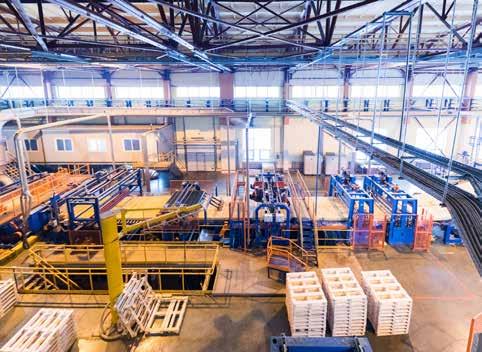
Power and Energy: Industrial Ethernet enables real-time monitoring and control of power systems, improving efficiency and reducing downtime.
Transportation (ITS): Industrial Ethernet facilitates real-time communication and control in transportation, enhancing safety and efficiency.
Building Automation: Industrial Ethernet enables real-time communication and control of building systems, improving energy efficiency, and reducing costs.
Engineering challenges
Bozovic added that engineering challenges that automation engineers are facing include interoperability, reliability, security, scalability, and integration. Industrial Ethernet ensures seamless communication with different devices, reliability to minimize downtime, robust security against cyber threats, scalability to handle large data volumes, and smooth integration with existing systems.
“These innovations drive operational efficiency, reduce downtime, and enhance safety and security in industrial environments,” Bozovic said. “They cater to specific applications and overcome engineering challenges, empowering organizations across industries to achieve greater efficiency and productivity.”
Ethernet switches increase performance and security
Gigabit industrial switches set a new standard for performance, reliability and ease of use, with security features designed to keep networks connected and protected.
AS INDUSTRIES AROUND THE WORLD DIGITALLY transform and optimize their operations, reliable and secure network access is absolutely critical. New N-Tron series NT5000 Gigabit Managed Layer 2 Ethernet switches are designed to improve network security and reliability for industrial organizations of all sizes and environments.
The NT5000 maximizes operating performance and system uptime through seamless integration, advanced management and diagnostic capabilities, network redundancy and layered security, and helps organizations meet information technology and operational technology needs for dependable communication.
“Clear, comprehensive and fast network management is essential for organizations to achieve maximum uptime,” said Diane Davis, director of product management, networking, at Red Lion. “The NT5000’s simple graphical user interface includes a logical view showing active ports, power supply, temperature and contact relay status of the switch and colorcoded gauges for port traffic and events to allow administrators to quickly identify and address possible network disruptions in real-time, helping lower total cost of ownership.”
Designed and assembled in the United States, NT5000 switches are available in 6, 8, 10, 16 and 18 port configurations in all copper or a mix of copper and fiber options that can meet specific installation requirements. With a durable, metal enclosure and wide temperature range, the NT5000 is a compact solution for reliable operation in harsh, industrial environments, including factory automation, robotics, food and beverage, oil and gas, marine and rail.
Streamlined setup
Configuring switches can be a confusing and time-consuming process. The NT5000 is engineered for fast and easy deployment right out of the box. Its modern, graphical user interface includes a configuration wizard that walks users through initial setup.
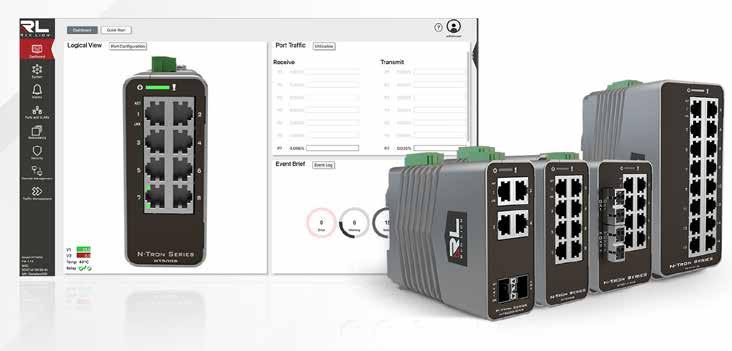
Layered security
Today’s cybersecurity threats can result in severe consequences. Not all switches have the layered network security to help prevent unauthorized access. The NT5000 features password encryption, multilevel user access and MAC security, IEEE 802.1X with RADIUS remote authentication and more. Administrators can view the event and syslog
to clearly see the state of the network in real time and receive notifications about access attempts or configuration changes. The switch can be set to automatically disable user or port credentials after failed access attempts.
Diagnostics and management
The NT5000 also features:
• Graphical dashboards
• N-RingTM auto-member
• Port mirroring
• Cable diagnostics
• STP/RSTP/MSTP
• IGMP v1/v2/v3
• SNMP v1/v2/v3
• NTP, LLDP and LACP
• Fast boot allowing traffic to pass in less than 20 seconds
• Wide shock and vibration tolerance
• Extensive compliance certifications, including Product Safety: (UL/CUL) Ordinary and Hazardous locations, Emissions/Immunity: FCC/ICES/CE, ATEX/IECEx, Marine: ABS, Rail: EN 50155, EN 50121, EN 61373, UKCA
Product highlight by Red Lion.
Learn More
Ethernet switches bringing IT capabilities to operations
New Industrial Ethernet switches from Cisco Systems concentrate on bringing enterprise IT capabilities to Operations Technology applications while also addressing performance, reliability and harsh environments.
RAPID GROWTH IN INDUSTRIAL IOT DEMANDS
a new type of network with enterprise-grade security, automation, and performance combined with industrial-strength features to meet compliance and use case requirements.
Catalyst IE9300 Rugged Series Switches
Catalyst IE9300 Rugged Series switches bridge the gap between IT and OT and integrate enterprise capabilities with industrial protocols in a form factor built for rugged, industrial spaces. There are two models in the Catalyst IE9300 series – Catalyst IE9310 and IE9320. Both features 26x 1-gigabit SFP ports and 2x 1-gigabit dual-media ports. The Catalyst IE9320 also features 2 stacking ports.
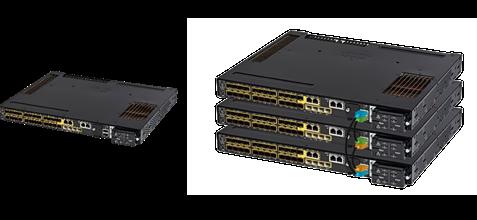
Customer challenges and switch features
Consistent end-to-end network architecture: Oftentimes, operations networks have a patchwork of architecture with equipment from different vendors with their own management and security tools. This leads to unnecessary complexity and maintenance difficulties. Catalyst IE9300 is a part of a consistent, unified, and comprehensive Cisco networking architecture, extending from industrial assets to the enterprise and all the way to the cloud.
IT and OT collaboration: As operations networks expand and become more complex, IT skills are necessary to manage and secure them. Catalyst IE9300 shares key hardware components, IOS XE operating system, and is managed and secured by the same management and security solutions as the popular Catalyst 9000 enterprise switches. This consistency allows organizations IT and security departments to utilize their existing skills and investment for both networks using the tools they know and trust.
Scale and agility: As operations networks become more complex, onboarding, configuration, monitoring, securing, and changing them become difficult, time consuming, and error prone. The Catalyst IE9300 is managed by Cisco DNA Center, a network manager proven in the world’s largest enterprises and most complex networks, that can onboard, configure, update, and monitor the performance of Catalyst IE9300 switches, and providing the scale and agility that operations need. Moreover, the Catalyst IE9300 can be stacked up to 8 units to
achieve even higher levels of performance and scale without the corresponding increase in configuration burden.
Edge computing: Operations can benefit from real-time analysis that can be performed close to the source of the data rather than using SPAN ports and backhauling the data to an external server. Computing resources built right into the networking equipment can help reduce costs, increase responsiveness, and improve reliability. Catalyst IE9300 features Cisco IOx, which is an open, distributed computing platform designed to run applications at the edge of the network. Developers can create custom applications that can interact with data from sensors, devices, and other network endpoints.
Visibility: Often, operations and IT teams do not have a detailed list of industrial assets that are connected to the network. The edgecompute capability of Catalyst IE9300 can host Cisco Cyber Vision application that performs Deep Packet Inspection (DPI) on network traffic to discover the identities of connected assets and their interactions and identifies any security vulnerabilities. In addition to Cyber Vision, Catalyst IE9300 also runs Cisco AI Endpoint Analytics that provides visibility into connected enterprise assets.
Security and segmentation: Operations networks are sometimes “flat” with no segmentation. Without an accurate understanding of traffic flows, any attempt at segmentation could result in disruption of normal functioning. Visibility into traffic flows provided by Cyber Vision and Endpoint Analytics can form the basis for effective segmentation. Defining and redefining segmenting policies and enforcing them in
the network with Catalyst IE9300 is as easy as point and click on Cisco DNA Center.
Resiliency: Any downtime in their networks can be extremely disruptive to operations. Therefore, operations networks must be made more resilient and be able to recover quickly in case of failures. Catalyst IE9300 incorporates several algorithms such as High-Availability Seamless Redundancy (HSR), Parallel Redundancy Protocol (PRP), Media Redundancy Protocol (MRP), and Device Level Rings (DLR) that provide high-speed lossless failovers. Standards compliance: Accepted industry standards ensure interoperability of products that comply with those standards. The Catalyst IE9300 complies with various standards for electromagnetic emissions, industrial safety, operating environment, shock and vibration, corrosion, etc., it also complies with IEC 61850-3 that defines standards for electric substations communications networking.
Common use cases
The high fiber port density that the Catalyst IE9300 features allows connecting endpoints that require native fiber access such as Intelligent Electronic Devices (IEDs) that provide control in electric substations. High number of fiber ports and compliance with IEC 61850 networking standards makes the Catalyst IE9300 the ideal choice for substation modernization and automation projects. The IE9300 is well-suited for aggregating traffic from fiber rings such as those at roadway intersections, along railway lines, and oil and gas pipelines, where it can be deployed in temperature unconditioned cabinets.
Learn More
Catalyst IE3x00 Rugged Series and IE3400 Heavy Duty Series switches
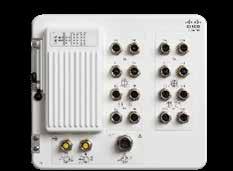
Cisco Catalyst IE3x00 family consists of Catalyst IE3100, Catalyst 3200, Catalyst IE3300, and Catalyst IE3400 Rugged Series and Catalyst IE3400 Heavy Duty Series of switches. These are DIN Rail and wall mounted switches built for harsh industrial environments.

Customer challenges and switch features
Consistent end-to-end network architecture: Oftentimes, operations networks have a patchwork of architecture with equipment from different vendors with their own management and security tools. This leads to unnecessary complexity and maintenance difficulties. Catalyst IE3x00 family is a part of a consistent, unified, and comprehensive Cisco networking architecture, extending from industrial assets to the enterprise and all the way to the cloud.
IT and OT collaboration: As operations networks expand and become more complex, IT skills are necessary to manage and secure them. Catalyst IE3x00 family shares key hardware components, IOS XE operating system, and is managed and secured by the same management and security solutions as Cisco’s enterprise switches. This consistency allows organizations IT and security departments to utilize their existing skills and investments for both networks using the tools they know and trust.
Equipment size: Network equipment that is installed in cabinets, for example by roadside, at traffic intersections, along oil and gas pipelines, etc., and other space constrained environments, needs to be compact to allow for all the other control equipment that is placed there. Catalyst IE3x00 family, in particular the Catalyst IE3100, provides advanced functionality in an ultra-compact form factor.
Turnkey complex machinery: Machine builders include industrial switches in their custom-built solutions. Besides requiring a
small switch to fit in the space they have, they need the switch to fit into their end customer’s networks, not open any security vulnerabilities, and be able to translate static IP addresses they assign at their factory to the actual addresses assigned at the customer’s network. Catalyst IE3x00 family provides Layer 2 Network Address Translation (L2NAT) capability to translate vendor assigned static addresses to integrate with the customer network for a seamless fit.
Modularity: Being able to add ports to an existing base unit helps extend the organization’s investment. They can add or move modules in sync with their needs. Catalyst IE300 and IE3400 come with a base unit and a variety of add-on modules for port expansion. These add-on modules come with fiber or copper ports for added flexibility.
Operating conditions: To deal with extreme operating situations such as outdoors in the open exposed to rain, snow, and other weather conditions, or exposure to chemicals or liquids, special network equipment is required. Catalyst IE3400 Heavy Duty Series is IP67 rated and built for such deployment conditions.
Visibility and security: Operations team often have limited visibility into connected assets and do not accurate asset inventory. Some operations networks are “flat” with no segmentation as policies to segment cannnot be defined in absence of visibility of traffic
flows. Certain models of the Catalyst IE3x00 family run the Cisco Cyber Vision sensor that provides the granular visibility needed for buiding asset inventories and defining policies for segmentation. The Catalyst IE3x00 family can further enforce these policies to segment the network such that it does not obstruct normal functioning but limits the scope of malware spread.
Power: Powered delivered over ethernet (PoE) is important to reduce wiring costs, added flexibility, and for sustainability. Catalyst IE3x00 family provides high-wattage power over high-bandwidth ports for devices such as high resolution cameras, Wi-Fi access points, digital signage displays, etc.
Resiliency: Operations network must be able to recover quickly from any faults as downtimes can be extremely disruptive to operations. Catalyst IE3x00 family incorporates a number of resiliency protocols to help maintain network integrity at all times.
Standards compliance: Accepted industry standards ensure interoperability of products that comply with those standards. The Catalyst IE3x00 family complies with various standards for electromagnetic emissions, industrial safety, operating environment, shock and vibration, corrosion, etc., it also complies with IEC 62443 that defines standards for security for industrial automation and control systems.
Common use cases
Given their breadth of features and capabilities, the Catalyst IE3x00 family is ideal for deployment in a variety of industry verticals including manufacturing, utilities, roadways and intersections, warehouses, and distribution centers, etc. These switches can help power equipment, reduce downtimes and outages, increase real-time visibility and security, among other benefits.
Futureproof industrial network to accelerate digital transformation
Industrial networks are evolving as the seamless transmission of data is becoming the key to success in the converged, digital future. Industrial networking solutions help businesses transform and futureproof their operations, and improve operational efficiency and resilience.
A NEXT-GENERATION NETWORKING PORTFOLIO provides a new lineup designed to futureproof industrial networks, accelerate digital transformation across various industrial applications and help organizations improve operational efficiency and resilience.

Running efficient business operations is becoming more difficult every day. Only when businesses futureproof their networks and embrace digital transformation can they respond quickly to changes. Besides just introducing new technologies, a key aspect of digitalization is the ability to seamlessly integrate all systems on the network.
“Industrial networks are evolving as the seamless transmission of data is becoming the key to success in this converged, digital future. At Moxa, we are dedicated to developing industrial network solutions that help businesses transform and futureproof their operations,” said Gary Chang, Product Manager at Moxa Networking.
Networks evolving to transform operations in every field
Digital transformation has fundamentally changed the requirements for industrial networking. For example, as net zero initiatives push organizations to heavily invest in renewable energy, power infrastructure needs to be able to adapt to variable and decentralized energy sources. Power grid systems need to be automated and secured to properly balance electricity supply and demand to avoid potential
downtime and maximize performance. Resilient, security-hardened industrial networks are critical for enabling complex connectivity while also keeping the network safe.
A similar trend is happening in the transportation field. With the prospect of connected and autonomous vehicles (CAVs) on the horizon, more devices will need to be connected to the road network infrastructure to allow agencies to monitor and manage transportation systems and ensure smooth traffic operations. Industrial networks need to support high bandwidth and reliability to handle any future increase in data volume processed over the network.
Following the supply disruptions in recent years, organizations also need agile and adaptive production plans to make sure they can keep up with market demand in unpredictable circumstances. The flexibility of the industrial networks is the key to success.
These are just some examples to demonstrate industrial applications are transforming, a process that requires secure, reliable industrial networks with high performance, bandwidth, and flexibility to enable the transition to a digital future.
Next-generation networking to futureproof digitalization investments
However, the pace at which industrial networks are evolving is becoming a key challenge for our customers, as they attempt to balance
investments made today and the expected future benefits. Futureproof, secure networking solutions provide a solid foundation for sustainable network infrastructure. With the IEC 62443-4-2 certified EDS-4000/G4000 Series DIN-rail switches and RKS-G4028 Series rackmount switches, we help our customers build robust, industrial-grade network security for their critical applications from edge to core.
Besides the increasing need for higher bandwidth such as 10GbE, applications in harsh environmental conditions also need to be able to deal with physical factors that can affect performance, such as heavy shock and vibration. Moxa’s MDS-G4000-4XGS Series modular DIN-rail switches feature 10GbE ports to reliably transmit real-time surveillance feeds and other highvolume data. Moreover, with multiple industrial certifications and a highly durable housing, the MDS-G4000-4XGS Series is a perfect fit for demanding environments such as mining sites, ITS, and wayside applications.
Lastly, to make sure customers can take advantage of any opportunities within the industry, Moxa delivers the tools to build a robust network foundation designed for future scalability. The modular RKS-G4028 Series and MDS-G4000-4XGS Series allow customers to design flexible networks that support scalable data aggregation in demanding environments.
Product highlight by Moxa.
Visit Website
Why Industrial networks need an IEEE 802.3bt Ethernet switch
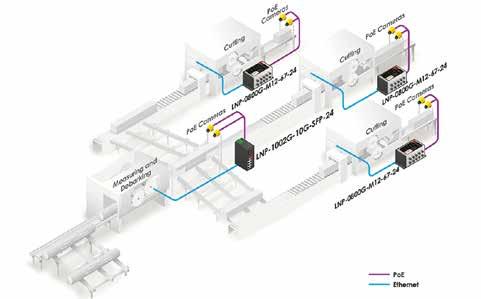
Managed and unmanaged industrial Ethernet switches are the most common type of industrial power sourcing equipment to embed IEEE 802.3bt technology. Below are five reasons to upgrade your existing Industrial Ethernet switches to models with IEEE 802.3bt.
SINCE THE RATIFICATION OF THE FIRST POE standard in 2003 by the Institute of Electronics Engineers (IEEE), Power over Ethernet (PoE) use cases have increased dramatically in industrial circles having made headway into factory automation, oil and gas processing, and utilities. IEEE 802.3bt, also known as PoE++, is the latest revision to the PoE standard.
Released in 2018, IEEE 802.3bt increases the amount of power supplied from Power Sourcing Equipment (PSEs) to Powered Devices (PD) nearly threefold by using all four pairs in the specified structured wiring plant, while significantly reducing the standby power required for PDs thanks to Short MPS. Inventive new features of IEEE 802.3bt also include Autoclass, 10G-BaseT with PoE support, Single/Dual Signature PD, and Power Class Levels. There are two types of IEEE 802.3bt: Type 3 delivers 60W from the PSE for up to 51W input power at the PD while Type 4 PoE delivers 90W from the PSE for up to 73W input power at the PD. Both types are backward compatible with 802.3af and 802.3at.
Managed and unmanaged industrial Ethernet switches are the most common type of industrial PSE to embed IEEE 802.3bt technology. Below are five reasons to upgrade your existing Ethernet switches to models with IEEE 802.3bt.
1. More power means opportunities
Unlike previous generations, IEEE 802.3bt has the muscle to support PTZ security cameras, sensors, level measurement devices, PLCs, 802.11ac and 802.11ax wireless access points, controllers, actuators, and LED lighting, among other high-power PDs found on factory floors. Besides supplying more power, an 802.3bt switch plays its traditional role of creating reliable networks for connected devices to communicate and exchange data.
2. Improved network reliability
Gartner estimates that one minute of downtime for an industrial network cost $5,600 (USD) on average or approximately $300,000 an hour. An industrial switch with 802.3bt will help to improve the reliability and uptime of your industrial network by providing redundant connections and failover mechanisms.
3. Real-time control & communication
IEEE 802.3bt expands support for Ethernet data speeds up to 10 Gigabits per second. This is significant because the growing majority of operations technology (OT) applications require real-time control and communication to cut costs and push efficiency. Consider this example: instructions are sent from a presence sensor to a robotic arm when it detects a part is ready to be picked up. Next, the arm must precisely places the part onto a moving assembly belt. Here, time-critical information must reach all machines without latency. An IEEE 802.3bt switch is optimized so that OT networks remain highly responsive and reliable.
4. Flexible installations
Like all versions of PoE, IEEE 802.3bt is standards-based. This means interoperability across vendors of multiple PDs from a single industrial Ethernet switch. It also means that third-party non-PoE PDs will be detected and therefore not damaged by power transmitted on the CAT cable by the industrial switch. Many industrial switches with IEEE 802.3bt also enable the configuration of network topologies, such as ring, mesh, and others. Plus, they’ll support RSTP/STP, IGMP, and VLANs. Finally, backward compatibility is not sacrificed for IEEE 802.3bt’s increased wattage. Ethernet switches equipped with IEEE 802.3bt
will work with existing PD types standardized in IEEE 802.3af and IEEE 802.3at.
5. Industrial Internet of Things
IIoT technology is becoming increasingly sophisticated and more power-hungry. Until IEEE 802.3bt was introduced, the most power that IIoT networks have been able to transmit on a single port has been 60W. IEEE 802.3bt takes a big step forward with 90W. Safe delivery of 90W over one cable enables the speedy implementation of a host of IIoT technologies.
Antaira industrial PoE switches with IEEE 802.3bt give users the freedom to design your plant’s layout exactly as you want. IEEE 802.3bt means power lines do not have to be run, and PoE-enabled devices can be installed in previously inaccessible places. Plus, more devices can be run by a single Antaira Ethernet device transmitting both power and high-speed data.
Like all Antaira network solutions, Antaira’s industrial IEEE 802.3bt switches are ruggedly designed for industrial environments subject to wide temperature fluctuations, heavy vibration, shock, and EMI.
Henry Martel, Field Application Engineer, Antaira. Visit WebsiteUnderstanding options for remote access control
VPN solutions accommodate a variety of remote access needs. A RemoteVPN subscription service offers secure remote communication without maintaining a VPN server. Self-HostedVPN and BridgeVPN solutions allow users to set up and maintain secure remote access without subscription fees and the need for a cloud-based VPN server.
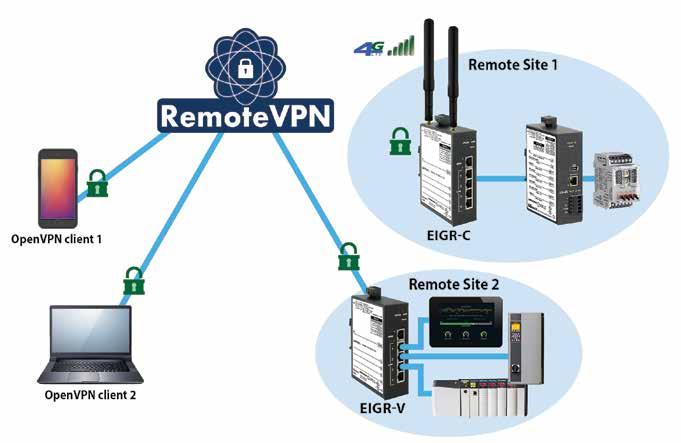
A VIRTUAL PRIVATE NETWORK (VPN) CAN provide secure access to remote job sites, while giving systems integrators the flexibility to monitor and maintain systems from the convenience of their home, office, or any location with Internet access. This secure remote access control allows systems integrators to deliver 24-hour monitoring as well as real-time alarm response, troubleshooting and maintenance which will minimize system malfunctions and downtime.
However, deciding which VPN is the best one can be confusing. Which VPN service should I use? What are the features, capabilities, and limitations? Can I maintain my own VPN?
Contemporary Controls offers three VPN solutions to meet remote access needs—our RemoteVPN subscription service, and our SelfHostedVPN and BridgeVPN solutions.
These VPN solutions utilize OpenVPN® which is a well-supported open-source VPN
technology that incorporates SSL/TLS security with encryption. Contemporary Controls’ Skorpion IP routers include models that support OpenVPN client or both client/server functionality. The EIPR-V, EIGR-V series, and EIGR-C series Skorpion IP routers support OpenVPN client functionality for use with the RemoteVPN subscription service. EIGR-V and EIGR-VB routers can be configured as VPN servers for our Self-HostedVPN and BridgeVPN solutions.
RemoteVPN subscription service
Contemporary Controls’ RemoteVPN subscription service provides secure communication and the convenience of remote access without having to maintain the VPN server. Hosted on the Internet and maintained by Contemporary Controls, RemoteVPN incorporates a cloud-based OpenVPN server, OpenVPN clients for workstations and mobile
devices, and OpenVPN routers installed at job sites. In addition to the RemoteVPN subscription service, Contemporary Controls offers Self-HostedVPN and BridgeVPN solutions which allow users to set up and maintain their own secure remote access without subscription fees and without the need for a cloud-based VPN server.
Self-HostedVPN solution
For network savvy users, a Self-HostedVPN solution utilizes the EIGR-V Skorpion Gigabit IP router configured to operate in OpenVPN server mode. This allows the router to act as the VPN server capable of supporting Contemporary Controls’ wired and cellular routers as VPN clients. This Self-HostedVPN solution provides wired or wireless remote access for multiple clients—up to 15 wired/ cellular IP routers in OpenVPN client mode and 15 OpenVPN clients on PC/tablet/phone.
BridgeVPN solution
For single-site, remote access solutions, the BridgeVPN solution utilizes the EIGR-VB Gigabit IP router configured to operate in OpenVPN server mode as a wired bridge VPN server. This BridgeVPN solution can support up to 10 VPN clients on Windows/Linux PCs. These Self-HostedVPN and BridgeVPN OpenVPN clients can be located anywhere that has Internet connectivity.

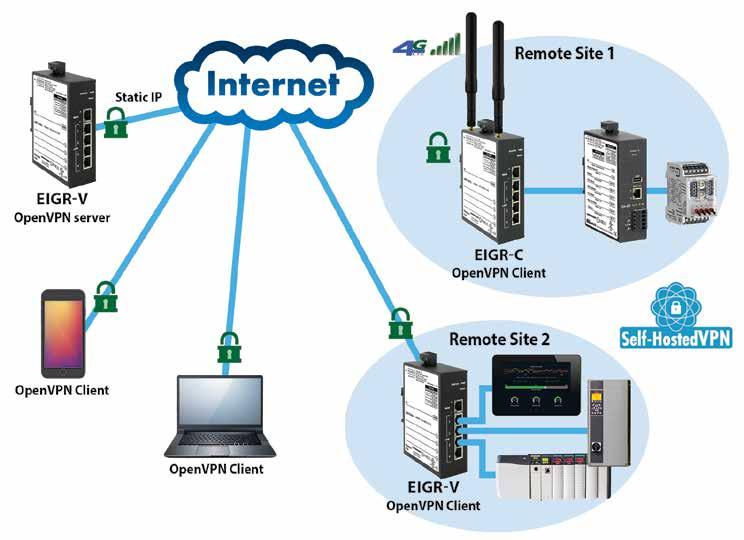
Conclusion
Remote access using VPN allows systems integrators to perform diagnostics and resolve issues in real time. Contemporary Controls’ VPN solutions can accommodate a variety of remote access requirements and network capabilities. Utilizing OpenVPN technology, the RemoteVPN subscription service provides secure remote communication without the added burden of maintaining a VPN server. Self-HostedVPN and BridgeVPN solutions allow users to set up and maintain their own secure remote access without subscription fees and with all the configuration easily completed via the IP router webpage.
Kathy Neumeyer, Technical Writer, Contemporary Controls.Visit Website
The power of managed Ethernet switches in industrial settings
APPLICATION DIAGRAM

Easy setup, simple diagnostic tools, advanced security
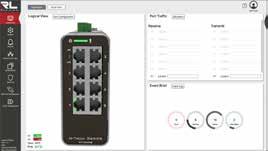
BEGINNING IN THE EARLY 2000 s , MANY industrial operations began the move to build digital communications and digital backbones into their production platforms. As is well known, there were both proprietary networks and Ethernet-based systems being deployed.
In part, this development was driven by the rapid growth of office-based Ethernet networks and network technology. Manufacturers from a broad range of industries wanted to have the increased level of digital data, sensor information and data from manufacturing devices – such as PLCs and intelligent servo drives – to give better control and management of production systems.
In many cases, these networks were built using unmanaged Ethernet switches – able to handle the network traffic, but without the sophistication managed Ethernet switches offer. Two of the biggest drawbacks of unmanaged industrial Ethernet switches are loss of network visibility and network control, along with increased risk of security breaches from having vulnerable devices on the network.
As the Industry 4.0 revolution proceeds, more and more industrial systems and facilities that were previously isolated, standalone operations are being upgraded with digital sensors and smart devices – and
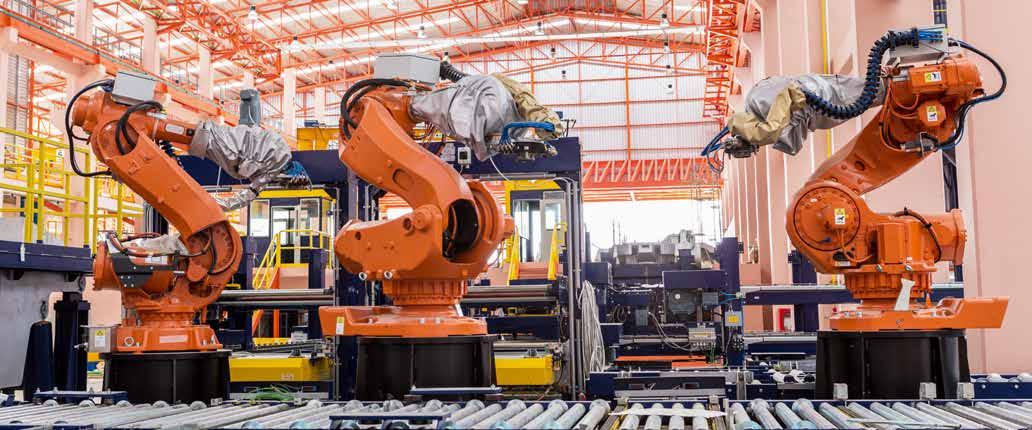
those previously isolated systems are being tied to Ethernet-based networks, ultimately exposing them to the Internet. As industrial Ethernet networks grow in size, the focus on security, on having visibility into what is being connected to the network, if it has the right permissions and if it presents any risk of infiltration of malware – becomes increasingly important.
Risks of unmanaged Ethernet switches


As industrial networks are built out, there has been an increasing drive to connect previously isolated manufacturing systems. This connectivity drive makes sense: many of these manufacturing systems have been generating valuable data, but getting access to that data in real time has required significant investments in industrial networks.
As a result, in some cases, industrial OT organizations have tried to manage costs by using less sophisticated unmanaged Ethernet switches. This approach leaves out the layers of protection and network traffic control that managed switches offer.
Industrial Ethernets are constantly transacting time-sensitive data, in some cases vital input/output (I/O) signals. Responsive I/O and interlock signaling plays a crucial role
in preventing equipment failure or damage, wasted product and data loss.
Robust and hardened Industrial Ethernet switches, such as the Red Lion N-Tron® Series NT5000 managed switches, are readily available. Unlike some products on the market, which have been adapted from Ethernet technology used in office networks, these systems have been engineered and manufactured for reliable operation in industrial environments with high levels of vibration and ESD and surge protection.
For a standalone automated production system, such as a bottling machine, the internal network in the machine typically needs to connect the machine’s programmable logic controller (PLC), human machine interface (HMI), sensors and other I/O connected devices, a low-cost unmanaged switch connecting the machine’s PROFINET or Ethernet I/P backbone was sufficient.
However, those kinds of machines are quickly being replaced by automation networks. Once the network device count goes higher, or a formerly standalone piece of automated equipment is interconnected in a plant with dozens of other systems and intelligent devices on virtual local area networks (VLAN), the need for a managed industrial Ethernet switch quickly becomes apparent.
Security becomes paramount
Unmanaged switches do not have the software layers managed switches have to exercise real control over how traffic traverses a network and what devices can be attached. With unmanaged switches, it’s possible for anyone to plug a PC into the switch and access that network segment, potentially finding pathways into larger parts of a manufacturer’s OT or IT platforms.
Managed Ethernet switches can provide what is often referred to as “defense in depth”. This concept was incorporated into and formalized in the ISA/IEC 62443 series of standards that define requirements and processes for implementing and maintaining electronically secure industrial automation and control systems (IACS). These standards set best practices for security and provide a way to assess the level of security performance.
Following these standards, managed industrial Ethernet switches have multiple overlapping layers and features to provide the maximum amount of protection against a risk factor. If someone wants to add a device or PC to a system with a managed network switch, these overlapping layers can include advanced password encryption capabilities, MAC security, configurable password length and multi-level user access control. Managed Ethernet switches can be easily programmed to automatically disable user or port credentials after a set number of failed access attempts.
Many hacker groups and internet criminals continually target the industrial elements of corporate networks, in part because many still have unmanaged Ethernet switches that provide vulnerable access points they can exploit. With these kinds of features, the industrial network can be equipped with the same password management, control and updating practices established by the IT department for the rest of the company, elevating security and implementing the kind of defense in depth that is vitally necessary for dependable and active cybersecurity.
Improving network traffic and easing configuration
Industrial Ethernet networks are becoming increasingly complex and traffic heavy. To minimize networking delays, and therefore improve the level of determinism on any network, it is important that communication data packets be transmitted from the source to the target device. When packets are transmitted where they are not needed, destination devices expend resources to handle the packet, delaying processing of critical communication.
Managed switches give automation engineers exceptional control over these kinds of issues. For example, in a large machining department with multiple machine tools networked together, each work cell may have
multiple devices within each tool – such as variable frequency drives (VFD) – generating high volumes of network traffic.
That VFD data may be useful for preventive maintenance and system performance tracking, but it may not be necessary for that data to also be passed up to the PLC in the work cell. Managed Ethernet switches like the Red Lion NT5000 have sophisticated access control lists that automation engineers can use to define that – for a specific MAC address – the broadcast would never traverse the link that goes to the PLC.
This same feature can also be used to limit what additional devices or network links can be connected to a particular uplink port. That can also help ensure a given work cell or automation network segment has its traffic properly managed.
It may appear managing these kinds of traffic and network security features can be time-consuming and complex. However, many leading industrial Ethernet managed switches have been designed for fast, easy, virtually “plug-and-play” installation and configuration.
For example, the Red Lion NT5000 Gigabit Managed Ethernet Switch features a quick start wizard that walks administrators through switch configuration for fast deployment. It also supports text-based configuration files, making it easy to retrieve the configuration from one device for redistribution to other NT5000 devices being added on the network.
This is especially valuable in industrial environments where integrating managed Ethernet switches is often assigned to controls or automation engineers, whose backgrounds and training aren’t necessarily grounded in Ethernet network configuration tasks and processes. With managed Ethernet switches,
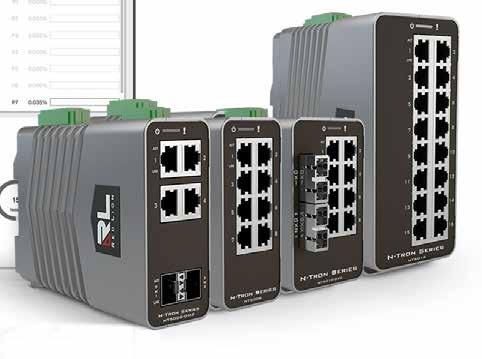
it can be as easy as powering up the switch, adding an IP address and configuring the device to conform to all the password and network security protocols for that part of the network.
The latest generation of switches come pre-configured, supporting all the necessary protocols – such as IGMP snooping. Many platforms feature simple graphical user interfaces that include a logical view showing active ports, power supply, temperature and contact relay status, along with color-coded gauges for port traffic and event tracking. This lets administrators quickly identify and address possible network disruptions in real-time, backed up by diagnostic tools that allow for faster analysis and isolation of network issues to help maximize network uptime.
The value of industrial data
Many manufacturers recognize their most valuable asset is their industrial data. In Industry 4.0, as they implement or upgrade their industrial networks to take full advantage of the speed and power of industrial Ethernet systems, there are clear advantages to investing in managed industrial Ethernet switches.
They give industrial users easier, more secure and more reliable access to all that valuable data, with state-of-the-art features to minimize cybersecurity risks and give plant managers critical visibility and greater control of their industrial networks.
Barry Turner, Technical Business Development Manager, Red Lion Controls.Visit Website
Smart grid implementation for accurate gas management
Monitoring a natural gas supply network with EtherCAT terminals is designed for explosion protection. In terms of economic efficiency, the use of EtherCAT Terminals has led to significant cost reductions, according to Gaznat. Retrofitted stations show savings of around 50% compared to conventional systems.
IN WESTERN SWITZERLAND, THE STATIONS operated by Gaznat for the management of natural gas supplies are gradually being equipped with new monitoring equipment. The energy provider is working with Beckhoff Switzerland to achieve greater efficiency and accuracy, particularly by using ELX terminals for the direct connection of intrinsically safe field devices. In addition, this approach simplifies the processes required for data extraction, minimizes installation effort and considerably reduces costs.
Gaznat S.A., based in Vevey, operates stations where an essential process in the gas industry is carried out: The so-called gas depressurization refers to the pressure reduction necessary for the natural gas to be forwarded to consumers. This reduces the gas pressure from approx. 38 bar to a value below the prescribed threshold of 5 bar. Subsequently, the natural gas is delivered to the local public utility, which assumes responsibility for subsequent delivery to local residents, other end users and industrial consumers.
Acting as an intermediary between the natural gas suppliers and the various municipal utilities and regional entities responsible for the local networks, Gaznat transports an annual energy equivalent of more than 13 TWh. The company's main task is to set up, maintain and operate the high-pressure transmission network in western Switzerland – some 600 km of gas pipelines as well as 50 pressure-reducing and metering stations. Gaznat employs 62 people at its Vevey and Aigle sites.
Digitalization of gas transport infrastructure
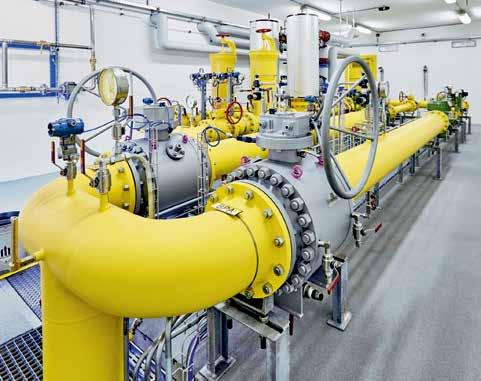
To secure, manage and remotely control its network, Gaznat requires digital and electronic solutions tailored to the technical specifics of its various plants. The infrastructure of the stations includes a large proportion of mechanical equipment, but is also equipped with state-of-the-art electronics, which is a prerequisite for digitalizing the gas supply network. The gas infrastructure – the same as the electrical power grid – is currently trending toward widespread adoption of smart grid systems and devices. According to Gaznat's experience, the digitalization of
the gas infrastructure is much facilitated by Beckhoff products: In the control cabinets of the gas pressure control system, the innovative strenght of the automation company is evident in the wide range of EtherCAT I/O components, particularly the ELX terminals for explosion protection applications. The ELX range used comprises digital and analog 12 mm and 24 mm terminals, respectively, which
ELX1058 EtherCAT Terminal
can be used to directly acquire the signals from field devices installed in station sections through which gas flows.
This means that all data points within the plant can be connected directly to EtherCAT Terminals, both in standard and hazardous areas. This greatly simplifies overall installation and wiring, and intermediate devices such as intrinsically safe barriers or
The ELX1058 digital input terminal allows the direct connection of intrinsically safe NAMUR field devices installed in hazardous zone 0/20 and 1/21 areas, and acquires their signals according to IEC 60947-5-6. The sensors are supplied with a voltage of 8.2 V and return a diagnosable current signal. This means that wire breakage and short-circuits can be detected in addition to the current switching state. The LEDs indicate the signal states as well as any error states. On the software side, it is possible to define whether a positive or negative switching sensor is connected for each channel. This means that both NAMUR break contacts and make contacts can be integrated into the control system without any changes. In addition, the error LEDs can be switched off, which enables the connection of potential-free contacts without any errors being displayed.
https://www.beckhoff.com/elx1058
other signal converters are dispensed with completely. As a result of the large selection of EL series EtherCAT Terminals available, Gaznat says it has found all the connectivity options it needed, e.g. for monitoring the power consumption with the EL3443 and SCT current transformers, the lighting status in the station and the control data for heating
the gas. All this data is then transmitted via the Modbus coupler to the control system for further processing. From Gaznat's point of view, the advantages of the solution are its high flexibility and modularity as well as the comprehensive portfolio of EtherCAT Terminals. Regarding a particular advantage of the ELX terminals, Bertrand Luisier, Automation
Manager at Gaznat, explains: "Beckhoff has developed special firmware for us to use with the ELX1058 8-channel digital input terminal –for connecting intrinsically safe NAMUR field devices – which enables direct interfacing with a gas volume meter. This dispenses with the device normally used for data acquisition from this sensor.
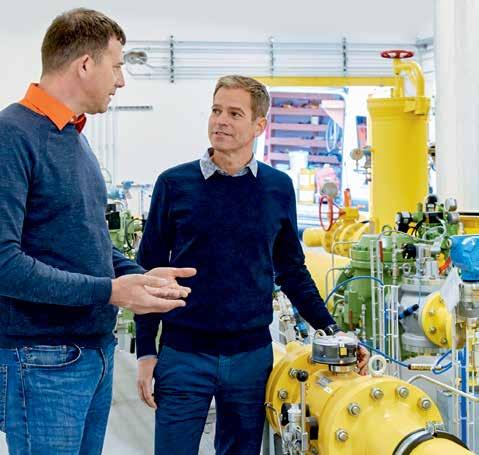
Meter information is passed directly to the control system without the need for a serial interface, as was previously the case. It is a great advantage that Beckhoff can respond quickly to such specific customer requirements with its product development team. Ultimately, this implementation, which provides a connection between station data and system monitoring by network operators, now requires fewer electronic devices because the need for traditional safety barriers has been eliminated. In terms of space, everything now fits into one large control cabinet, whereas it used to take two to three."
Significant cost reductions
In terms of economic efficiency, the use of EtherCAT Terminals from Beckhoff, and the ELX1058 in particular, leads to significant cost reductions, according to Gaznat. For example, retrofitted stations show savings of around 50% compared to conventional systems, which is equivalent to many thousands of Swiss francs. In addition, troubleshooting is also simplified.
https://www.gaznat.ch
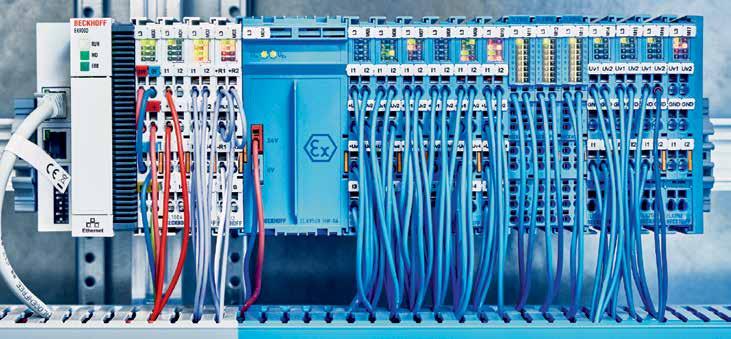
Universal I/O: a simpler path to smart process plants
Universal I/O is a relatively young technology that will continue to deliver value to process operators. Advances combined with the benefits of universal I/O will mean process operators can expect more efficient workflows and fewer headaches when deploying new and smarter process applications.
LIKE EVERYONE TODAY, PROCESS OPERATORS are trying to reduce costs and project execution times. Smart manufacturing can help them do this in several ways, from digital engineering tools that can reduce cost and risk in the design stage, to smart sensors and instruments that can provide deeper insights into processes. But to deploy these capabilities, process operators are realizing they need to rethink how they manage the flow of data to and from their process devices. Control systems in process operations have historically been designed and built with a set number and type of I/O modules. But these rigidly defined I/O layouts can be costly and difficult to change throughout a control system’s lifecycle.
During commissioning, for example,
modifying an I/O layout to accommodate last-minute changes to the control system can throw a project off schedule and off budget.
A seemingly simple change from analog input to digital input can require a new I/O module, potentially a new rack to house that module and a mess of wiring changes. And later, after a process is operational, new I/O cards can only be added if space is available for them in the enclosure.
These challenges are driving process operators to embrace universal I/O, which allows different I/O types to land on one I/O card. This greater flexibility can minimize the impact of late changes to the I/O and make projects overall more efficient, and make it easier for process operators to deploy smart devices throughout the life of a process.
The universal I/O difference
Traditional I/O requires that process operators use separate I/O modules for analog-in, analog-out, digital-in and digital-out connections. And while four card types isn’t a lot, they can create some big challenges.
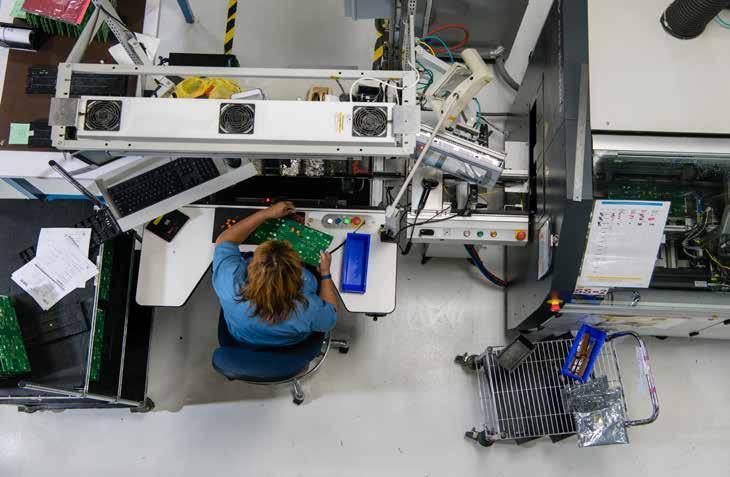
Just consider the typical process used to implement distributed control systems (DCS) in process plants. Activities like system sizing, enclosure and system design, system configuration, factory acceptance testing (FAT), installation, and site acceptance testing (SAT) and commissioning happen one after another. These serial workflows make projects inherently inefficient because teams can’t work in parallel.
An even bigger problem is that system changes can happen late in projects. This
leads to teams having to redo activities and potentially make card and wiring changes to the physical I/O that’s already been installed in the enclosure. These physical changes are not only costly but can also push back project timelines.
Universal I/O can make DCS projects more efficient because now it doesn’t matter where signals are landing – they’re all going to a universal I/O module. Control engineers can configure a control systems’ logic and displays, while at the same time another team designs and builds the enclosures. This parallel work can make better use of people’s time and shorten project timelines. And because universal I/O allows devices to be swapped out without changing I/O cards or wiring, late project changes are easier to accommodate.
Universal I/O also simplifies long-term changes. Process operations are rarely static. New processes are added. Efforts like debottlenecking projects are made to improve processes. And new devices are installed to create smarter, more efficient operations.
With traditional I/O, process operators need to plan for these changes by not only leaving open I/O capacity in their control panels but also stocking up multiple different I/O modules. Universal I/O allows process operators to stock only one type of I/O module and even reuse I/O modules for different purposes.
It’s also important to remember that universal I/O is just one part of a DCS. And by using a modern DCS with digital engineering capabilities, even greater savings are possible.
For example, a DCS that uses virtual image templates, or virtual appliances, allows engineers to build system elements – like process automation system servers, historians, and operator and engineering workstations –in a virtual environment. This allows those system elements to be built and configured more quickly, because engineers don’t need to wait for physical hardware to be in place.
Design tools that are available in the cloud can also accelerate projects by allowing distributed teams to design, build and test control code from a browser.
Enabling smarter processes
Process operators can use universal I/O modules in many ways to support and ease digital transformation initiatives.

For starters, the modules can give plant personnel access to helpful, contextualized information about the devices themselves to help reduce downtime.
Today, engineers typically need to write special code to monitor I/O modules for issues. But universal I/O modules with built-in diagnostics can automatically provide information about device health and faults on specific I/O channels. This can help technicians not only know that something is
wrong, but also identify what the specific issue is and where it’s happening so they can quickly address it.
Process operators can also use universal I/O to add smart devices more easily to their operations.
Today, smart sensors and instruments can provide deeper visibility into processes and advance warning of potential problems, both of which can help plant personnel optimize operations and reduce unplanned downtime. With universal I/O, all the work that needs to be done to add these devices, from adding a backplane, to installing and configuring the smart device, can be done while a process is running. This can help process operators create the smarter, data-driven processes they need to compete with minimal disruption to their daily operations.
Another activity that universal I/O modules can help simplify is adding redundancy to process operations. Specifically, highavailability modules can be deployed in duplex configurations, allowing engineers to land just one wire for both the standard and redundant modules. This can save time and effort compared to setting up two separate modules side by side and using special wiring and coding to create redundant I/O modules.
Of course, security is always top of mind when deploying smarter, data driven process operations. Universal I/O modules can support a defense-in-depth security strategy with security measures like firmware encryption,
module vendor certificates and secure boot functionality.
What’s next?
Universal I/O is still a relatively young technology. It will only continue to evolve and expand in the coming months and years to deliver more value to process operators.
Soon, for example, integrated safety I/O and high-availability safety controllers will be available that allow integrated safety I/O and base process control I/O to be mounted in the same rack. This will help reduce hardware complexity and the overall system cost in DCS projects.
New options like smart junction boxes that can be used with universal I/O are also emerging. These prebuilt and prewired enclosures with field termination panels for I/O further simplify DCS projects by reducing engineering and minimizing the work that needs to be done to deploy DCS projects at a process plant.
These advances combined with the benefits of universal I/O mean process operators can expect more efficient workflows and fewer headaches when deploying new and smarter process applications.
Learn More
Mitigating extreme climates through IoT remote monitoring
IoT remote monitored is achieved using a data logger that provides a powerful tool and enables applications to become more intelligent and versatile. It can easily function as a data acquisition device to query PLCs and transmit information through NB-IOT/Cat-M1, lowering the cost of equipment construction and maintenance.
SMART MONITORING SYSTEMS ARE INCREASINGLY being deployed in areas susceptible to heavy summer rainfall, such as river embankments and low-lying regions, to mitigate the risk of flooding caused by rising sea levels and global warming. Additionally, these systems are being utilized to address water scarcity issues that arise from prolonged periods of drought.
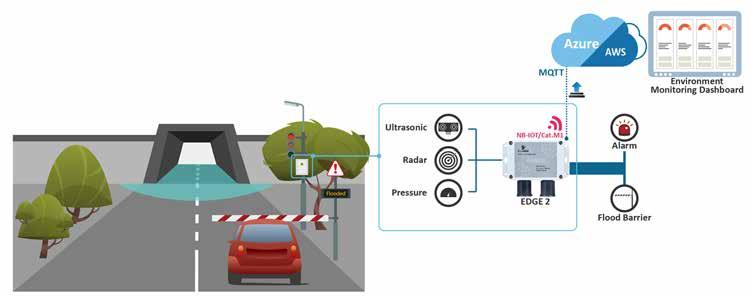
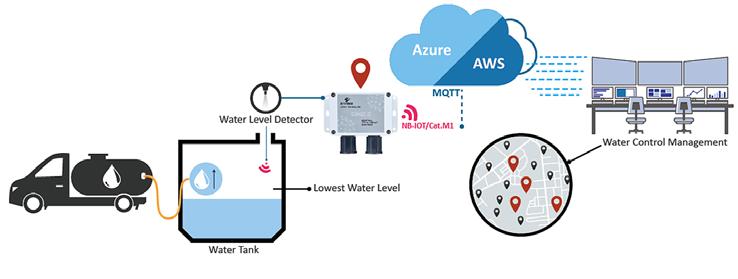
Using Taiwan as a case study, it can be observed that the country is completely encircled by the ocean. During the summer season, intense typhoons often result in
regional flooding, while prolonged dry spells can lead to low reservoir levels, posing a threat to the livelihoods of the populace. Consequently, the Taiwanese government has been confronted with the challenges of monitoring floods and implementing emergency measures to address drought situations.
The Challenges
Temporary Water Stations for Livelihoods during the Dry Season: However, low water levels and
insufficient water pressure in some reservoirs can prevent water delivery to households.
To address this issue, local governments set up numerous temporary water storage stations that rely on tanker trucks for transportation. Nevertheless, monitoring the water quantity data of these temporary stations poses a challenge. Inspection can only be done manually, resulting in higher labor costs and significant reporting delays.
Enhancing Flood Control Measures with River Embankment Gates and Drainage Facilities:
Challenges Solutions Benefits
Wired system deployment is not easy
Personnel maintenance and management are not easy
Device power management
Sensor power consumption management
Difficulty obtaining on-site electricity
Remote control requirements
Immediately judge and react after acquiring data
Resistant to harsh outdoor environments
Using wireless technology such as NB-IOT, Cat-M1 cellular base stations, remote control can be applied anywhere where a mobile phone can receive a signal.
NB-IOT and Cat-M1 simplify data volume with low monthly fee.
LPWA devices are designed for low power consumption and can enter sleep mode
Sensor power consumption is often ignored, so the LPWA Device must include sensor power management.
Battery or solar power solution
The collector needs to be able to receive commands from the control center to control DO and Modbus commands.
The event function can set the threshold to link digital out and shorten the upload cycle.
Waterproof and able to function in wide temperature ranges, waterproof grade of IP65, and temperature resistance of -30 ~ 70°C
River embankment pumping stations are typically unmanned facilities that rely on fuel-operated drainage equipment. However, the risk of fuel shortages during critical drainage needs requires manual patrolling and supervision, resulting in labor-intensive and time-consuming processes that come with additional costs.
Designing a Reporting and Warning System for Accumulated Water in Low-Lying Areas: Heavy rainfall can cause disasters such as water accumulation in low-lying areas. Instant flooding in these regions necessitates swift notification and evacuation to prevent the disaster from escalating.
Notification systems and on-site warnings can alert drivers to flooded areas, saving lives and ensuring safety. However, the sites for these systems are primarily located outdoors, exposing equipment to wide temperature variations that can damage it over time. Additionally, wired communication systems are challenging to use effectively due to the large area that needs to be covered.
Solutions?
Through the analysis in the table above, we can discover solutions corresponding to derivative technologies under environmental constraints.
Applications
Below are three case studies showcasing intelligent disaster response systems developed by government agencies to address drought and flood control during extreme weather conditions.
Case 1: Developing a Water Supply System for Dry Season Water Storage Tanks
When the reservoir's water level is low, there is not enough water pressure to distribute it to different areas, causing a shortage of water supply.
As a solution, local governments set up large water storage containers in various locations around the countrty to temporarily meet the demand for water.
These storage containers are equipped with
Reduced infrastructure construction costs
Reduced maintenance labor costs
Reduced equipment power costs
Remote monitoring and control
Stable operation in harsh environments.
remote monitoring systems that transmit real-time water level data to the water supply unit. Upon receiving an alert for water shortage, the water supply unit dispatches a water truck to refill the storage container on site.
How does this system work?
Upon awakening from sleep mode every 10 minutes, the EtherWAN EDGE-2 Device equipped with NB-IOT/CAT-M1 will retrieve water data from temporary area water supply storage tanks. Subsequently, the data will be transmitted to the cloud either via MQTT or AZURE/AWS. Once the cloud program analyzes the data, it will send a notification to the water tanker to refill the storage tanks.
Case 2: Deals with the fuel management of forced drainage equipment situated in low-lying areas
In unmanned flood control pumping stations used as drainage systems, monitoring the fuel tank level is crucial. Fuel levels can decrease over time due to natural volatilization or
frequent usage, and it is essential to manage them by remotely monitoring the fuel levels for maintenance purposes.
How does this system work?
The EtherWAN EDGE-2 Device monitors diesel fuel storage levels every hour and queries the PLC pressure gauge data via RS485/Modbus. The gathered data is then transmitted to the cloud via NB-IOT/Caowem analyzes the data and dispatches personnel for refueling as required.
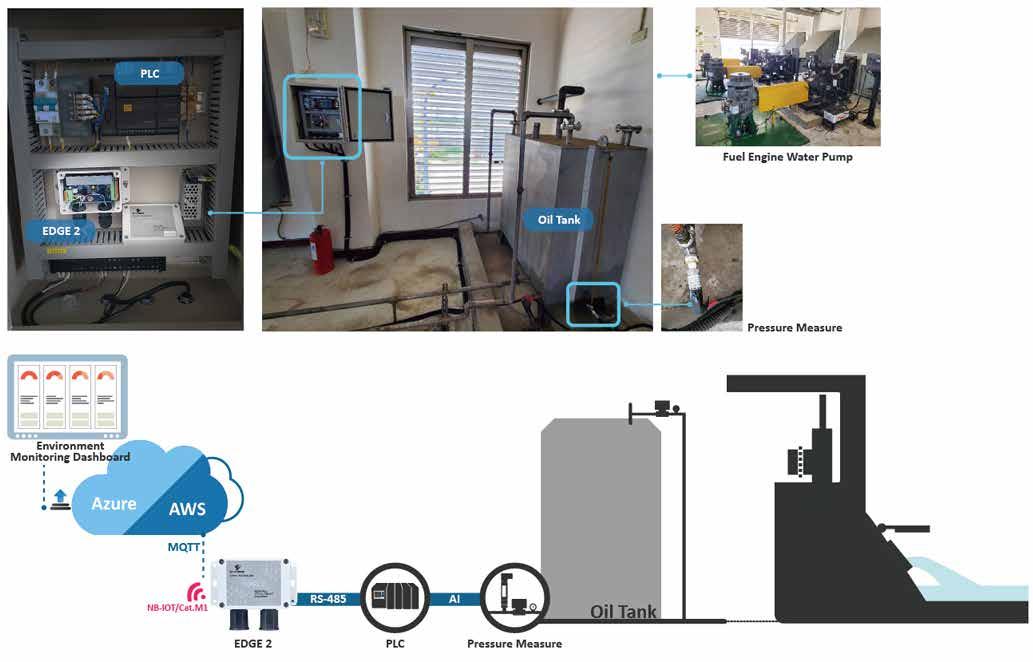
In the past, diesel storage levels were recorded manually, but with the EtherWAN EDGE-2 Device capturing data via the cloud, maintenance and labor requirements are streamlined.
Case 3: Flood warning and notification in low-lying areas, and river water level monitoring
In abnormal weather, sudden heavy rains often lead to water accumulation in low-lying areas, seriously endangering people's lives. Therefore, the low-lying flood warning notification system allows for on-site remote monitoring and emergency response to prevent flood disasters in real time.
How does this system work?
The water level monitoring equipment in low-lying areas is equipped with the EDGE 2, which is typically in low-power sleep mode.
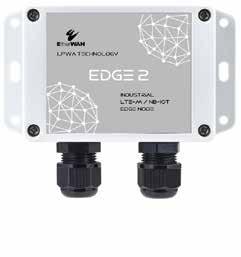
It wakes up every ten minutes to retrieve data from AI/DI/RS-485 sensors, which is then uploaded via NB-IOT/CAT-M1. The EDGE Device system concurrently checks if there is any flooding on the site, and if detected, alerts personnel not to enter and close the flood barriers. The data capture and upload interval has been reduced to every 5 minutes, enabling disaster prevention and control to be carried out more promptly.
Moreover, this flood control mechanism has extended river water level monitoring capabilities, which functions similarly to detect the water level and immediately trigger
an alarm when the river water approaches the warning level. This helps to reduce the occurrence of disasters.
Note: The EDGE Solution includes 50AH 3.6V battery power configuration. The voltage is boosted to 12 volts through the power control board and supplied to the sensor; when the EDGE-2 enters sleep mode, it will stop providing power to the sensor to achieve power saving.
Conclusion
The EDGE2 data logger is a powerful tool that enables applications to become more intelligent and versatile. It can easily function as a data acquisition device to query PLCs and transmit information through NB-IOT/ Cat-M1. As wireless transmission is employed, there are no challenges associated with wired deployment.
Furthermore, the EDGE2 data logger utilizes the low-rate cellular base station of the ISP for data transmission, enabling it to operate in any area with mobile phone signal coverage. This not only simplifies transmission, but also significantly lowers the cost of equipment construction and maintenance.
Technology article by EtherWAN.
Network connectivity solution for automated container ports
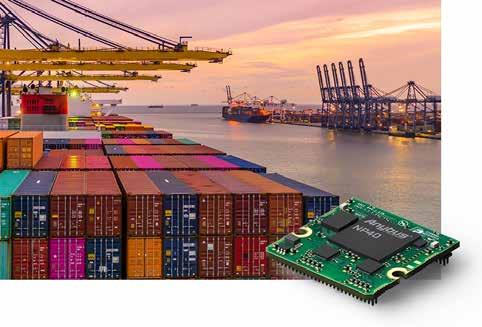
To achieve the level of dynamic control required for multi-ton loads of shipping containers traveling in three dimensions at high speed, data must be collected from several sources in real-time and processed instantly, so that the exact position and velocity are always known and can be adjusted.
THE DRIVE TO INCREASE THE EFFICIENCY of international shipping relies on highperformance cranes to transfer containerized cargo quickly and safely from ship to shore. BTG specializes in developing, producing, and installing positioning measurement systems for automated container ports.
Much of the company's work is based on providing sensors to enable cranes to move cargo from ships to automated guided vehicles (AGVs). But the networking is complex and demanding. The cranes and AGVs often use different industrial networks, yet they need to transfer real-time data in harsh environments. That’s where Anybus steps in. Anybus takes care of the networking allowing BTG to focus on the position measurement systems, and together they help to increase the efficiency in automated container ports.
When BTG needed their IRM400 range of positioning measurement systems to send real-time data over different industrial networks, they found Anybus from HMS Networks.
About BTG
One of BTG’s key products is the IRM400 range of measurement systems. It is designed to control sway, skew, and inclination and thereby provide accurate position control of the crane’s spreaders and their precious cargo. Designed as a series of modular elements, the IRM can be configured for many different types and sizes of cranes. The system consists of an infrared transmitter and a high-resolution receiver unit. The transmitter is mounted on the spreader of the crane, and the receiver is mounted perpendicular above the transmitter. The system constantly measures the sway angle of the load in flight in all directions. It also measures the spreader skew angle and optionally the trim and list angle.
To achieve this level of dynamic control of multi-ton loads traveling in three dimensions at high speed, data must be collected from several sources in real-time and processed instantly so that the exact position and velocity are always known and can be adjusted.
BTG's IRM Spreader Measurement Sensor consists of a transmitter and a receiver. The Anybus CompactCom B40 was embedded into the receiver.
“We have a lot of experience and knowledge
with position measurement systems in tough industrial environments, but we are not experts in industrial networks,” explained Daan Potters, chief operating officer at BTG.
Networking requirements
BTG required a networking technology that could be embedded into the IRM sensor, allowing the sensor to communicate over PROFIBUS, PROFINET, and CANopen networks.
As BTG is a global company and different networks are dominant in different parts of the world, BTG also needed the possibility to easily cover more networks in the future. The networking solution also needed to be compatible with legacy equipment, tough enough to handle marine environments, and fast enough to process real-time data communication.
Anybus from HMS Networks is a product brand specializing in connecting industrial devices to any major industrial network. There’s a CompactCom product for the integration of any major Fieldbus or industrial Ethernet network, including PROFIBUS, PROFINET, and CANopen networks.
Embedded design
The CompactCom is embedded into the relevant device, in this example the sensor’s
receiver. The embedded design brings several benefits. It’s simple to install and therefore reduces the time to market for new products.
It’s possible to reuse legacy equipment, enabling BTG to retrofit new electronic control systems to existing cranes. The CompactCom can be embedded in an IP67-rated enclosure, ensuring that the equipment can handle the harsh conditions found in marine environments.
Real-time communication
The Anybus CompactCom provides highperformance data exchange that can handle even the most demanding synchronized motion applications - up to 1448 bytes of process data in each direction.
“We chose the CompactCom B40, and we’re pleased we did”, Potters said. “The CompactCom B40 solved all our networking needs, it’s compatible with all the required networks, and it provides real-time communication, which is essential in position measurement systems. Anybus also provided excellent support to help us to implement the CompactCom B40 as quickly as possible”.
Application article by HMS Networks.
Visit Website
Power embedded systems by making sense of data

Journey to securely streaming, smoothing, and storing time series embedded IoT data. A streaming database processes new real-time data, updating any registered queries' results right away. And a time series database offers a software system tailored for the storage and delivery of associated pairs of timestamps and values.
THE I o T, OR THE "INTERNET OF THINGS," ushers in a new era of interconnected devices that take advantage of the enormous amount of time series data generated by individual embedded systems and objects. Manufacturing intelligent IoT devices to react fast and accurately to the constant stream of real-time data generated by sensors and devices is a difficult task.
Edge distributed paradigm
The edge distributed computing paradigm that brings computation to the devices where data is generated allows great performance, saving bandwidth, improving security, and reducing infrastructure costs. Modern edge computing emphasizes significantly on expanding device capabilities while making it easier to develop and deploy a wide range of applications for embedded devices. At the core of these systems, there exists a wealth of information that can be captured, analyzed, and stored through the processing of raw data produced in real time. But how does a modern embedded system build out of sensors and devices can be enabled to make sense of raw data and gain intelligence and insight? What database software characteristics are required to make a system capable of edge computing?
Let's examine a case in point: industrial automation systems for the Internet of Things, IIoT. Industrial systems constantly observe and gather the information that may change to adapt to factors like production material, temperature, pressure, and more. These systems continuously gather time series data, interpret it, make decisions, and store valuable information.
As this example shows, streaming data is a core component of the database for such an embedded system inside. Due to the explosive growth of data from sources such as sensors, microcontrollers, and microprocessors, the database must ingest and make sense of data fast, really fast. But in an always-on environment, you must continuously be aware of the most recent information. A streaming database processes new real-time data as it arrives, updating any registered queries' results right away. This is what I refer to as online data processing at the edge.
Meanwhile, important information about the operating conditions and behavior of the
system must be stored for trend analysis and familiar activities. A time series database is a software system tailored for the storage and delivery of associated pairs of timestamps and values. Time series may also be referred to as profiles, curves, traces, or trends in some computing disciplines.
As our example so far indicates, both streaming capability and time series play an important role in the new era of embedded IoT systems software development. The large volume of data produced by IoT devices must be streamed, analyzed, and stored in a timely fashion.
After data is streamed in a timely manner,
it must be analyzed. In our case, when the autonomous industrial system observes the data, it needs to understand and analyze it. Therefore, modern embedded systems’ data management ability for transactional processing as well as analytical processing, or even a combination of both makes real sense. While traditional databases fall into transactional processing, new time series databases capable of streaming data fast are paving the path for future data management for embedded systems analytical processing.
Meanwhile, edge IoT demands building embedded systems that include connected devices that must be securely linked and
communicate with each other. Intruders and bot networks have many new opportunities to enter, and the data stored on embedded systems are more vulnerable than before. What can you do?
There are options and security features, but when it comes to building applications for devices, these embedded systems are sensitive to increases in code size and complexity. More code and fewer resources generally cause a data management performance bottleneck as devices with restrained memory experience slower processing, throughput, and latency.
A database with multiple layers of protection will include authentication, encryption, security protocols, and a system for intrusion detection and prevention. These security principles are proven and well-established. Database security is important to developers who are concerned with data confidentiality, integrity, and availability. While steps such as creating a procedure to restrict physical access, database security requires special attention and greatly affects risk management for an embedded system. Developers of mission-critical applications and business intelligence devices experience critical safety vulnerabilities if malicious systems on the network or malware applications intercept access to confidential data.
During our journey of building ITTIA DB’s new release, version 8, we discovered and paid close attention to the new embedded data management characteristics and requirements influenced by IoT. We worked toward an architecture that secures multiple databases and communication channels in a single solution. A technology that detects a variety of device application security attacks and empowers the utilization of hardware encryption, as well as support for various authentication and authorization functions to access a database schema. We also built an intelligent security agent, DB-SEAL. DB-SEAL protects the embedded data stored in database files and offers alternatives for a device to operate as soon as it senses an attack.
What we're building at ITTIA isn't just a
secure data management solution for the connected embedded devices; we're building secure data management procedures that evolve with the product over time to ensure that we always meet our customers' security concerns. ITTIA Software Development Lifecycle, SDL, began by offering specialized training for our development team on how to write the most secure code from the outset, as well as requirements for developing a secure model to guarantee we understand attack surfaces and gaps, and then coding and validating according to standards.
As I shared earlier, embedded systems in the age of IoT need to collect and analyze mass quantities of data throughout the
system. These valuable findings should become accessible to other edge devices and embedded systems. The most significant challenge of integration in building such systems is data management. While a database should process a large volume of data, in real time, it must integrate data storage for historical analysis.
Per new demand from the embedded market, databases must solve the fundamental problems of data processing and management locally at the edge. Therefore, we designed and built ITTIA DB for the primitives to cover the main embedded/IoT systems data management responsibilities at the edge: data processing, data smoothing, data storage, and data security.
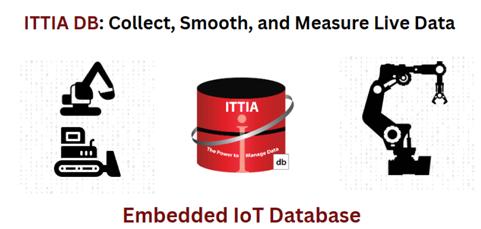
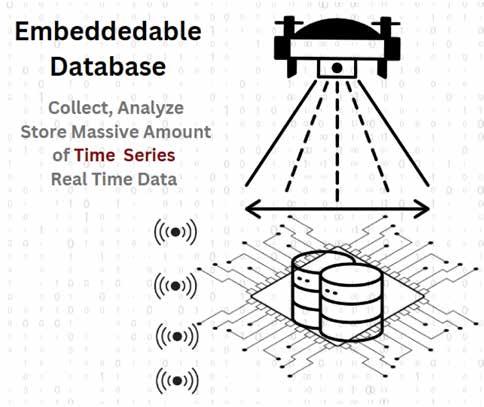
Through Hybrid transactional and analytical processing (HTAP), ITTIA DB architecture offers support for both transactional processing (OLTP) and online analytical processing (OLAP) workloads locally at the edge device. One engine supports both processing and transactions. Supporting HTAP offers several new opportunities for embedded IoT systems to extract value from data streams which are made possible by the unification of transactional and analytical data. HTAP is becoming a popular option due to the benefits of combining these two systems.
Sasan Montaseri, President, ITTIA.Visit Website
Three ways manufacturers can embrace Industry 4.0
Before Industry 4.0, OT devices and systems were “air-gapped” to isolate them from risk. That is not possible today. Industrial switches, media converters and wireless routers must feature robust, DoDcompliant layer 2 and layer 3 security that helps manage network traffic at scale.
GLOBAL SUPPLY CHAINS ARE BUCKLING under the strain of unprecedented demand and constricted logistics capacity. Added to skyrocketing inflationary forces, it is no wonder that an increasing number of OEMs are embracing Industry 4.0 to bolster enterprise efficiency by making their manufacturing more aware, predictive and autonomous.
The shift from Industry 3.0 to Industry 4.0 involves the convergence between information technology (IT) and operational technology (OT). Connecting OT systems to an IT network allows a more detailed view of individual equipment and creates a comprehensive view of the entire ecosystem, simplifying management and operation.
Besides allowing machines to be largely operated autonomously without human supervision, Industry 4.0 creates higher value when data collected from intelligent sensors and actuators connected to equipment leads to better decision making, as well as to the “learning” that is now possible with artificial intelligence (AI) and machine learning (ML). These benefits are compelling and explain the explosion of interest in Industry 4.0.
For OEMs, Industry 4.0 unlocks actionable data throughout the plant and beyond, improving operational awareness in manufacturing and maintenance processes. For example, automated assembly systems that once operated in data silos can connect to IT databases from purchasing, compliance and customer service departments, or to data from a Manufacturing Execution System (MES) and Enterprise Resource Planning (ERP) software to identify trends, detect bottlenecks and take advantage of emerging opportunities.
As another example, analyzing big data collected from sensors on the factory floor provides real-time visibility of manufacturing assets to facilitate predictive maintenance to minimize costly downtime. In this instance, machine learning algorithms detect and target faulty parts before they wear out, rather than wait until repair work is more expensive.
Besides gaining insights from a local shop floor, warehouse or assembly line, Industry 4.0 provides visibility into supply chains thousands of miles away where an OEM’s suppliers may be located. OEMs can be informed of where their assets are in the supply chain so they are in a better position to fulfill customer deliveries
in a timely fashion.
Historical supply chain data could be sent to the cloud for analysis, helping to create predictive models and develop conditionbased alerts. If a delay is detected, software will alert the OEM so that it can pivot in strategy.
Applying Industry 4.0
The Industry 4.0 megatrend is now being applied across a wide swath of industrial sectors where it is benefitting discrete and process manufacturing, petrochemical, mining, agriculture and other diverse segments poised for unprecedented growth. Antaira has identified three ways to embrace this exciting paradigm shift:
1. Artificial intelligence
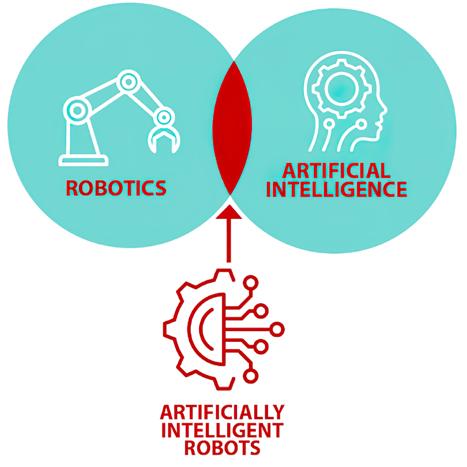
2. Network connectivity
3. Device cybersecurity
Artificial intelligence
AI is the simulation of human intelligence processes by computers to analyze data for correlations and patterns, and the use of these patterns to make accurate predictions about future states. AI is all around us. From agriculture applications that detect imperfections in fruits and vegetables during harvesting processes, to autonomous construction and farming machinery that use GPS technologies to navigate over predefined routes. Industry 4.0 uses AI to analyze sensor data to track equipment usage, improve workflows, streamline logistics, increase safety and achieve higher overall efficiency across OT and IT operations.
One promising category for AI is providing intelligence for autonomous robotics. Autonomous robots are increasingly finding their way into manufacturing operations.
AI-driven “cobots” reduce labor costs and increase productivity simply by continuously working around the clock without fatigue or breaks. In addition, safety is improved in hazardous environments, and insurance and injury leave costs are significantly reduced.
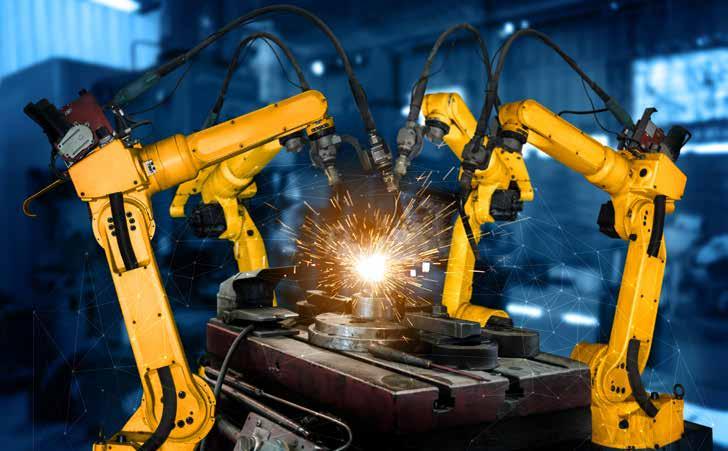
As AI continues to advance, problem-solving and learning analytics will enable autonomous robots to be responsive to their environment with minimal or no human feedback. To give you an idea of what that means, think of the thousands of manned forklifts operating today in warehouses and port terminals. Forklifts are labor-intensive, expensive to maintain and dangerous. As an alternative to a forklift, let’s say AI is applied to an automated guided vehicle (AGV). Freight is picked using a barcode reader. The AGV then automatically reroutes itself with the freight on board to the best path through the warehouse using wireless routers and industrial switches. Sensors assure no collisions occur with obstacles or employees.
Potential for autonomous robots using these devices are virtually endless. In the agricultural market, for example, Antaira industrial Ethernet switches are now being deployed in robotic fruit picking devices that can delicately grasp a single strawberry without bruising it. Antaira is also connecting and transmitting data in robots capable of automatically targeting and eliminating weeds using thermal energy while rolling through
agricultural fields. Also, Antaira industrialmanaged Ethernet switches are incorporated in an upgrade kit that transforms trench excavation equipment from the likes of Caterpillar, Volvo, Hitachi, Deere and Komatsu into autonomous robots operated remotely on a laptop.
Network connectivity
With the exponential growth of Industry 4.0 technologies, operational networks are continually going through expansion processes, requiring the same type of bandwidth allocations and infrastructure support as the enterprise network counterparts. Furthermore, as Industry 4.0 is trending toward an increased focus on AI for big data analytics and cloud computing for process and control information collection, connectivity and connection points have become a critical piece in the industry 4.0 puzzle.
Ethernet is the technology of choice for operational networks thanks to its standardization, versatility and low cost. An all-IP Ethernet infrastructure also helps to meet the imperatives of cybersecurity, determinism and system reliability. Thanks to these advantages, legacy technologies such as analog fieldbus systems are migrating to Ethernet, allowing for communications with modern technologies.
Ethernet thru TCP/IP-based communications now range from AI cloud-based processes to legacy bus systems that can interconnect the smallest application using just one twisted wire pair. In a recent development, the IEEE published a standard for 10 Mbit/s (IEEE 802.3cg) important to Industry 4.0 that allows transmission distances up to 3,280 feet, therefore holding the potential to replace virtually all fieldbuses currently in use.
One of the main components underpinning
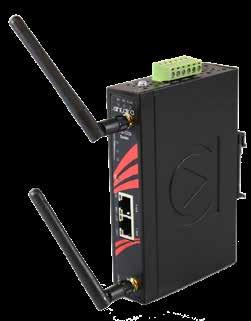
Ethernet connectivity is the Ethernet switch. Managed and unmanaged Ethernet switches are staples of Industry 4.0 architectures with the ability to transmit data between connected devices and wider networks in a way that is secure from outside threats.
While a basic Ethernet switch simply filters and forwards network packets from one networking device to another, industrial switches offer much more.
Device cybersecurity
The tools and software of Industry 4.0 are revolutionizing manufacturing. We are now seeing the Smart Interconnected Gigafactory that can monitor and control every facet of intelligent production processes. But just as these new technologies have created the opportunities for optimization, they have also introduced new risks and security threats, creating a completely different threat vector than PC-based networks.
Industry 4.0, for all its benefits, makes “Industry” an appealing target for cyberattacks. The expanded attack surface gives bad actors the opportunity to move laterally across a network, jumping across IT and OT systems for industrial espionage, intellectual property theft, IP leakage or even production sabotage. For this reason, cybersecurity best practices must be acknowledged as one of the pillars to a successful Industry 4.0 strategy. Adopting this risk-based security mindset includes:
• Recognizing that every connected device represents a potential risk, therefore,
you must maintain a real-time inventory of all OT assets and monitor the network for devices that have been added without authorization.
• Identifying and monitoring who can access devices. Implementing secure password policies that prioritize length over complexity will help prevent unauthorized network access.
• Taking a security-first approach to the deployment of any new connected devices. Require new devices go through verification before they can gain access to the network and proceed to communicate with other devices.
• Performing real-time vulnerability assessments and risk-based prioritizations to spot potential threats. Regularly scanning the network will identify suspicious communications or content, malicious software, improper access and any signs of access control manipulation.
• Fixing any outdated systems, unpatched vulnerabilities and poorly secured files.
• Implementing multi-factor authentication whenever possible.
• Segmenting networks and restricting host-to-host communication pathways.
• Ensuring that device suppliers commit to regular security and software patches and audits.
• Involving, not just informing, the C-suite of the cybersecurity process. Cybercriminals attack the low-hanging fruit,
meaning they will go looking for easy targets and then work their way deeper inside the perimeter.
In the case of Industry 4.0, the “low-hanging fruit” are your connected OT devices, especially those with decades-long life cycles, an inability to patch systems due to stability concerns and a lack of basic cybersecurity features such as user authentication or encryption. This threat environment has been further heightened by device vendors jumping into the industrial market from the IT space with little background into OT cybersecurity.
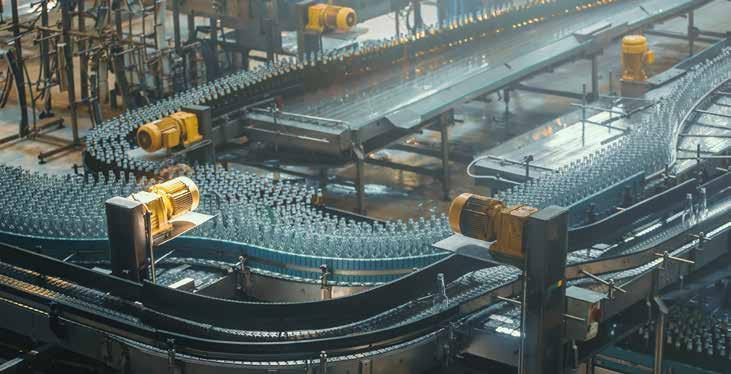
Before Industry 4.0, OT devices and systems were “air-gapped” to isolate them from risk. That is not possible today. Industrial switches, media converters and wireless routers must feature robust, DoD-compliant layer 2 and layer 3 security that helps manage network traffic at scale. And your NAT routers should be able to conceal the identity of an IP address block being used on a network.
The device manufacturer you work with should give administrators the tools they need to build on existing security policies and company standards, such as an authentication, authorization and accounting mechanism that can track user activities while limiting essential controls to employees who require them.
Henry Martel, Field Application Engineer,Visit Website
AI solution unleashes the full potential of shop floors

An intuitive, operator-centric platform leverages artificial intelligence to automatically optimise operations while maximising equipment monitoring, visibility and diagnostics. The future of manufacturing will be driven by data analytics offering unique actionable insights into the performance of machines as well as processes.
THE INNOVATIVE DATA
SCIENCE
TOOL, MELSOFT MaiLab (Mitsubishi Electric AI Laboratory) helps companies drive productivity improvements on manufacturing lines. The new solution offers an intuitive, operatorcentric platform that leverages artificial intelligence (AI) to automatically optimise operations while maximising equipment monitoring, visibility and diagnostics.
The future of manufacturing lies in highly efficient and responsive facilities. These are driven by next-level data analytics that provide unique actionable insights into the performance and status of machines as well as processes.
While the road to realising these smart factories is clear, companies are often missing the resources to get there. These include the budget for skilled data analysts and AI specialists along with the capability to effectively process large volumes of data as well as time available to develop accurate predictive models.
MELSOFT MaiLab acts as a dedicated virtual AI data scientist, helping companies to overcome these challenges and empowering them to realise future-oriented manufacturing strategies. Quick to deploy and with minimal training required, the solution bases recommendations and actions on intelligence derived from both live and historic data, without requiring users to have any specialist expertise.
In effect, the platform uses machine learning (ML), a subfield of AI, to automate data gathering across a variety of systems, predictive model creation, analysis and the mining of large volumes of data. As a result, the MELSOFT MaiLab software removes barriers to entry for Industry 4.0 applications driven by advanced data analytics, streamlining the implementation of strategies to improve production with a quick return on investment (ROI).
An intelligent assistant for quality-oriented manufacturing Ease of use start right from the installation, as the platform is accessed in a browserbased environment that does not require any additional software. It can run on any industrial PC, including Mitsubishi Electric’s MELIPC edge-computing solution.
Once installed, the MELSOFT MaiLab features an intuitive user interface with clear web-based visualisations. To further assist users without extensive programming skills, step-by-step guidance is provided. Also, the software helps users to understand what the data are suggesting while supporting them throughout all phases of a data analysis project. This is achieved by having the datasets being processed and analysis models created based on end goals selected by operators. In particular, these activities within the AI data science tool use Mitsubishi Electric’s proven Maisart AI (Mitsubishi Electric's AI creates the State-of- the-ART in technology).
Connected to the manufacturing system, the MELSOFT MaiLab was developed to support a wide range of different application scenarios and can also be tailored to each individual setup. More precisely, it can be used in off-line mode to feed existing empirical data to develop or refine suitable predictive models and customised using open Python scripts. The tool can then be used
for real-time diagnostics, providing the data generated as the production line operates to the algorithms and returning insights on the status of the line, its performance and how it can be optimised.
The platform can also offer additional information and functions to address the needs and requirements of various departments as well as subject matter experts (SMEs). In addition, the information being processed and produced is used to continuously increase the accuracy of its algorithms to enhance its outputs and help companies drive productivity over time, in line with futureproof continuous improvement strategies. Even more, flexible licensing schemes are also available to address the specific needs of a company. For example, these include yearly subscription models or one-off payment options.
Technology article by Mitsubishi Electric Europe.
Visit Website
What matters when it comes to choosing an Ethernet PHY
As digitalization progresses, ever greater volumes of data need to be exchanged constantly between devices and machines. Especially in industry, conventional communications technologies are running up against their limits, and Ethernet, or in this case Industrial Ethernet, is emerging as the new standard.
WITH INDUSTRIAL ETHERNET, VERY HIGH DATA rates in the gigabit range can be achieved over distances of up to 100 m, or even several kilometers if fiber optic cables are used.
Ethernet is an interface specification set forth in IEEE 802.3. One of the elements of IEEE 802.3 is the Ethernet physical (PHY) layer. It is a transceiver component for transmitting and receiving data or Ethernet frames. In the OSI model, Ethernet covers Layer 1 (physical layer) and part of Layer 2 (data link layer).

The physical layer specifies the types of electrical signals, signaling rates, media and connector types, and network topologies. The Ethernet PHY can be mapped onto it. The PHY forms the physical interface and is responsible for coding and decoding of data between a purely digital system and the medium on which the signals are transmitted. It thus represents a bridge between the digital and electrical connection levels of the interface.
The data link layer defines the way in which communication takes place over the medium and the frame structure for the transmitted
and received messages. This means it defines how the bits from the wire are arranged to enable the data to be extracted from the bit stream. With Ethernet, this is called media access control (MAC) and is found in the immediate vicinity of the PHY, but in the data link layer. The MACs are usually integrated into controllers or switches.
PHYs can be discrete components or can also be integrated into Ethernet controllers. A simplified block diagram showing the required Ethernet components and discrete PHYs can be seen in the figure above. If a design should be realized using discrete PHYs, a PHY should be selected with a few criteria in mind.
Important Criteria to Consider when Selecting an Industrial PHY
In industrial applications, the data transmission and the network must be highly reliable and fail-safe over a wide range of temperatures. This applies accordingly to all components.
Network Cycle Times: The network cycle time is the time it takes for the controller to collect
and update the data from the connected devices. A PHY with a low latency shortens the network cycle time and thereby improves the network update time, which is especially important for time critical applications. More devices can thus be connected to the network.
Susceptibility to Interference/Robustness: Operating environments in industrial applications are often harsh. A PHY must be able to withstand the prevailing external conditions because it is connected directly or via small magnetics to the cables, into which interference (radiated or conducted) can be coupled.
EMC standards such as CISPR 32 and IEC 61000-4-2 to IEC 6100-4-6 are yardsticks against which a PHY specification should be measured. Robust PHYs pave the way for certification and eliminate the usually tedious task of redesign.
Losses and Temperature Range
Devices for industrial applications are usually protected against dust and moisture ingress to IP65/IP66. This restricts the airflow available for cooling the electronics. At the same time, devices in industrial applications are often exposed to high ambient temperatures. In addition, for line and ring topologies, two Ethernet connections and thus two PHYs are required, so the PHY losses for data input and output are doubled. Thus, PHYs with low losses should be selected so that self-heating can be minimized.
Thomas Brand, Senior Field Applications Engineer, Analog Devices.Visit
WebsiteDigital data chain saves time and costs
The Digital Data Chain combines future-driven technologies offering an efficient exchange of data and information based on a uniform standard, on all levels, and with international validity. In the future, all of a plant’s components will be quickly identifiable via an ID Link using standard mobile devices.
MAKING PRODUCT DATA FOR PLANT COMPONENTS available digitally and at all times – that is the basic idea of the so-called Digital Data Chain (DDC).
Digital data chain
Siemens is a pioneer in mapping the entire digital data chain as the company has now supplied Bayer's Crop Science Division with several SITRANS P320 pressure transmitters with standardized ID links for unique object identification. In this way, the associated instance-specific, digital documentation according to VDI standard 2770 could be transferred directly to the ERP system used by Bayer.
"With the digital data chain, plant operators save a lot of time and money," said Axel Lorenz, CEO Process Automation at Siemens. "Currently, plant maintenance personnel spend most of their working time searching for relevant information."
"In the future, components at the field level can be identified quickly and reliably via mobile devices. At the same time, all information about the component is immediately available digitally – for example for operation or maintenance," he added
Manufacturer information on plant components crucial for operation
Various technical goods, plant components and equipment are used in process plants. For their correct planning, installation, commissioning, operation, cleaning, maintenance and servicing over the entire life cycle of the equipment, technical information is required that is contained in the original manufacturer's specifications.
This information can now be read out in the cloud in a standardized manner via a digital data chain and made available regardless of location. Behind the Digital Data Chain is the Digital Data Chain Consortium (DDCC), a cross-industry association of more than 50 companies in the process industry founded in 2021.
The aim is to create standards and platforms for the exchange of information among each other. In the future, all physical plant objects will be identifiable as an instance via a digital nameplate – for a lifetime and across all stages of the product life cycle.
Transfer all information to the ERP system via scan
Three technologies underlie the data consistency of the digital data chain: the automatic identification of plant components (according to IEC 61406-1), digital manufacturer information (according to VDI guideline 2770) for standardized data provision and a cloud-based information platform (IEP – Information Exchange Platform).
The minimum requirements for a globally unique identification of physical objects are specified in the international standard IEC 61406-1. Based on this standard, Siemens is delivering more and more devices with such an
ID link, which enables access to a cloud-based backend via which the product information is provided.
"The digital data chain makes it possible for manufacturer specifications of components to be transferred directly to the recipient's ERP during the scan in goods receipt," Lorenz said.
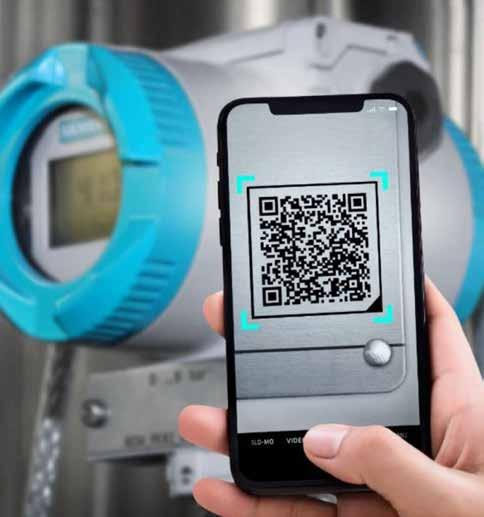
In addition to the SITRANS P320 pressure transmitter, Siemens has made further products DDC-compliant, such as the DQ 16 digital output module of the SIMATIC S7-1500 controller.
Technical article by Siemens.
Visit Website
Easy qualification of TSN solutions
Open source test tools for device and chip manufacturers offer numerous opportunities and possibilities for boosting the potential of real-time Linux and TSN. Test tools can help push forward broad acceptance of TSN, and ultimately make this future technology more readily available to all users.
THE LINUX OPERATING SYSTEM, ESPECIALLY with the PREEMPT-RT real-time extension, is already used in many automation devices and its popularity shows no signs of waning. The latest Linux versions now include mechanisms for TSN. The open PLCnext Technology ecosystem from Phoenix Contact is based on RT Linux, and TSN is supported on suitable Ethernet hardware.
The next consideration is whether this hardware can be tested uniformly under Linux and how this can be done in order to facilitate easy and high-performance integration into automation systems, such as PLCnext Control. Every Linux-based automation device essentially consists of the following components:
Hardware
The hardware includes the processor (CPU), the TSN-capable network interface(MAC), and the Ethernet line driver (PHY). It is the chip manufacturer who is responsible for the hardware.
Kernel
The Linux core function is executed in the kernel of the device. This function provides the basis for the uniform and deterministic behavior of all applications running under Linux. Access to the Ethernet interface is also realized in the kernel. This special part of the kernel is referred to as the network driver.
Network interfaces
This area makes the functionality of the Ethernet TSN hardware available to higherlevel applications.
Time-Sensitive Networking
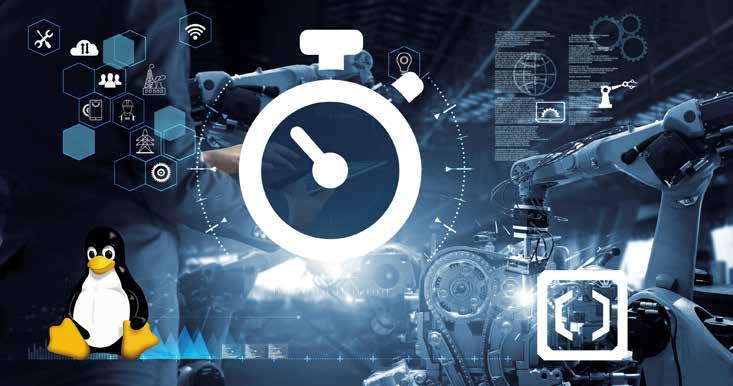
Industrial middleware
There are industrial transmission protocols that can be used with and without TSN. Profinet and OPC UA are two such examples. In the concept of “network convergence”, this type of middleware can also be used simultaneously in a network.
Application
This term refers to the relevant automation application. On a controller, for example, this could be the program for a filling or assembly plant. While a field device, for example, is used
Time-Sensitive Networking (TSN) is an initiative developed by the associated IEEE 802 standardization organization. The initiative focuses on deterministic Ethernet and its integration into the network chips of all relevant manufacturers. TSN does not represent a single standard, but rather a collection of mechanisms that relate to different areas. This enables automation providers like Phoenix Contact to develop TSN-capable devices using inexpensive and universal hardware. In the case of real-time-capable protocols, such as Profinet IRT, special Ethernet chips are still required.
to control digital and analog process signals. The control application communicates with the field devices via the respective middleware and the TSN network.
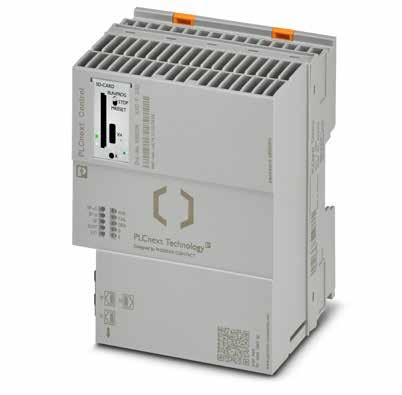
Synchronization
A key feature of TSN is the option for the highly accurate synchronization of applications. The acronym “Time-Sensitive Networking” clearly describes this feature. Synchronization allows distributed applications to run synchronously on controllers and field devices. The capability
for synchronization is already integrated in Linux. However, the TSN-capable hardware must support the necessary mechanisms for this. The level of accuracy that can be achieved depends on the corresponding implementation, but it can be significantly better than one microsecond (µs).
The latest kernel versions now include the use of Ethernet TSN mechanisms in RT Linux. This provides significant advantages for device manufacturers, who are able to develop a neutral TSN solution without the
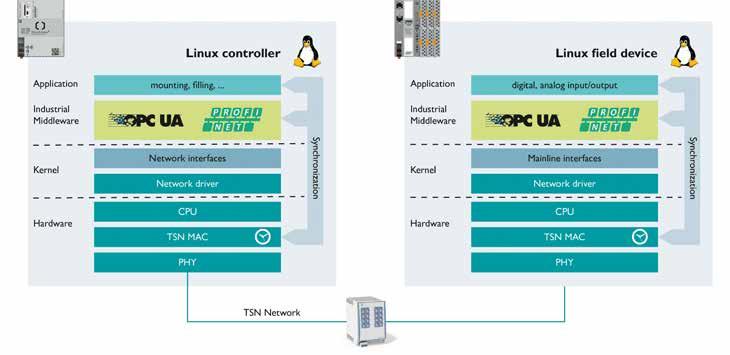
need for special hardware or software. The test environment presented here can be used to qualify these implementations, thus enabling the easy and robust use of TSN in Linux-based devices – for every manufacturer. This will contribute significantly to the widespread adoption of Time-Sensitive Networks.
Testing on widely used TSN-capable network chips
As illustrated in the figure above, it is no longer device manufacturers like Phoenix Contact who are responsible for TSN implementation under Linux; that responsibility now lies with the chip manufacturers. Therefore, the performance and quality of an automation device are only as good as the underlying TSN hardware and software. As a result, device manufacturers are now writing their own network drivers in order to ensure the required level of quality. In some cases, specific hardware is also required and this is implemented in FPGAs (Field Programmable Gate Arrays), for example.
These manufacturer-specific solutions are expensive and make it more difficult to change the underlying hardware during the lifecycle of a product. So the possibility of independently qualifying hardware and drivers from chip manufacturers before devices are developed and the hardware and application are set up is of particular interest to device manufacturers. The same is true for chip manufacturers who would like to test their TSN solutions without specific automation applications.
As all the necessary basic TSN functions have now been integrated into Linux, the need emerged for an independent test environment for TSN. With this in mind, Phoenix Contact has worked together with chip manufacturer Intel to develop appropriate test tools and test
them out on widely used TSN-capable network chips.
In the future, these test tools will be made available as an open source solution in a suitable organization for all interested parties. Chip and device manufacturers will thus be able to qualify their respective TSN products. Furthermore, the test tools can be used to compare different solutions or to familiarize customers or research organizations with the topic of TSN.
Highly accurate measurements of runtimes and deviations
For the independent qualification of a chip manufacturer’s TSN solution, the industrial middleware and the application are replaced by an emulation that uses the underlying hardware and its network drivers. The emulation behaves like an automation device and, following successful testing, it is later replaced by the manufacturer’s middleware and device application. The emulation consists of the following parts:
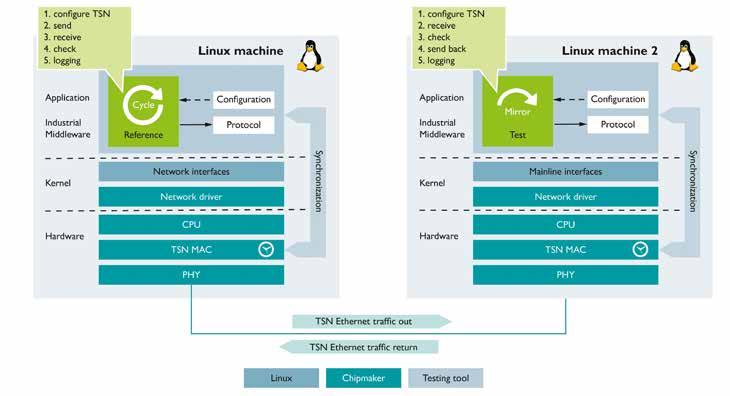
Reference
This test tool emulates cyclic real-time communication as well as acyclic network communication. Both can be configured in a wide range in a file. So, in addition to very short cycle times in the microsecond range, it is also possible to set the size and quantity of packets, for example. The reference part also checks received packets and measures the runtimes from application to application. In addition, the reference application uses the
special “Hackbench” tool to stress test the CPU. All the results are recorded.
Test
This tool receives the cyclic and acyclic communication from the reference part and sends it back. Certain values are also recorded.
Both the reference and the test application are synchronized with each other via the network by means of TSN mechanisms. This makes it possible to perform highly accurate runtime and deviation measurements.
Through close collaboration between Phoenix Contact, as a controller and device manufacturer, and a major international chip manufacturer, it has been possible to verify whether the test tools are working correctly during the actual development phase and to ensure the error-free implementation of TSN hardware and software. Furthermore, the TSN test tools enabled performance measurements in the microsecond range as well as optimizations. The test environment has thus demonstrated its capabilities.
Release as open source
Phoenix Contact and the chip manufacturer are currently discussing the open source release of the test tools. This release would enable more manufacturers to qualify their existing and planned TSN solutions, thus making the porting of TSN device software even easier and more reliable. As the TSN tools essentially work independently of any TSN middleware, they should be accessible to all interested parties. However, a sustainable solution needs to be
found for long-term maintenance. There are several options here, which will be announced publicly once they have been defined.
Following publication and widespread acceptance, Phoenix Contact anticipates a broad platform of TSN-capable solutions that can be used in its own products. Chip manufacturers will also benefit, as they will be able to use the test tools to qualify and improve their products. This in turn will lay the foundations for fair competition with regard to the best solution based on reproducible criteria. Open source TSN test tools ultimately provide scope for future extensions. For example, the possible integration of security encryption for TSN traffic or advanced test methods. In addition, it will be easy to accommodate any further development of the TSN standards.
Summary
Open source test tools for device and chip manufacturers offer numerous opportunities and possibilities for boosting the potential of real-time Linux and TSN. Phoenix Contact hopes that these test tools will achieve broad acceptance, as this will promote the widespread adoption of TSN in its own devices and devices from other manufacturers and will ultimately make this future technology more readily available to all users.
Gunnar Lessmann, Master Specialist Profinet and TSN, PLCnext Technology, Phoenix Contact Electronics GmbH.
Visit Website
Industrial AI application solutions
Compact industrial computer for factory automation, autonomous vehicles and automated optical inspection.
A new GPU edge computing solution with NVIDIA L4 GPU NVQual validation, the MIC-770 V3 Modular IPC with MIC-75M20 expansion i-Module, is compatible with the NVIDIA L4 Tensor Core GPU, boasts 7,424 CUDA cores and 24GB GDDR6 GPU memory; and consumes only 72W of power.
When paired with the efficiency of the NVIDIA L4 GPU, the high-performance highly scalable compact design of this IPC creates an excellent AIoT solution for diverse deep learning and edge inference applications in factory automation, autonomous vehicles, automated optical inspection (AOI), and AI prediction in medical equipment, as well as smart city video surveillance and transportation.
Key features
• NVIDIA Qualified system with NVIDIA L4 Tensor Core GPU
• Delivers 7,424 CUDA cores and 30.3 TFLOPS with 24GB GDDR6 GPU memory in 72W power envelope for edge AI and graphics applications
• 12th Gen Intel Core i9/i7/i5/i3 processors (LGA 1700)
• High-performance solution with compact ruggedized design & Flex I/O/iDoor expansions
• Supports Advantech iBMC 1.2 Remote Management Solution on WISE-DeviceOn
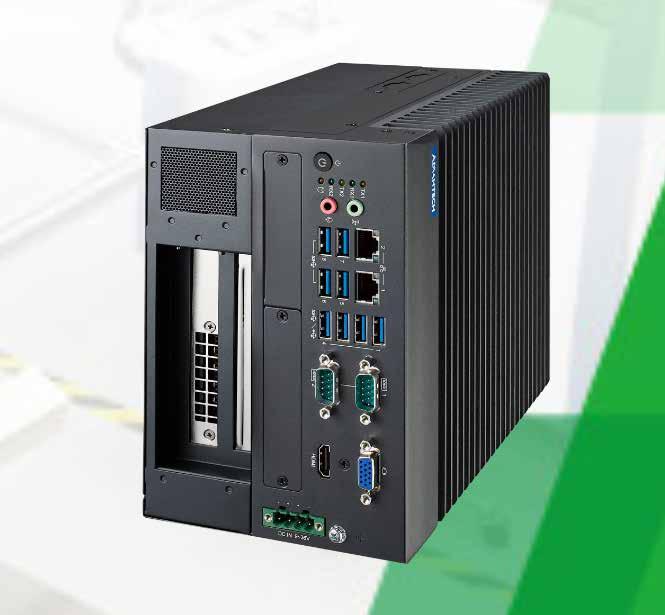
• Accommodates wide operating temperature and space-limited environments
High-performance compact design with flexible expandability
Powered by the latest 12th Gen Intel Core i processor, MIC-770 V3 is designed as a high-performance open-source x86 platform capable of enabling the quick development of GPU-accelerated solutions.
By Adopting MIC-75M20, a 2-slot expansion i-Module, this integrated solution is compatible with the NVIDIA L4 Tensor Core GPU with its small, energy-efficient, singleslot, low-profile 72W form factor.
These features make it ideal for AI-based edge computing and inference. It delivers energy-efficient universal acceleration for AI inference, video, and graphics applications; and is ideal for global deployment in enterprise, cloud, and edge applications with limited space.
Modular design enables diverse industry applications
MIC-770 V3 features a modular design that delivers enhanced functionality and flexibility
for PCIe expansion via Advantech i-Modules and Flex I/O in the front panel. Adding a PCIE-1674 vision frame grabber card enables the connection of 4 x cameras when used in autonomous vehicles.
Likewise, adding 4 x GbE Flex I/O (98910770301) enables this controller to connect to LiDAR systems, thus enabling it to detect distances and shapes in its environment then pass on data to the NVIDIA L4 GPU for the rendering of 3D models based on graphics analysis.
Remote management for seamless Edge AI computing
MIC-770 V3 supports the iBMC 1.2 Edge Intelligent Solution to simplify remote systems and edge device management. Indeed, by leveraging iBMC hardware-based out-of-band management technology, this WISE-DeviceOn solution can serve as both an in-band and out-of-band management system, enabling the comprehensive access, configuration, monitoring, and analysis & control of IoT network assets on a centralized platform.
In addition, Enterprise IT and OT managers can remotely control the power (via reset/ forced shutdown/power on/power off),
conduct remote system recovery via Acronis or hardware, trigger SSD recovery, and check operating statuses — even during software or OS failures. These features address 90% of system failures without requiring users to dispatch maintenance crews to the site, thus drastically reducing system downtime and operational costs.
Thermal Design offers stable and reliable GPU computing
The MIC-770 V3 leverages an NVIDIA L4 GPU and supports wide operating temperatures (0 ~ 40 °C) when used in harsh environments. It features a dedicated server-grade air duct design that improves the thermal management of the GPU. This cooling solution maintains a GPU IC operating temperature below 70.5°C in environmental conditions up to 40°C to deliver superior performance and clock frequency residency. In sum, MIC-770 V3 leverages its advanced thermal design to deliver 30.3 TFLOPs computing power with 72 watts of power consumption. Advantech
Functional safety over EtherCAT
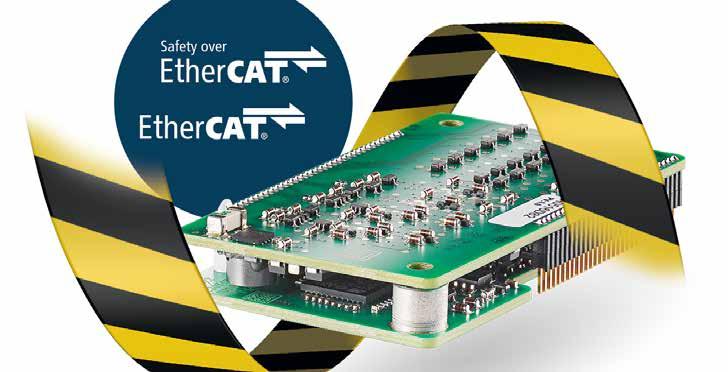
SafeT100 module allows users to implement safe I/Os for FSoE, Functional safety over EtherCAT.
Ixxat Safe T100 is an all-in-one safety solution which allows device manufacturers and machine builders to implement configurable, safe inputs and outputs in applications up to SIL 3 and PLe Cat.4.
The Safe T100 is designed to work hand in hand with Anybus CompactCom, also from HMS Networks. While Anybus CompactCom handles the standard non-safe communication with the EtherCAT network, the Safe T100 handles the safe communication, in this case over FSoE.
Thanks to the full implementation of the safe protocol and application layer in Ixxat Safe T100, device manufacturers and machine builders get a fast track to add functional safety capabilities to their equipment. A typical application for Ixxat Safe T100 is a safe emergency stop function for automation equipment such as drives, robots or process controllers.
Pre-certified and conformance tested solution
The Ixxat Safe T100 solution is pre-certified by TÜV Rheinland, and its conformity to the FSoE standard ETG 5100 V1.2.0 has been confirmed in the ETG test lab. This enables users to benefit from significantly reduced development time, cost, and risk when realizing safe devices and systems.
Since the Ixxat T100 works together with Anybus CompactCom, the end user will benefit
from a device or machine that provides both safe and non-safe functions via just one communication interface. This significantly simplifies configuration and project planning of the overall industrial automation system.
Key technical highlights
The Ixxat Safe T100 module features three two-channel inputs which can detect external wiring errors, and one two-channel output. The inputs and outputs all operate with 24 V signals.
All service and process data interfaces required for FSoE in the EtherCAT layer are available in the Anybus CompactCom module, such as control of the network and status LED, or transmission of the safe configuration data.
As an additional safety feature, the interface between the Anybus CompactCom module and the Ixxat Safe T100/FSoE is galvanically isolated. Other internal safety features include integrated temperature monitoring and shutdown to a safe state as well as channel-granular error signaling and error handling.
Scalable concept for FSoE, PROFIsafe and CIP Safety
The internal communication between the non-safe Anybus CompactCom and the safe Ixxat Safe T100 module is done according to the "black-channel" principle. Thanks to this clean separation between the safe and
non-safe communication layers, it is possible for customers to support all the three major safety protocols – FSoE, PROFIsafe and CIP Safety – with just one hardware design, adding further to the scalability and efficiency of the solution.
Customized implementation or OEM solutions
Thanks to the comprehensive implementation guidelines and user documentation, the Safe T100 module can be implemented by device manufacturers and machine builders themselves. However, HMS also supports customers with implementation services, as well as porting and certification services.
For specific requirements regarding e.g., form factor, plugs or number of I/Os, customer-specific versions of the Ixxat Safe T100 can be developed by HMS.
Ixxat Safe also offers
For applications where it is not possible to integrate the Safe T100 – e.g. due to limited space within safety encoders, or when already existing safety hardware limits the design flexibility – HMS also offers protocol stacks for Functional Safety over EtherCAT (FSoE), CIP Safety over EtherNet/IP and CIP Safety over Sercos, all pre-certified by TÜV.
WiFi Access point extends networks
ARS-7235-5E-AC-T builds stronger, more resilient wireless connections for industrial applications.
An industrial dual-radio wireless LAN access point optimized with added router capabilities securely extends connectivity to the evergrowing number of WiFi devices deployed on high-density plant floors.
Empowered by 802.11a/b/g/n/ac Wi-Fi and boasting ultra-reliable stability thanks to the embedded Qualcomm IPQ4029 SoC chipset, the Antaira ARS-7235-5E-AC-T accelerates data transmission speeds up to 867Mbps to facilitate uninterrupted access to a steady, strong wireless signal. Two adjustable MIMO antennas mitigate interference to allow IT professionals to squeeze every inch of reliable range from coverage.
The ARS-7235-5E-AC-T will add value in countless use cases including the enabling of remote monitoring and operation of machinery in harsh industrial environments, the providing of real-time access to WiFi sensors for machine diagnostics and troubleshooting, and supplying wireless connectivity to Autonomous Guided Vehicles (AGVs) and Autonomous Mobile Robots.
Its dual-radio (2.4GHz/5GHz) improves plant productivity by enabling multiple devices to concurrently tap into secure, high-speed
WiFi signals and automatically find the least congested channel. Five Gigabit Ethernet ports help customers future-proof their networks as they work to digitally transform their operations with next-generation smart sensors, IP cameras, and industrial IoT devices.
Another box the ARS-7235-5E-AC-T checks is compatibility with ConnectVPN, a cloudbased Virtual Private Network (VPN) developed
by Antaira for their wireless router series. ConnectVPN implements encrypted VPN tunnels and WiFi routing to securely configure, monitor, and collect data from connected remote devices.
Ethernet-APL capable field devices
ELX6233 EtherCAT Terminal for compact integration of Ethernet-APL into process control systems.
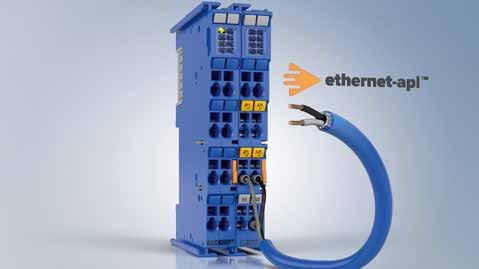
Ethernet-APL-capable field devices from the hazardous areas of zones 0/20 and 1/21 can be connected directly to the ELX6233 EtherCAT Terminal from Beckhoff. The combination of flexible EtherCAT system architecture and the extensive ELX portfolio now facilitates the integration of Ethernet-APL, HART, or simple digital signals in the same terminal segment.
The rise of digitalization, especially in the areas of plant diagnostics and monitoring, is currently one of the major topics in the process industry. Processing plants are generally very widespread and have particular requirements that are met by the specially developed standard Ethernet- APL, which offers a transmission rate of 10 Mbit/s and a cable length of up to 1,000 meters. When it comes to connecting corresponding field devices, the ELX6233 EtherCAT Terminal now offers a modular approach along with a whole host of associated advantages:
• Compact installation space
• High channel density
• Expandability and an adaptable number of channels to suit each application
• Simplified integration
• Improved cycle times
• Compatibility with all EtherCAT terminals and couplers
The ELX6233 supplies the sensors according to the SPAA (TS10186) port profile and integrates them into the system via PROFINET. Two APL ports are available for this purpose in the compact 24 mm terminal housing. This
allows the data from the connected sensors to be transmitted to the controller and to the higher-level process control system (DCS) via the ultra-fast EtherCAT communication.
Beckhoff Learn More
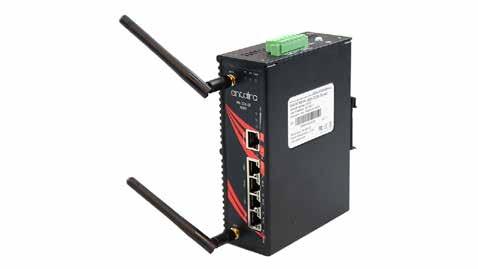
Fast, accurate AI-based inspections
High-speed, high-resolution system is ideal for high-speed industrial applications
The In-Sight 3800 Vision System is designed for high-speed production lines, In-Sight 3800 offers an extensive vision toolset, powerful imaging capabilities, and flexible software to deliver a fully integrated solution for a wide range of inspection applications.
“The In-Sight 3800 offers twice the processing speeds of previous systems, performing tasks like a quality inspection in as little as one-third of a blink of the eye,” said Lavanya Manohar, Vice President of Vision Products. “This added power allows users to maximize throughput and accommodate faster lines while delivering the high accuracy that they have come to expect from the In-Sight product line.”
IS3800-Eyeshadow-classification
This system is embedded with a comprehensive set of vision tools that includes AI-based edge learning technology and traditional rule-based algorithms. Easy-to-use edge learning tools solve tasks with high variability and are set up in minutes with just a handful of training images. Rule-based tools are well-suited to solve deterministic tasks with specific parameters.
In-Sight 3800 is powered by In-Sight Vision Suite software, a common platform across all In-Sight products, which offers both EasyBuilder and Spreadsheet development environments. The intuitive, point-and-click EasyBuilder interface guides users step-bystep through the development process, making it ideal for simple or common applications, while the robust spreadsheet interface enables
finetuning of job parameters for advanced or highly customized applications. “Flexible development options allow users to easily modify their application for new or changing requirements,” said Manohar.
SPE connectors offer USB 3.2
Learn More
IIoT connectivity with ultra-rugged solutions using Single Pair Ethernet and USB 3.2 protocols.
New Single Pair Ethernet and USB 3.2 products include (left to right): Fischer Core Series in size 102 with SPE 1 Gbit/s; Fischer UltiMate Series in size 07 with SPE 1 Gbit/s; Fischer MiniMax Series in size 08 with USB 3.2 Gen 1 for 5 Gbit/s, Gen 2 for 10 Gbit/s; Fischer MiniMax Series in size 10 with power and USB 3.2 Gen 1 for 5 Gbit/s, Gen 2 for 10 Gbit/s. With the increase in sensor density, actuators and controllers in Industry 4.0 and IIoT operational settings, high power levels and massive amounts of data must be securely and efficiently managed through ultra-fast transmission lines with cables running over long distances. Miniature connectors and cables are needed to interconnect smaller devices and sensors in areas that are sometimes confined and hard to access. And connectivity must be ruggedized to resist shock, vibration, extreme temperatures, water and corrosion when exposed to environmental and chemical conditions, indoors and outdoors.
To address these challenges, Fischer Connectors has developed new high-speed data and power connectivity solutions combining Single Pair Ethernet and USB 3.2 Gen 2 high-speed protocols with the rugged,
high-density and miniature features of its flagship product lines. They enable spacesaving and cost-efficient integration for industrial automation.
The Single Pair Ethernet solutions from the Fischer Core Series and Fischer UltiMate Series allow for 1 Gbit/s data transfer per IEEE 802.3bp - 1000Base-T1. Exceptionally rugged
by any market standards, they outperform other suppliers’ SPE solutions in terms of security, durability, as well as environmental and mechanical performance.
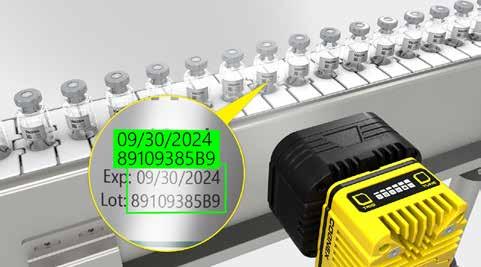
Fischer Connectors
Learn More
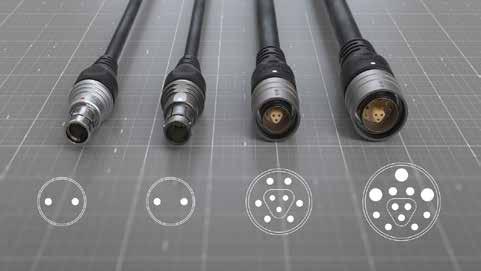
Industrial 5G solutions

Moxa showcased the company’s recent advances in industrial 5G solutions at Hannover Messe 2023.
The demonstration highlighted Moxa’s breakthroughs in tackling the complexity of Operational Technology (OT) and Information and Communications Technologies (ICT) convergence to realize private 5G networks for a wide range of industrial applications. With ultra-low latency and high-bandwidth connections, these dedicated cellular solutions provide the reliability and flexibility to address the dynamic requirements of different industries and improve industrial efficiency, productivity, and safety.
The demonstration focused on two use cases. The first case illustrated how its 5G onboard router enables train-to-ground (T2G) communications in a 5G network with Enhanced Mobile Broadband (eMBB), providing more than 1 Gbps throughput and Virtual Router Redundancy Protocol (VRRP) support for 50 ms recovery times with dual cellular tunnels. The second case showed how private 5G network solutions open up new opportunities for growth and one-of-a-kind solutions by combining various devices and industrial protocols such
as Modbus TCP/RTU, PROFINET, and OPC UA, enabling integrated data flows between remote I/O devices, serial device servers, Ethernet switches, and gateways for data collection and monitoring in smart manufacturing.
“With a proven track record of more than 20 successful private 5G proof-of-concept (PoC) and proof-of- business (PoB) projects in vertical markets including rail, manufacturing,
20-port TSN switch
warehousing and logistics, Moxa is well on track to becoming the world’s first to deploy a private 5G network for industrial automation at a high- end manufacturing site,” said Dr. David Chen, Director of R&D Center at Moxa.
Powerful and expandable embedded box PC for mission-critical IIoT applications at the edge.
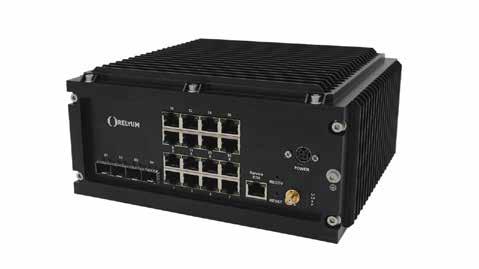
RELYUM announced the launch of a new TSN switch. The RELY-10TSN20, along with the 12-port version it launched a year ago, completes the RELY-TSN-BRIDGE family. The new platform incorporates the same hardware enhancements as the 12-port, such as a better processor or FPGA. It supports a configuration with 16 1Gbps copper TSN ports + 4x 1G/10Gbps fiber optic TSN SFP+ ports + 1x 1Gbps service port, providing flexibility to the end user.
Compatible with all TSN Standards
The switch includes a more powerful UltraScale MPSoC, to support the following TSN standards:
• IEEE802.1AS 2020: Time synchronization. Supporting two PTP domains
• IEEE 802.1Qbv: Time-Aware Scheduler
• IEEE 802.1Qav: Credit-Based Shaper
• IEEE 802.1CB: Frame Replication and Elimination for Reliability
• IEEE 802.1Qci: Per Stream Filtering and Policing
• IEEE 802.1Qcc: Stream Reservation Protocol (SRP) Enhancements and Performance Improvements
Additionally, this device includes other valuable mechanisms. Making use of SoC-e’s TSN technology, the RELY-10TSN20 supports optimized Mask and Match Stream Identification and PCP & DSCP prioritization.
RELY-10TSN20 is a series of products to be launched throughout 2023 that will incorporate different TSN features and TSN
speeds up to 10G. Thanks to the configurable technology of the FPGAs, these devices can be upgraded in the future with future releases of RELYUM switches.
Virtual Simatic controller
First virtual Simatic controller enables more flexible, software-based automation.
Siemens presented a complete virtual programmable logic controller (PLC) for the first time at Hannover Messe 2023. The Simatic S7-1500V expands the existing Simatic portfolio and meets special market requirements such as virtual hosting of PLC computing.
Highlights
• The Simatic S7-1500V is the first virtual controller from Siemens
• Expands the Simatic portfolio and is part of Industrial Operations X
• Ensures greater flexibility and scalability, and simplifies collaboration between IT and OT users
• Enables central management via Industrial Edge and is compatible with the Totally Integrated Automation (TIA) portfolio
Industrial Operations X
In the future, the company says that means the range will include both hardware controllers and the virtual PLC. The new Simatic S7-1500V is part of Industrial Operations X. This is a continuously growing, interoperable portfolio geared towards production engineering, execution, and optimization which Siemens is adding to its portfolios on Siemens Xcelerator – the open, digital business platform.
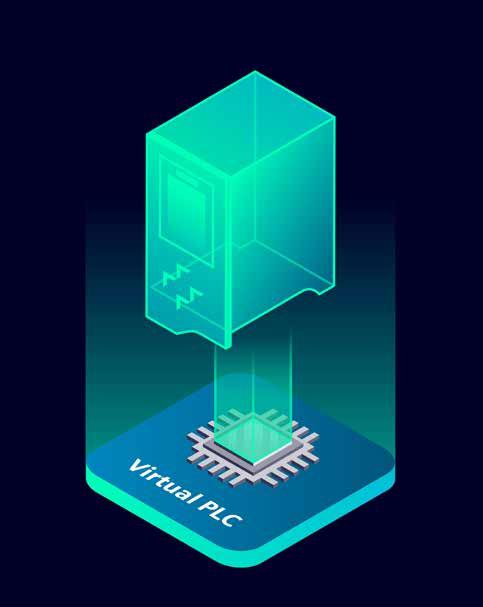
With Industrial Operations X, Siemens is consistently integrating IT and software capabilities into the world of automation, thus speeding up the transition from automated to highly adaptable production. After all, volatile markets, the labor shortage, and an increasing scarcity of resources all mean industrial firms have to structure their automated production more flexibly.
Benefits of the virtual PLC for industrial users
And that’s exactly what the new, virtual controller offers, since users can now also use proven functions of the S7-1500 hardware controller in the digital world. The virtual PLC is hardware-independent – in other words, no specific hardware is needed.
Industrial Edge Management makes it possible to manage the virtual controller and other applications at a central level and adapt them flexibly to customer application needs. Individual services can be booked and used in addition, so costs can be optimized. This kind of data-centered and software-based automation enables customers to respond more flexibly.
“If the service specialists are not in the factory at a given moment, they will be sent
a diagnostic message to say the controller has stopped, for example,” said Efrossini Tsouchnika, Vice President Control at Siemens. “The Industrial Edge Management System gives them the ability to access the virtual controller remotely. That means they can get the plant running again with no obstacles to action.”
Thanks to the virtual controller, PLC projects are easier to scale, and open data interfaces mean they can be readily integrated into other IT offerings. The Simatic S7- 1500V is fully compatible with the TIA portfolio. Customers can thus re-use projects and data already in the TIA Portal and reduce their level of investment.
Increasing convergence of IT and OT
Using the Simatic S7-1500V, Operational Technology (OT)-oriented users can continue to use their trusted structures while benefiting from the advantages of an IT-oriented environment. But users accustomed to IT can also work in a familiar environment using the digital controller. That simplifies the collaboration between automation engineers from the world of OT and software users in the IT field, and further advances the fusion of these two environments.
Siemens
Learn More
NextGen smart firewall
Enhanced perimeter defense solution simplifies network security for Distributed Control Systems.
The new NextGen Smart Firewall is a purposebuilt control system firewall designed to provide easy-to-install and easy-to-maintain perimeter security for all industries. More ruggedized construction, increased bandwidth, and role-based access provide users with increased performance and more granular access control.
Manufacturers need to secure their networks without complexity that would otherwise add administrative overhead to already busy operations teams. Emerson’s NextGen Smart Firewall features a user-friendly HTML5 web-based user interface, easy to understand setup menus, and pre-defined DeltaV application rules. The ease of use helps DeltaV administrators and control engineers with no security or information technology (IT) expertise create secure connections for DeltaV applications.
“A critical element of Emerson’s vision of boundless automation architecture is secure connectivity between systems in the plant and across the enterprise,” said Claudio Fayad, vice president of technology for Emerson’s process systems and solutions business.
Gigabit connections support improved
performance for applications that require higher bandwidth. Ruggedized construction is well suited for harsh manufacturing environments. Emerson’s NextGen Smart Firewall’s advanced features include:
• Virtual private networks – increasing flexibility and security for geographically dispersed networks
• Network address translation – protecting
network IP schemes and conserving addresses
• More granular user roles – administrators have full control, engineers may add or modify application rules, and auditors have read-only access to logs. Emerson
Full automation power for the DIN rail
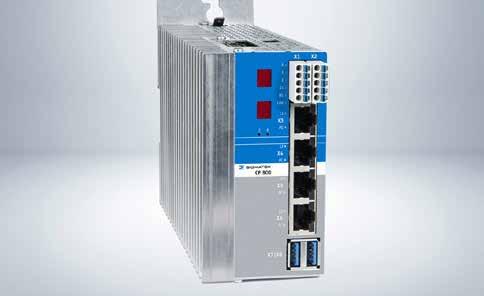
The new CPU unit CP 841 from SIGMATEK performs control, regulation and motion tasks.
With the new CP 841 CPU unit from SIGMATEK, any machine is ready for Industry 4.0. It is equipped with a high-performance Intel Celeron 6305E dual-core processor and therewith ideal for especially demanding and versatile control, regulation and motion tasks.
Internally, the standard version has 4 GB LPDDR4 RAM, 1 MB MRAM, an M.2 SATA SSD (128 GB) and a real-time clock (RTC) integrated. The 2x Gbit-Ethernet, 2x VARAN, 1x CAN, 2x USB 3.2 Type-A, 1x USB 3.2 Type-C Host interfaces and S-DVI expansion card, are easily accessible. S-DIAS I/O modules can be connected directly to the CP 841 via the bus interface on the side. Like all CPUs from SIGMATEK, this new edition also supports the OPC-UA communications protocol.
Through a well-thought-out cooling solution using a heat pipe, it can be operated without a ventilator (passive cooling via heat sink). Thanks to the robust technology and the exclusion of rotating parts, the CP 841 is also ideal for demanding industrial applications. Two 7-segment displays and 14 status LEDs for reading the actual operational state, as well as a Set and Reset button, are
integrated.
The CP 841 runs on the Linux-based real-time operating system Salamander 4. Modern automation solutions are developed and programmed using the object-oriented engineering tool LASAL, which provides high comfort and flexibility.
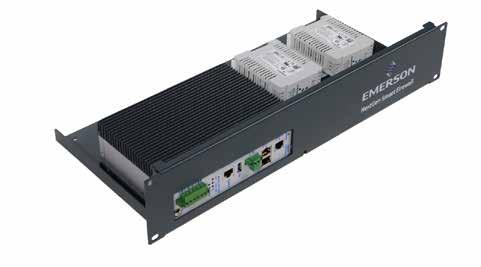
CP 841 dimensions : 60 mm width, 110 mm height (163mm incl. mount), 193.5 mm depth
Sigmatek
Learn More
Industrial Ethernet Book
The only publication worldwide dedicated to Industrial Ethernet Networking and the IIoT. Visit iebmedia.com for latest updates.
New website offers deepest, richest archive of Industrial Ethernet and IIoT content on the web.


View and/or download latest issue of Industrial Ethernet Book and past issues. Search our database for in-depth technical articles on industrial networking.


Learn what's trending from 5G and TSN, to Single Pair Ethernet and more. Keep up-to-date with new product introductions and industry news.

